MAKE WAVES WITH THIS FREE WEEKLONG VOCABULARY UNIT!


Strategies for Solving Word Problems – Math
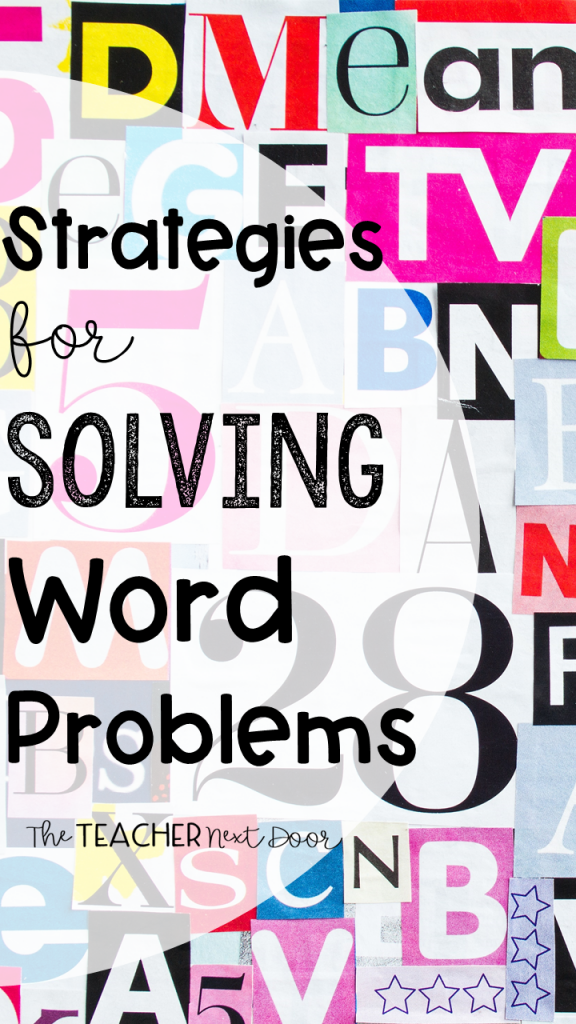
It’s one thing to solve a math equation when all of the numbers are given to you but with word problems, when you start adding reading to the mix, that’s when it gets especially tricky.
The simple addition of those words ramps up the difficulty (and sometimes the math anxiety) by about 100!
How can you help your students become confident word problem solvers? By teaching your students to solve word problems in a step by step, organized way, you will give them the tools they need to solve word problems in a much more effective way.
Here are the seven strategies I use to help students solve word problems.
1. read the entire word problem.
Before students look for keywords and try to figure out what to do, they need to slow down a bit and read the whole word problem once (and even better, twice). This helps kids get the bigger picture to be able to understand it a little better too.
2. Think About the Word Problem
Students need to ask themselves three questions every time they are faced with a word problem. These questions will help them to set up a plan for solving the problem.
Here are the questions:
A. what exactly is the question.
What is the problem asking? Often times, curriculum writers include extra information in the problem for seemingly no good reason, except maybe to train kids to ignore that extraneous information (grrrr!). Students need to be able to stay focused, ignore those extra details, and find out what the real question is in a particular problem.
B. What do I need in order to find the answer?
Students need to narrow it down, even more, to figure out what is needed to solve the problem, whether it’s adding, subtracting, multiplying, dividing, or some combination of those. They’ll need a general idea of which information will be used (or not used) and what they’ll be doing.
This is where key words become very helpful. When students learn to recognize that certain words mean to add (like in all, altogether, combined ), while others mean to subtract, multiply, or to divide, it helps them decide how to proceed a little better
Here’s a Key Words Chart I like to use for teaching word problems. The handout could be copied at a smaller size and glued into interactive math notebooks. It could be placed in math folders or in binders under the math section if your students use binders.
One year I made huge math signs (addition, subtraction, multiplication, and divide symbols) and wrote the keywords around the symbols. These served as a permanent reminder of keywords for word problems in the classroom.
If you’d like to download this FREE Key Words handout, click here:
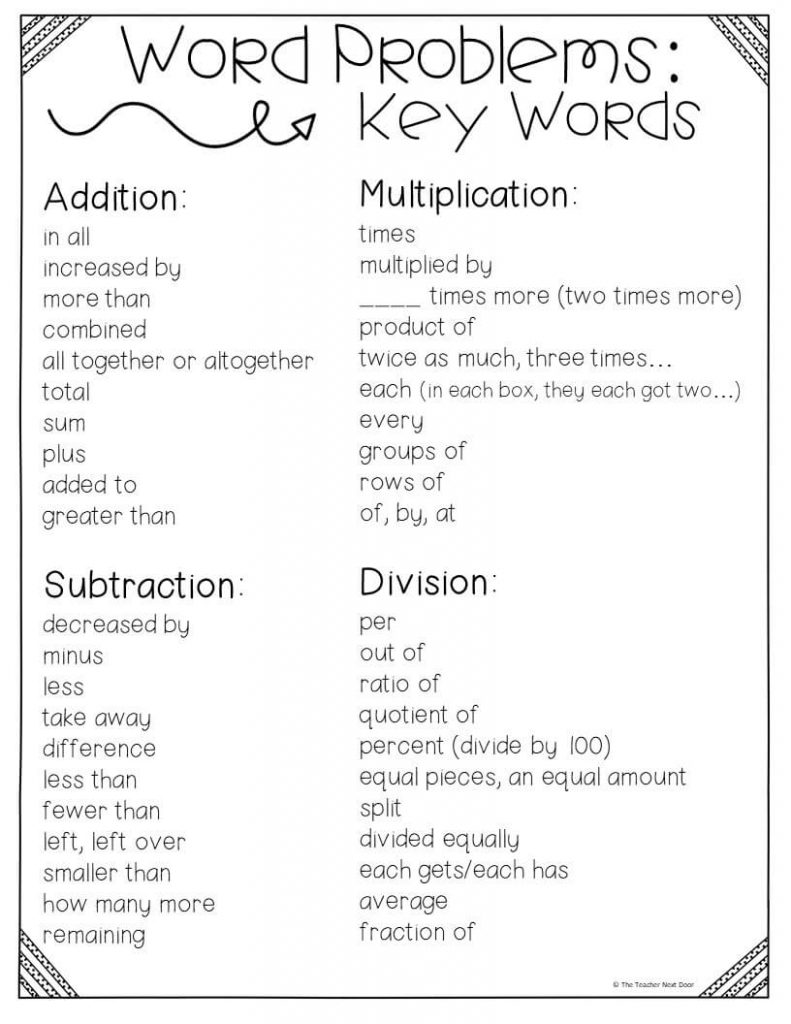
C. What information do I already have?
This is where students will focus in on the numbers which will be used to solve the problem.
3. Write on the Word Problem
This step reinforces the thinking which took place in step number two. Students use a pencil or colored pencils to notate information on worksheets (not books of course, unless they’re consumable). There are lots of ways to do this, but here’s what I like to do:
- Circle any numbers you’ll use.
- Lightly cross out any information you don’t need.
- Underline the phrase or sentence which tells exactly what you’ll need to find.
4. Draw a Simple Picture and Label It
Drawing pictures using simple shapes like squares, circles, and rectangles help students visualize problems. Adding numbers or names as labels help too.
For example, if the word problem says that there were five boxes and each box had 4 apples in it, kids can draw five squares with the number four in each square. Instantly, kids can see the answer so much more easily!
5. Estimate the Answer Before Solving
Having a general idea of a ballpark answer for the problem lets students know if their actual answer is reasonable or not. This quick, rough estimate is a good math habit to get into. It helps students really think about their answer’s accuracy when the problem is finally solved.
6. Check Your Work When Done
This strategy goes along with the fifth strategy. One of the phrases I constantly use during math time is, Is your answer reasonable ? I want students to do more than to be number crunchers but to really think about what those numbers mean.
Also, when students get into the habit of checking work, they are more apt to catch careless mistakes, which are often the root of incorrect answers.
7. Practice Word Problems Often
Just like it takes practice to learn to play the clarinet, to dribble a ball in soccer, and to draw realistically, it takes practice to become a master word problem solver.
When students practice word problems, often several things happen. Word problems become less scary (no, really).
They start to notice similarities in types of problems and are able to more quickly understand how to solve them. They will gain confidence even when dealing with new types of word problems, knowing that they have successfully solved many word problems in the past.
If you’re looking for some word problem task cards, I have quite a few of them for 3rd – 5th graders.
This 3rd grade math task cards bundle has word problems in almost every one of its 30 task card sets..
There are also specific sets that are dedicated to word problems and two-step word problems too. I love these because there’s a task card set for every standard.
CLICK HERE to take a look at 3rd grade:
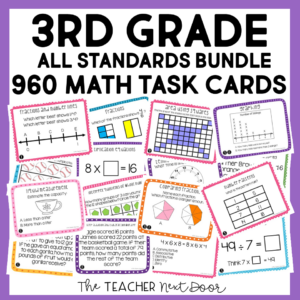
This 4th Grade Math Task Cards Bundle also has lots of word problems in almost every single of its 30 task card sets. These cards are perfect for centers, whole class, and for one on one.
CLICK HERE to see 4th grade:
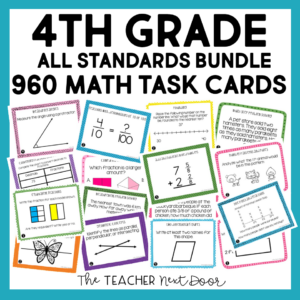
This 5th Grade Math Task Cards Bundle is also loaded with word problems to give your students focused practice.
CLICK HERE to take a look at 5th grade:
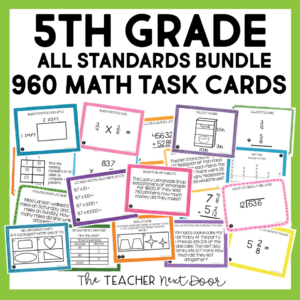
Want to try a FREE set of math task cards to see what you think?
3rd Grade: Rounding Whole Numbers Task Cards
4th Grade: Convert Fractions and Decimals Task Cards
5th Grade: Read, Write, and Compare Decimals Task Cards
Thanks so much for stopping by!

- Read more about: Math
You might also like...
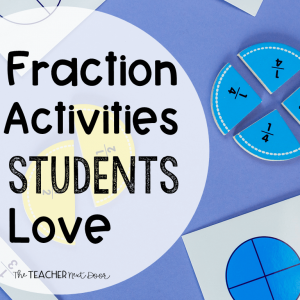
Fraction Activities Students Love – Math
Fractions can be tough! While it takes time and repeated exposure with fractions for students to have a real understanding of them, there are lots
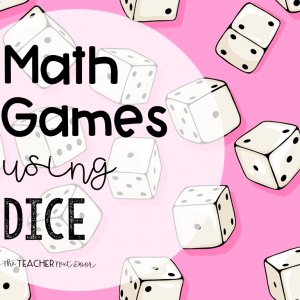
Math Games Using Dice
Games are an important part of math class, in my opinion. Not only are kids able to practice the skills that we have been focusing
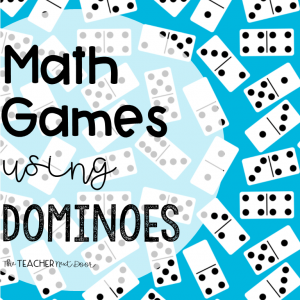
Math Games Using Dominoes
Math games have always been part of our math time. I love the fact that any time I introduce a math game, I know I’ll
Hi, I’m Jenn, CEO and owner of The Teacher Next Door!
I know that you strive to be an effective upper elementary teacher while maintaining a healthy work-life balance.
In order to do that, you need resources that are impactful, yet simple .
The problem is that most resources and curriculums out there are far from simple. The pages upon pages of daily lesson plans are just plain overwhelming .
At TTND, we believe teachers should be living their lives outside of the classroom, and not spend hours lesson planning and searching for resources.
We understand that now, more than ever, teachers need space to be themselves which is why we create and support teachers with timesaving tips and standards-aligned resources.
Want access to TTND's Free Resource Library? Sign up for our newsletter and we'll email you the exclusive password!
Trending posts.

SEARCH BY TOPIC
- Classroom Ideas
- Holidays and Seasonal
- Mentor Texts
- Reading Block
- Uncategorized
- Writing & Grammar
POPULAR RESOURCES

Facebook Group
Teachers Pay Teachers
Free Resource Library
💌 Contact Us
Disclosures
Privacy Policy
Refund Policy
Purchase Orders
Your Downloads
Reward Points
© The Teacher Next Door, LLC. All rights reserved.

* Please note: If your school has strong email filters, you may wish to use your personal email to ensure access.
- Math for Kids
- Parenting Resources
- ELA for Kids
- Teaching Resources

How to Teach Number Formation in 5 Easy Steps
13 Best Resources for Math Videos for Kids: Math Made Fun
How to Teach Skip Counting to Kids in 9 Easy Steps
10 Best Math Intervention Strategies for Struggling Students
How to Teach Division to Kids in 11 Easy Steps
Developmental Milestones for 4 Year Olds: The Ultimate Guide
Simple & Stress-Free After School Schedule for Kids of All Ages
When Do Kids Start Preschool: Age & Readiness Skills
Kindergarten Readiness Checklist: A Guide for Parents
How to Choose Best School For Your Kid: 12 Best Tips
15 Best Literacy Activities for Preschoolers in 2024
12 Best Poems About Teachers Who Change Lives
6 Effective Ways to Improve Writing Skills
40 Four Letter Words That Start With A
What Are the Stages of Spelling Development: Ultimate Guide
13 Best Online Teaching Tips for Teachers
How to Teach Kids to Write in 9 Easy Steps
13 Challenges for Teachers and How to Address Them
12 Best Qualities of a Good Teacher
15 Best Innovative Tech Tools for Teachers
10 Best Strategies for Solving Math Word Problems
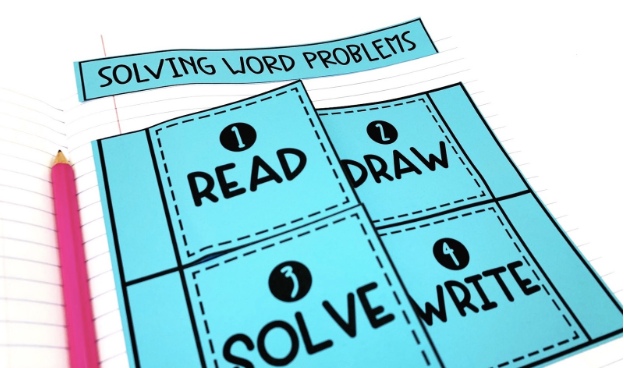
1. Understand the Problem by Paraphrasing
2. identify key information and variables, 3. translate words into mathematical symbols, 4. break down the problem into manageable parts, 5. draw diagrams or visual representations, 6. use estimation to predict answers, 7. apply logical reasoning for unknown variables, 8. leverage similar problems as templates, 9. check answers in the context of the problem, 10. reflect and learn from mistakes.
Have you ever observed the look of confusion on a student’s face when they encounter a math word problem ? It’s a common sight in classrooms worldwide, underscoring the need for effective strategies for solving math word problems . The main hurdle in solving math word problems is not just the math itself but understanding how to translate the words into mathematical equations that can be solved.
SplashLearn: Most Comprehensive Learning Program for PreK-5

SplashLearn inspires lifelong curiosity with its game-based PreK-5 learning program loved by over 40 million children. With over 4,000 fun games and activities, it’s the perfect balance of learning and play for your little one.
Generic advice like “read the problem carefully” or “practice more” often falls short in addressing students’ specific difficulties with word problems. Students need targeted math word problem strategies that address the root of their struggles head-on.
A Guide on Steps to Solving Word Problems: 10 Strategies
One of the first steps in tackling a math word problem is to make sure your students understand what the problem is asking. Encourage them to paraphrase the problem in their own words. This means they rewrite the problem using simpler language or break it down into more digestible parts. Paraphrasing helps students grasp the concept and focus on the problem’s core elements without getting lost in the complex wording.
Original Problem: “If a farmer has 15 apples and gives away 8, how many does he have left?”
Paraphrased: “A farmer had some apples. He gave some away. Now, how many apples does he have?”
This paraphrasing helps students identify the main action (giving away apples) and what they need to find out (how many apples are left).
Play these subtraction word problem games in the classroom for free:

Students often get overwhelmed by the details in word problems. Teach them to identify key information and variables essential for solving the problem. This includes numbers , operations ( addition , subtraction , multiplication , division ), and what the question is asking them to find. Highlighting or underlining can be very effective here. This visual differentiation can help students focus on what’s important, ignoring irrelevant details.
- Encourage students to underline numbers and circle keywords that indicate operations (like ‘total’ for addition and ‘left’ for subtraction).
- Teach them to write down what they’re solving for, such as “Find: Total apples left.”
Problem: “A classroom has 24 students. If 6 more students joined the class, how many students are there in total?”
Key Information:
- Original number of students (24)
- Students joined (6)
- Looking for the total number of students
Here are some fun addition word problems that your students can play for free:

The transition from the language of word problems to the language of mathematics is a critical skill. Teach your students to convert words into mathematical symbols and equations. This step is about recognizing keywords and phrases corresponding to mathematical operations and expressions .
Common Translations:
- “Total,” “sum,” “combined” → Addition (+)
- “Difference,” “less than,” “remain” → Subtraction (−)
- “Times,” “product of” → Multiplication (×)
- “Divided by,” “quotient of” → Division (÷)
- “Equals” → Equals sign (=)
Problem: “If one book costs $5, how much would 4 books cost?”
Translation: The word “costs” indicates a multiplication operation because we find the total cost of multiple items. Therefore, the equation is 4 × 5 = $20
Complex math word problems can often overwhelm students. Incorporating math strategies for problem solving, such as teaching them to break down the problem into smaller, more manageable parts, is a powerful approach to overcome this challenge. This means looking at the problem step by step rather than simultaneously trying to solve it. Breaking it down helps students focus on one aspect of the problem at a time, making finding the solution more straightforward.
Problem: “John has twice as many apples as Sarah. If Sarah has 5 apples, how many apples do they have together?”
Steps to Break Down the Problem:
Find out how many apples John has: Since John has twice as many apples as Sarah, and Sarah has 5, John has 5 × 2 = 10
Calculate the total number of apples: Add Sarah’s apples to John’s to find the total, 5 + 10 = 15
By splitting the problem into two parts, students can solve it without getting confused by all the details at once.
Explore these fun multiplication word problem games:

Diagrams and visual representations can be incredibly helpful for students, especially when dealing with spatial or quantity relationships in word problems. Encourage students to draw simple sketches or diagrams to represent the problem visually. This can include drawing bars for comparison, shapes for geometry problems, or even a simple distribution to better understand division or multiplication problems .
Problem: “A garden is 3 times as long as it is wide. If the width is 4 meters, how long is the garden?”
Visual Representation: Draw a rectangle and label the width as 4 meters. Then, sketch the length to represent it as three times the width visually, helping students see that the length is 4 × 3 = 12
Estimation is a valuable skill in solving math word problems, as it allows students to predict the answer’s ballpark figure before solving it precisely. Teaching students to use estimation can help them check their answers for reasonableness and avoid common mistakes.
Problem: “If a book costs $4.95 and you buy 3 books, approximately how much will you spend?”
Estimation Strategy: Round $4.95 to the nearest dollar ($5) and multiply by the number of books (3), so 5 × 3 = 15. Hence, the estimated total cost is about $15.
Estimation helps students understand whether their final answer is plausible, providing a quick way to check their work against a rough calculation.
Check out these fun estimation and prediction word problem worksheets that can be of great help:

When students encounter problems with unknown variables, it’s crucial to introduce them to logical reasoning. This strategy involves using the information in the problem to deduce the value of unknown variables logically. One of the most effective strategies for solving math word problems is working backward from the desired outcome. This means starting with the result and thinking about the steps leading to that result, which can be particularly useful in algebraic problems.
Problem: “A number added to three times itself equals 32. What is the number?”
Working Backward:
Let the unknown number be x.
The equation based on the problem is x + 3x = 32
Solve for x by simplifying the equation to 4x=32, then dividing by 4 to find x=8.
By working backward, students can more easily connect the dots between the unknown variable and the information provided.
Practicing problems of similar structure can help students recognize patterns and apply known strategies to new situations. Encourage them to leverage similar problems as templates, analyzing how a solved problem’s strategy can apply to a new one. Creating a personal “problem bank”—a collection of solved problems—can be a valuable reference tool, helping students see the commonalities between different problems and reinforcing the strategies that work.
Suppose students have solved a problem about dividing a set of items among a group of people. In that case, they can use that strategy when encountering a similar problem, even if it’s about dividing money or sharing work equally.
It’s essential for students to learn the habit of checking their answers within the context of the problem to ensure their solutions make sense. This step involves going back to the original problem statement after solving it to verify that the answer fits logically with the given information. Providing a checklist for this process can help students systematically review their answers.
Checklist for Reviewing Answers:
- Re-read the problem: Ensure the question was understood correctly.
- Compare with the original problem: Does the answer make sense given the scenario?
- Use estimation: Does the precise answer align with an earlier estimation?
- Substitute back: If applicable, plug the answer into the problem to see if it works.
Problem: “If you divide 24 apples among 4 children, how many apples does each child get?”
After solving, students should check that they understood the problem (dividing apples equally).
Their answer (6 apples per child) fits logically with the number of apples and children.
Their estimation aligns with the actual calculation.
Substituting back 4×6=24 confirms the answer is correct.
Teaching students to apply logical reasoning, leverage solved problems as templates, and check their answers in context equips them with a robust toolkit for tackling math word problems efficiently and effectively.
One of the most effective ways for students to improve their problem-solving skills is by reflecting on their errors, especially with math word problems. Using word problem worksheets is one of the most effective strategies for solving word problems, and practicing word problems as it fosters a more thoughtful and reflective approach to problem-solving
These worksheets can provide a variety of problems that challenge students in different ways, allowing them to encounter and work through common pitfalls in a controlled setting. After completing a worksheet, students can review their answers, identify any mistakes, and then reflect on them in their mistake journal. This practice reinforces mathematical concepts and improves their math problem solving strategies over time.
3 Additional Tips for Enhancing Word Problem-Solving Skills
Before we dive into the importance of reflecting on mistakes, here are a few impactful tips to enhance students’ word problem-solving skills further:
1. Utilize Online Word Problem Games
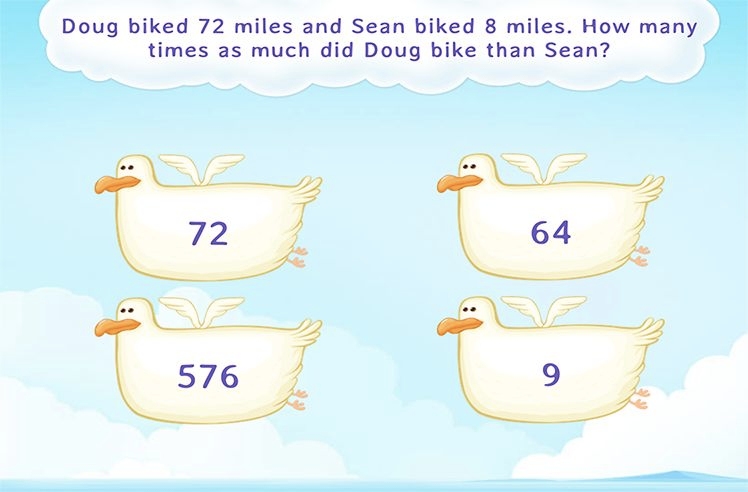
Incorporate online games that focus on math word problems into your teaching. These interactive platforms make learning fun and engaging, allowing students to practice in a dynamic environment. Games can offer instant feedback and adaptive challenges, catering to individual learning speeds and styles.
Here are some word problem games that you can use for free:

2. Practice Regularly with Diverse Problems
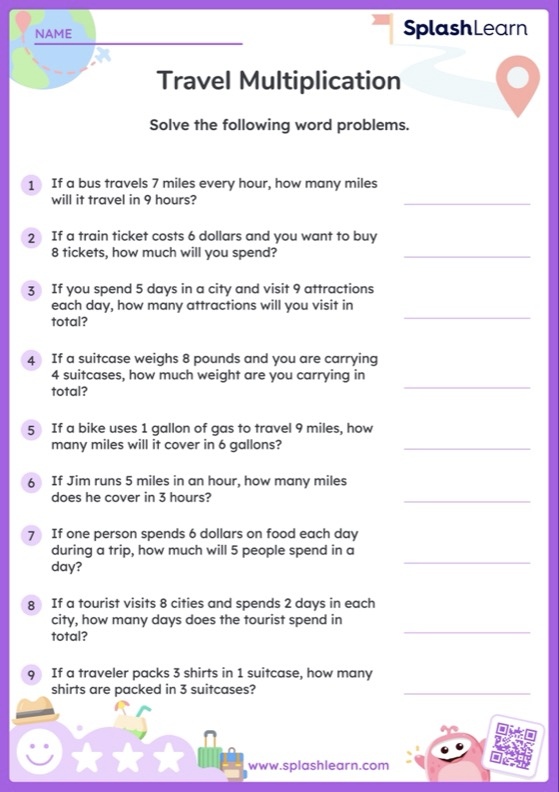
Consistent practice with a wide range of word problems helps students become familiar with different questions and mathematical concepts. This exposure is crucial for building confidence and proficiency.
Start Practicing Word Problems with these Printable Word Problem Worksheets:

3. Encourage Group Work
Solving word problems in groups allows students to share strategies and learn from each other. A collaborative approach is one of the best strategies for solving math word problems that can unveil multiple methods for tackling the same problem, enriching students’ problem-solving toolkit.
Conclusion
Mastering math word problems is a journey of small steps. Encourage your students to practice regularly, stay curious, and learn from their mistakes. These strategies for solving math word problems are stepping stones to turning challenges into achievements. Keep it simple, and watch your students grow their confidence and skills, one problem at a time.
Frequently Asked Questions (FAQs)
How can i help my students stay motivated when solving math word problems.
Encourage small victories and use engaging tools like online games to make practice fun and rewarding.
What's the best way to teach beginners word problems?
Begin with simple problems that integrate everyday scenarios to make the connection between math and real-life clear and relatable.
How often should students practice math word problems?
Regular, daily practice with various problems helps build confidence and problem-solving skills over time.
Most Popular

15 Best Report Card Comments Samples

101 Best Riddles for Kids (With Explanation)

40 Best Good Vibes Quotes to Brighten Your Day
Recent posts.

12 Best Communication Activities for kids of All Ages

15 Best Activities for Homeschoolers
Math & ela | prek to grade 5, kids see fun., you see real learning outcomes..
Watch your kids fall in love with math & reading through our scientifically designed curriculum.
Parents, try for free Teachers, use for free

- Games for Kids
- Worksheets for Kids
- Math Worksheets
- ELA Worksheets
- Math Vocabulary
- Number Games
- Addition Games
- Subtraction Games
- Multiplication Games
- Division Games
- Addition Worksheets
- Subtraction Worksheets
- Multiplication Worksheets
- Division Worksheets
- Times Tables Worksheets
- Reading Games
- Writing Games
- Phonics Games
- Sight Words Games
- Letter Tracing Games
- Reading Worksheets
- Writing Worksheets
- Phonics Worksheets
- Sight Words Worksheets
- Letter Tracing Worksheets
- Prime Number
- Order of Operations
- Long multiplication
- Place value
- Parallelogram
- SplashLearn Success Stories
- SplashLearn Apps
- [email protected]
© Copyright - SplashLearn

Make study-time fun with 14,000+ games & activities, 450+ lesson plans, and more—free forever.
Parents, Try for Free Teachers, Use for Free
Module 9: Multi-Step Linear Equations
Apply a problem-solving strategy to basic word problems, learning outcomes.
- Practice mindfulness with your attitude about word problems
- Apply a general problem-solving strategy to solve word problems
Approach Word Problems with a Positive Attitude
The world is full of word problems. How much money do I need to fill the car with gas? How much should I tip the server at a restaurant? How many socks should I pack for vacation? How big a turkey do I need to buy for Thanksgiving dinner, and what time do I need to put it in the oven? If my sister and I buy our mother a present, how much will each of us pay?
Now that we can solve equations, we are ready to apply our new skills to word problems. Do you know anyone who has had negative experiences in the past with word problems? Have you ever had thoughts like the student in the cartoon below?

Negative thoughts about word problems can be barriers to success.
When we feel we have no control, and continue repeating negative thoughts, we set up barriers to success. We need to calm our fears and change our negative feelings.
Start with a fresh slate and begin to think positive thoughts like the student in the cartoon below. Read the positive thoughts and say them out loud.

When it comes to word problems, a positive attitude is a big step toward success.
If we take control and believe we can be successful, we will be able to master word problems.
Think of something that you can do now but couldn’t do three years ago. Whether it’s driving a car, snowboarding, cooking a gourmet meal, or speaking a new language, you have been able to learn and master a new skill. Word problems are no different. Even if you have struggled with word problems in the past, you have acquired many new math skills that will help you succeed now!
Use a Problem-Solving Strategy for Word Problems
In earlier chapters, you translated word phrases into algebraic expressions, using some basic mathematical vocabulary and symbols. Since then you’ve increased your math vocabulary as you learned about more algebraic procedures, and you’ve had more practice translating from words into algebra.
You have also translated word sentences into algebraic equations and solved some word problems. The word problems applied math to everyday situations. You had to restate the situation in one sentence, assign a variable, and then write an equation to solve. This method works as long as the situation is familiar to you and the math is not too complicated.
Now we’ll develop a strategy you can use to solve any word problem. This strategy will help you become successful with word problems. We’ll demonstrate the strategy as we solve the following problem.
Pete bought a shirt on sale for $[latex]18[/latex], which is one-half the original price. What was the original price of the shirt?
Solution: Step 1. Read the problem. Make sure you understand all the words and ideas. You may need to read the problem two or more times. If there are words you don’t understand, look them up in a dictionary or on the Internet.
- In this problem, do you understand what is being discussed? Do you understand every word?
Step 2. Identify what you are looking for. It’s hard to find something if you are not sure what it is! Read the problem again and look for words that tell you what you are looking for!
- In this problem, the words “what was the original price of the shirt” tell you what you are looking for: the original price of the shirt.
Step 3. Name what you are looking for. Choose a variable to represent that quantity. You can use any letter for the variable, but it may help to choose one that helps you remember what it represents.
- Let [latex]p=[/latex] the original price of the shirt
Step 4. Translate into an equation. It may help to first restate the problem in one sentence, with all the important information. Then translate the sentence into an equation.

Step 6. Check the answer in the problem and make sure it makes sense.
- We found that [latex]p=36[/latex], which means the original price was [latex]\text{\$36}[/latex]. Does [latex]\text{\$36}[/latex] make sense in the problem? Yes, because [latex]18[/latex] is one-half of [latex]36[/latex], and the shirt was on sale at half the original price.
Step 7. Answer the question with a complete sentence.
- The problem asked “What was the original price of the shirt?” The answer to the question is: “The original price of the shirt was [latex]\text{\$36}[/latex].”
If this were a homework exercise, our work might look like this:

We list the steps we took to solve the previous example.
Problem-Solving Strategy
- Read the word problem. Make sure you understand all the words and ideas. You may need to read the problem two or more times. If there are words you don’t understand, look them up in a dictionary or on the internet.
- Identify what you are looking for.
- Name what you are looking for. Choose a variable to represent that quantity.
- Translate into an equation. It may be helpful to first restate the problem in one sentence before translating.
- Solve the equation using good algebra techniques.
- Check the answer in the problem. Make sure it makes sense.
- Answer the question with a complete sentence.
For a review of how to translate algebraic statements into words, watch the following video.
Let’s use this approach with another example.
Yash brought apples and bananas to a picnic. The number of apples was three more than twice the number of bananas. Yash brought [latex]11[/latex] apples to the picnic. How many bananas did he bring?
In the next example, we will apply our Problem-Solving Strategy to applications of percent.
Nga’s car insurance premium increased by [latex]\text{\$60}[/latex], which was [latex]\text{8%}[/latex] of the original cost. What was the original cost of the premium?
- Write Algebraic Expressions from Statements: Form ax+b and a(x+b). Authored by : James Sousa (Mathispower4u.com) for Lumen Learning. Located at : https://youtu.be/Hub7ku7UHT4 . License : CC BY: Attribution
- Question ID 142694, 142722, 142735, 142761. Authored by : Lumen Learning. License : CC BY: Attribution . License Terms : IMathAS Community License, CC-BY + GPL
- Prealgebra. Provided by : OpenStax. License : CC BY: Attribution . License Terms : Download for free at http://cnx.org/contents/[email protected]


No products in the cart.
- Strategies for Solving Word Problems
- Posted on March 6, 2024
- By Christine
- In Articles , Math
- Leave a comment

Solving word problems is a common challenge for many young learners. As an experienced educator and math enthusiast, I understand the importance of fostering effective problem-solving strategies that engage students and yield proven results. In this article, we’ll delve into some proven and creative strategies I use to help students solve word problems.
First and foremost, let’s review a few tried and true techniques for basic problem-solving before diving into some of our more creative strategies.
Read to Understand
Grasp what the problem is asking and the information it provides. Put yourself in the work problem and ask what you would do in that situation. You also check for understanding by asking questions like “What is the question asking me to do?” “What are some key words I recognize?” “What information do I have and what am I missing?”
Draw a Picture
Visualize the situation to make it more tangible and relatable. Drawing a picture helps you better understand and solve the problem.
Check for Reasonableness
Ensure your answer makes sense. Label your answer and verify if it addresses the question. If it seems far-fetched, double-check your work.
Now that we’ve reviewed the basics, let’s explore some more innovative strategies used to build math fluency and confidence.
Narrative-Based Problem Solving
Research indicates that weaving math problems into relatable narratives significantly enhances comprehension and retention. By framing problems within real-world scenarios, we can transform dry arithmetic exercises into thrilling adventures that capture children’s imaginations. This approach helps them visualize and internalize the mathematical concepts involved.
Multisensory Learning Techniques
Engaging multiple senses in the learning process has proven highly effective. Incorporating tactile elements, such as physical objects or manipulatives, provides a hands-on experience that enhances understanding. By allowing students to interact tangibly with math concepts, we bridge the gap between abstract problems and real-world application.
Collaborative Problem Solving
Encouraging collaborative problem-solving sessions fosters a dynamic learning environment. Working in pairs or groups allows students to share insights, discuss various approaches, and learn from one another. This not only enhances their problem-solving skills but also cultivates essential teamwork and communication skills.
Gamification of Math Word Problems
Research consistently highlights the positive impact of gamification on learning outcomes. Introducing math challenges, puzzles, or interactive games can transform dreaded math word problems into exciting quests. Gamification makes learning enjoyable and instills a sense of achievement, motivating students to tackle more complex problems with enthusiasm.
Mindfulness and Focus Techniques
Incorporating mindfulness practices helps students develop better concentration and attention to detail. Simple breathing exercises or short mindfulness sessions before tackling math problems create a conducive mental state for effective problem-solving. Research suggests that a calm and focused mind enhances cognitive abilities and analytical thinking.
An experienced educator will also be able to assess for any missing gaps in foundational math or literacy skills which may be impacting a student’s ability to solve word problems. Other cognitive skills like poor working memory may also be an important factor to consider and address. In conclusion, solving word problems doesn’t have to be an insurmountable challenge because there are many effective strategies that can be utilized. The team at Strategies for Learning can help, you Contact Us to learn more!
Written by Susan Ardila, M.A.
Schedule a free phone consultation
You can schedule a free initial consultation to learn more about our Educational Services. We will listen to your concerns, answer any questions, learn about the student’s needs, and help guide you through our new student intake process. Contact Us.
Share this:

IEP Red Flags and How to Fix it
Positive parent-teacher communication strategies.

Recommended Posts

How to find an Educational Therapist (What to look for and Questions to ask)

Summer IEP Prep

What is ALTA Certification? (Academic Language Therapists and Practitioners)

How Effective is 1:1 Academic Intervention? (infographic)
No comment yet, add your voice below!
Leave a Reply Cancel reply

A Blog for Moms, Teachers, and DIYers

The Best Word Problem Strategies that Build Strong Mathematicians
The best word problem strategies.
Ah, word problems. They are SO important for our students to understand, yet one of the most challenging parts of math instruction. Word problems are unique in that they are not JUST about math – they require reading comprehension, as well. Therefore, even students who excel at math can often struggle with word problems. As teachers, it can be difficult to know which word problem strategies to teach.
In this post, I am going to share some of the common strategies for teaching word problems and why they are or aren’t effective. I would also highly encourage you to check out this post , where I share ideas for reaching all your students in your word problem instruction.
Math Word Problem Solving Strategies
There are many word problem strategies out there, but some are more effective than others. Let’s take a look at some of the different strategies and whether or not they are beneficial.

Teaching Keywords in Word Problem Instruction
Growing up, many of us were probably told that certain words in story problems indicated a specific operation. For example, “more” means addition, “fewer” means subtraction, “each” means multiplication. And while often this is the case, sometimes it is not. For example, take the following problem:
Katie picked 4 apples fewer than Marvin. If Katie picked 12 apples, how many did Marvin pick?
In this problem, the word “fewer” is used. Normally this would indicate subtraction, but if you really look at what the question is asking, you will find that we actually need to add to solve. Because of this, the keyword strategy is not effective.
That being said, I personally believe the words and language used in a problem are still worth noting. The word “fewer” is still significant; the problem lies in assuming it automatically means subtraction. As a teacher, I always taught my students to pay attention to important words, but never taught them that certain words always mean a certain operation.
Instead of using the term “keywords,” I refer to them as “important words” or “context clues”. Because reading comprehension is a major part of solving word problems, we cannot entirely ignore the language used. I do think it’s worth taking the time to encourage students to look for certain words in problems, such as the words listed above. The important thing is that we do not tell them what to do with those words – only that they are important. More on this later, but I thought it was worth noting here.
Using Attack Strategies
Another common strategy for teaching word problems is what’s known as an attack strategy. Attack strategies involve a series of steps (or “plan of attack”) to follow when solving word problems. Common attack strategies include:
- RDW ( R ead the problem, D raw a model, W rite the equation)
- CUBES ( C ircle the numbers, U nderline the question, B ox the keywords/context clues, E valuate the problem, S olve & check)
- RUN ( R ead the problem, U nderline the question, N ame the problem type)
- FOPS ( F ind the problem, O rganize information with a diagram, P lan to solve the problem, S olve the problem)

There are many more – these are just a few examples. Attack strategies can certainly be helpful when used correctly. T hey are easy to remember and give students a clear plan for solving. Many attack strategies use fun acronyms like the ones listed above; however even strategies that do not spell out words can still be effective.
These strategies are effective largely because they focus on reading and understanding the problem first, and then solving. As we all know, many students like to simply pull out the numbers and start doing math instead of actually taking the time to read the problem. Attack strategies help solve that issue.
Numberless Word Problems
In 2014, Brian Bushart popularized the idea of removing the numbers from word problems. This is to help students understand what is actually happening in the problem. He details the process in this blog post , which is a GREAT read and I highly recommend checking it out (once you’re done reading this one!).

In short, numberless word problems are effective because they cause students to take a step back and really look at what the problem is asking. Eventually, of course, you’ll want to add the numbers back in. But starting out with the numbers removed and engaging in a discussion of what is actually happening in the problem is an effective first step in gaining comprehension.
Schema-Based Instruction
Of all the word problem strategies out there, schema-based instruction is the one with the most research backing it. Schema-based instruction (or SBI) involves categorizing word problems into particular types, or schemas, which will help you determine how to solve the problem.
Schemas can be additive or multiplicative. There are 3 main additive schemas: combine, compare, and change. Combine problems involve putting together two or more numbers to find a total. Compare involves finding the greater set, lesser set, or the difference. In change problems, an amount either increases or decreases over time.

Likewise, there are also 3 main multiplicative schemas: equal groups, comparison, and proportions. Equal groups involves a unit or group being multiplied by a specific number to find a product. In comparison problems, a set is multiplied a number of times for a product. The proportions schema focuses on the relationships among quantities.

The idea behind schema-based instruction is that all word problems fit into one of these schemas. Each schema has a unique graphic organizer and process for solving a problem that fits that schema. SBI is often accompanied with an attack strategy – such as RUN , for example. Students will first R ead the problem, then U nderline the questions, and finally N ame the problem type (schema) before solving. This last step of identifying the schema will help students understand how to solve the problem.
Part-Part-Whole Instruction
This isn’t really a strategy, per se. But, it is an important concept for students to understand in order to be successful with word problems. Understanding part-part-whole relationships is a critical aspect of number sense. My approach to teaching word problems involves a major emphasis on part-part-whole. Granted – I taught second grade, where word problems were mostly solved by addition and subtraction. Part-part-whole works with multiplication and division, too, but looks a little bit different.
My process for walking students through word problems always included having students identify whether each number represented a part or the whole, and which (a part or the whole) was missing. This was helpful because my students knew that a missing part means subtraction , and a missing whole means addition.

Identifying what each number represented is where the “keywords” I mentioned above come in. Words like “more,” “fewer,” and “each” – while they do NOT tell us how to solve – are important context clues to help us decide whether each number given is a part or the whole.
I used the CUBES attack strategy to go with this. However, instead of boxing “keywords,” we boxed “context clues”. Again, those words are still important – they just don’t tell us how to solve. The words are important because they tell us which numbers are greater or less than other numbers, or if a certain number represents a group. All are important things to know in determining the parts and the whole.
Once students identify what each number represents, they are able to solve. I’ve found that students who were correctly able to determine the parts and the whole in a word problem were VERY successful in finding the answer.

Free Training for Word Problem Strategies
Want to learn more about how to effectively teach word problems? I’m hosting a FREE video training series that you won’t want to miss! It’s launching THIS MONDAY, 9/21, so make sure you join the waitlist so you don’t miss out. Upon signing up, you will receive my free 30-page e-book for how to differentiate word problem instruction in your classroom. CLICK HERE TO JOIN THE WAITLIST , or sign up using the form below.
How do you teach word problems?

Share this:

You May Also Like

The Best and Most Practical Ideas for Task and Flash Card Organization

My 5 Favorite Fall and Halloween Preschool Art Activities

6 Dice Games for Math That Are Simple and Fun (+FREEBIE)
This article was incredibly helpful as a whole.
I do have a minor suggestion. Your font for the last graphic titled, “Tools for Teaching Part-Whole Relationships,” has a very confusing layout. I spent far too long trying to figure out what that first one with the abacus said and ended up relying on Google auto-fill. I don’t mind cursive in general, but a cleaner one might cause less confusion for those who homeschool or are looking to help our children in their school math and might not be familiar with that term. Even after Google’s help with auto-fill, I had to really look at that word as written to see how it was laid out in that font.
Andrea DeVico
I love your numberless problems and schema strategies. Could you share your e-book with me?
Leave a Reply Cancel reply
Your email address will not be published. Required fields are marked *
Notify me of follow-up comments by email.
Notify me of new posts by email.
WELCOME! Find what you need

Elementary Math

Elementary Ela-Reading

Teaching Tips

Career Exploration
How to teach math word problems – cubes math strategy.
Discover the power of the CUBES math strategy for understanding word problems! This step-by-step approach will boost comprehension and problem-solving skills and help students really understand story problems.
Are your students struggling to tackle word problems? Don’t worry; you’re not alone. Word problems can be overwhelming, especially for struggling students. But no worries, the CUBES math strategy is here to save the day!
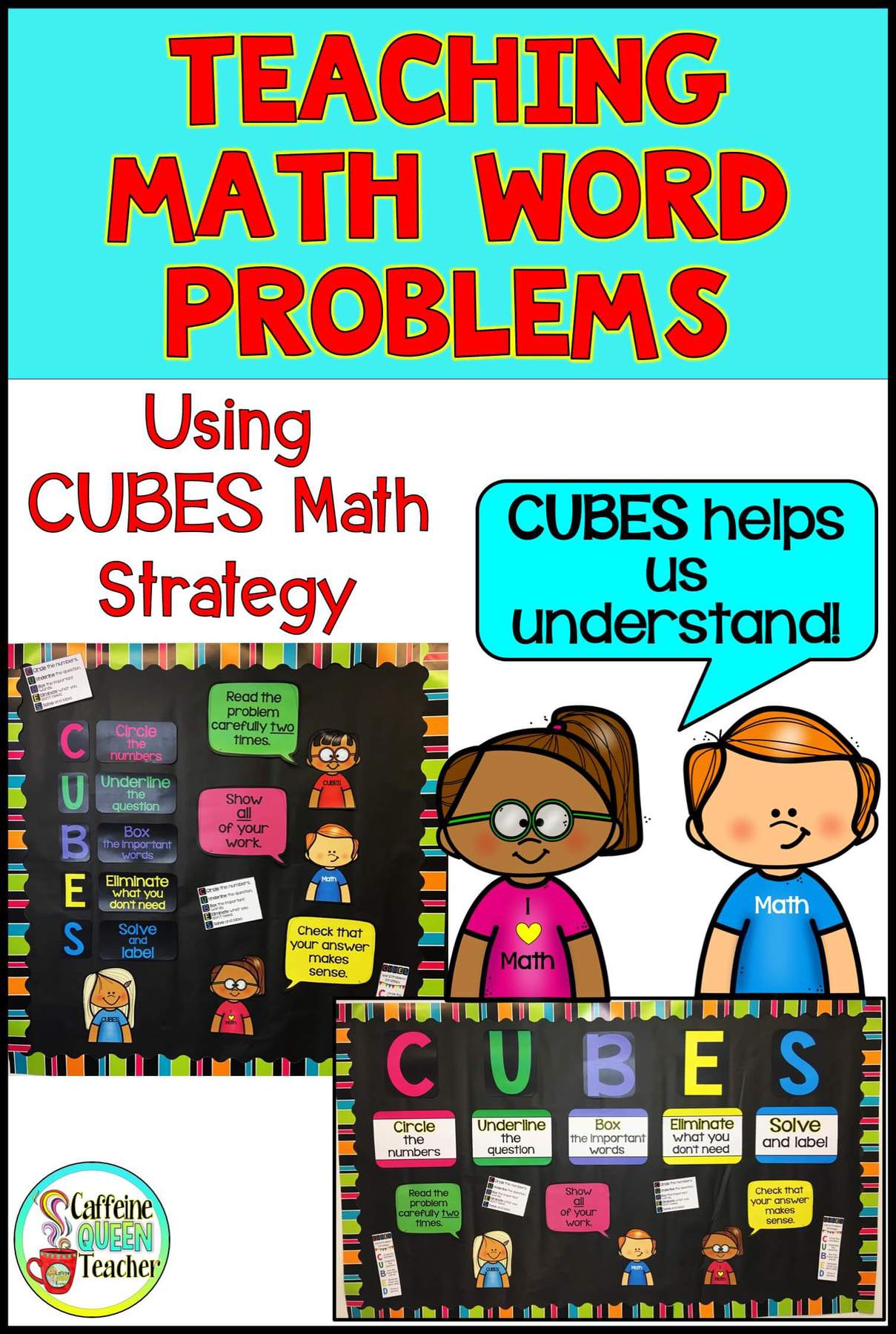
Math Word Problems
Word problems are a staple in math lessons for a reason – they reflect real-life situations. Sure, some problems may seem a bit ridiculous (like buying 60 watermelons – big eye roll here), but others offer valuable and meaningful learning opportunities.
The challenge lies in the variety and complexity of word problems. Upper elementary students run into super challenging multi-step problems that can leave them scratching their heads.
As a teacher, it’s essential to differentiate your instruction to meet the needs of all learners.
That’s where the CUBES math strategy comes in. By using this strategy, you can provide struggling students with a concrete step-by-step process to approach word problems. Say goodbye to frustration and hello to success!
Plus, this method slows students down and focuses their attention on one aspect of the problem at a time .
Many students rush through their work without really taking the time to read the problems and digest the meaning. The CUBES strategy helps students pause, reflect, and truly engage with the problem , leading to a deeper understanding and focus.
Incorporating the CUBES math strategy is easy.
Start by presenting the lesson to the whole class, but keep a close eye on your strugglers. Pull them into a small group to give them the extra support they need before they become overwhelmed by the assignment.
The greater the struggle, the smaller the group – at least, that’s the rule I try to follow.
CUBES Math Word Problem Strategy

Step 1: Read the problem out loud.
Read the problem aloud. Then reread it, emphasizing comprehension.
Students need to read or hear the problem multiple times before they even pick up a pencil to start. They need to visualize – what’s happening in the problem?
Here’s the clincher – don’t let them off the hook! Make them state out loud what they understand from the problem.
Keep in mind that sometimes students can’t explain the problem because they genuinely don’t understand what is happening.
My low readers often don’t digest the information as they read.
Word problems call on many skills: comprehension, sorting out needed and unneeded information, deciding on the operation, etc.
It’s hard for students to organize their thoughts at this point – but that’s exactly what we need them to do. And that’s precisely why they must read and reread the problem until they understand what’s happening.
I constantly tell my students that I, personally, have to read word problems several times before I understand them. My strugglers often don’t even want to read the problem once.
Break the problem down sentence by sentence if needed.
Allow think time so they can fully understand the problem and the steps.
* Unfortunately, that’s the problem for us as teachers. All the reading and discussion takes time – very valuable time. It also takes practice and patience.
I often adjust or differentiate assignments by giving my struggling crew fewer problems to complete.
Focus on a few problems done correctly rather than several incorrect ones rushed through.
Step 2: Circle the numbers AND LABELS!
Moving on to step two, I’ve learned that labels play a crucial role in comprehension. For that reason, I instruct my students to circle the numbers AND the labels at the same time . That saves time at the end when they need to label their answer.
Step 3: Underline the question
Step three is all about underlining the question and making sure students truly understand it. Challenge them to rephrase the question in their own words. This step is vital for selecting the correct operation and solving the problem effectively.
You may need to backtrack and reread the problem again, emphasizing the question.
That’s when we have the part versus the whole discussion. What information are we given? Do we have part of something, or is it a whole/total amount?
If a student truly doesn’t know what he’s looking for, they can’t choose the correct operation needed to solve the problem. A discussion needs to continue for understanding.
Step 4: Box the keywords
Be careful with keywords in word problems – they can be tricky! Some keywords have multiple meanings and can represent different operations. To solve the problem correctly, students must understand the context.
It’s normal for students to ask for hints and clues when identifying the necessary operation(s). However, it’s important to let them struggle a bit to boost perseverance and critical thinking skills.
Step 5: Eliminate unnecessary information
This step requires practice because students often struggle with eliminating unnecessary information. I ask students to draw one line through the information so they can still read what they crossed out. Otherwise, students may cross out needed information and then erase so hard they tear the paper.
Some students eliminate too much, while others think everything is necessary. This step takes time and really tests their comprehension and critical thinking skills.
Step 6: Draw a picture
Drawing a picture or representing the problem with a table, array, or tally marks helps students visualize the problem. Concrete manipulatives are also helpful and should be available to students who need to hold or manipulate items.
Quick sketches or other visual aids like tables, arrays, or tally marks are good enough. Remind them not to get too caught up in drawing a masterpiece and lose focus.
Step 7: Determine if the problem is multi-step
Students can feel confused when encountering multi-step problems. Numbering the steps by writing a 1, 2, 3, etc., near the first step of the problem helps them stay organized.
You may also have to encourage students to keep working through the problem. Often students complete only one step and expect to be finished.
It’s essential to emphasize that as they progress, their problems become more challenging, and they’ll have more than one step.
Step 8: Solve
Finally, students must do the actual calculations to solve the problem.
It’s a lot to hand, but you can read and learn more below.
Want to learn more about CUBES Math Word Problem Strategy?
Click HERE to read another blog post about CUBES and CUBED posters and resources.
The more you explore, the more beneficial it will be!
Interested in additional CUBES Math Word Problem Strategy resources? Visit our Teachers Pay Teachers store for more options.
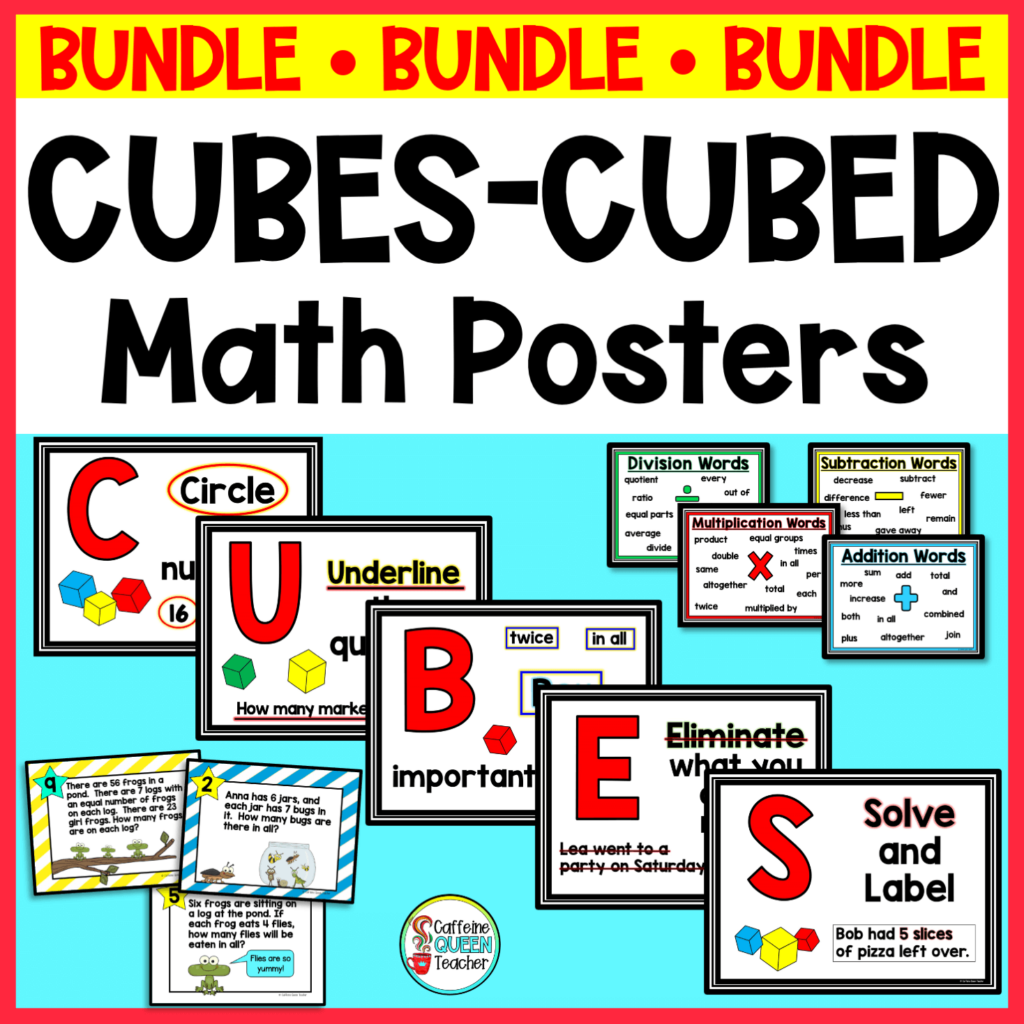
Maybe much of this is a simple review for you, but I hope that maybe there was even one little idea that got you thinking a bit more deeply about word problems in your own classroom.
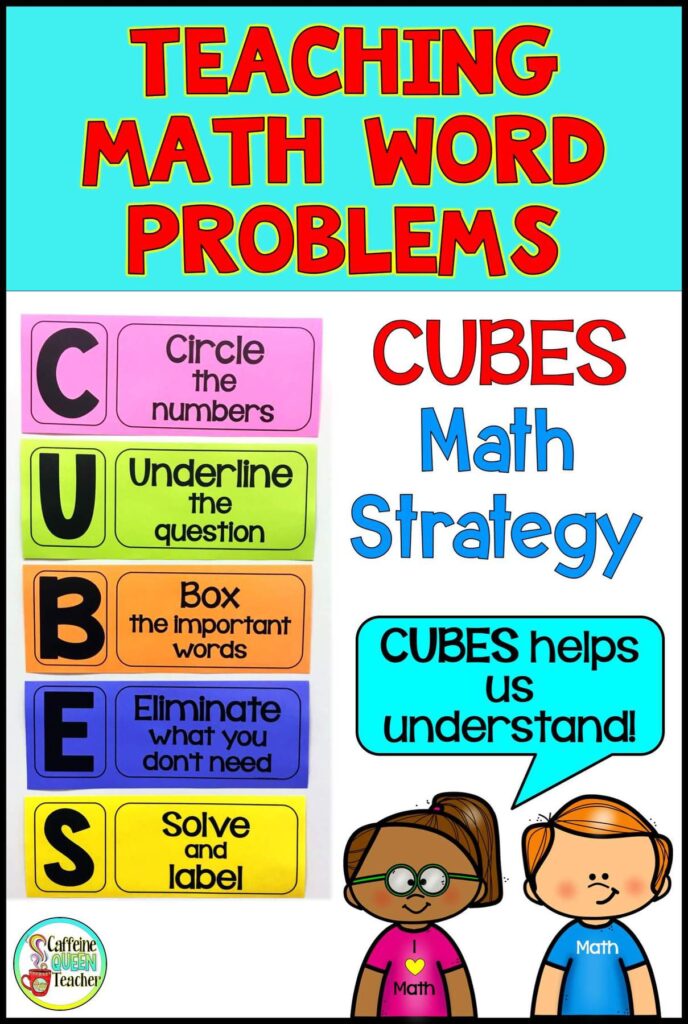
**There are other strategies and sets out there similar to these posters. Still, I love the CUBED (with the letter “D”) strategy best because of the emphasis on Common Core to have students represent math problems with pictures or drawings (Drawings = D in the CUBED strategy).
Discover how effective graph paper for addition and subtraction practice can be.

This proven method ensures students’ work remains neat and organized, leading to improved accuracy. These sets are a win-win for both students and educators!

Hi, I’m Jules
Find it fast, browse the blog, visit my teachers pay teachers shop.


3 Word Problem Solving Strategies To Improve Word Problem Performance
This post contains affiliate links. This means that when you make a purchase, at no additional cost to you, I will earn a small commission.
The ability to solve word problems doesn’t necessarily come easily to all students. We can improve our students’ ability to solve story problems with a few simple word problem-solving strategies. When it comes to comprehending, understanding, and solving word problems, sometimes it is helpful to move beyond traditional word problems and try a new word problem type that is designed to support students in tackling these tricky skills!
In order to solve word problems, students need to be able to:
- Comprehend the action or context of a word problem
- Understand the question or missing piece of information
- Develop a mathematically sound plan for solving for the missing information.
- Accurately calculate to find their solution.
It’s a balance between comprehension, an understanding of math concepts, and an ability to carry out math concepts. Identifying which of these steps are strengths or needs for your students can help you to choose a strategy that will best improve their word problem performance.
Word Problem Solving Strategy #1: Numberless Word Problems
Who is this strategy for? If your students are struggling to understand the action, context or question in a story problem, discussion and numberless word problems will be a word problem-solving strategy that can help your students tremendously! This strategy also helps your “number pluckers” who see numbers, pluck and add together regardless of context! Numberless word problems slow your students down!
Using a tool such as numberless word problems can help your students in their understanding precisely because the numberless word problem strategy emphasizes discussion every step of the way!
How do I use this strategy? As you solve numberless word problems you begin with a problem with no numbers at all and ask a variety of questions as you discuss and slowly add information back into the problem.
Reagan picked flowers for a bouquet! She picked both roses and carnations.
When you initially present the problem, ask your students questions such as
- Who is the story problem about?
- What is happening in this story?
- What are you wondering about?
Reagan picked flowers for a bouquet! She picked 7 roses and also some carnations.
- What new information do we have?
- What do you think we might learn next?
- What *could* be the number of carnations in the bouquet? What might make sense?
Reagan picked flowers for a bouquet! She picked 7 roses and 8 carnations.
- What new information do we know?
- What do you know about the story?
- What happened in the story?
- Could we draw a picture or diagram to match the story?
- What might we be wondering about the bouquet?
- What questions could we answer about the bouquet?
Reagan picked flowers for a bouquet! She picked 7 roses and 8 carnations. How many flowers are in the bouquet in all?
- What is the question wondering?
- Do we have enough information to answer that question?
- Where do we see the 7 roses in our diagram?
- Where do we see the 8 carnations in our diagram?
- How can we use the diagram to answer the question of how many flowers are in the bouquet in all?
DONE FOR YOU NUMBERLESS WORD PROBLEMS
Kindergarten | 1st Grade | 2nd Grade | 3rd Grade | 4th Grade
Word Problem Solving Strategy #2: Guided Visual Models
Who is this strategy for? Visual models help your students to organize the information they know as well as to visualize the missing piece of information. Drawing visual models helps lead your students to an equation. This strategy is ideal for students who understand what a word problem is asking but have difficulty connecting the action of a word problem to an equation.
A visual model might include:
- A math drawing (simple circles or an organic representation)
- A number bond (number bonds can be used beyond addition and subtraction! Adding more “parts” can help to visualize multiplication and division as well!)
- Tape diagrams
How can I use this strategy? As you are supporting your students in using these visual models, continually ask questions and draw connections between the word problem and their diagram.
Frank built a tower using 16 blocks. He took 7 blocks off of his tower and gave them to Declan so he could build a tower as well. How many blocks does Frank have left?
- Could you draw a picture that shows what happened?
- Frank had 16 blocks. Was that all of the blocks in the story or part of them? Where would we put the total in our number bond?
- Frank gave away 7 blocks. Was that all of the blocks or a part of the blocks? Where would we put the part in our number bond?
- And we’re wondering how many blocks Frank has left. Where is the missing part in our number bond? Could we write a question mark in that part?
If your students are familiar with number bonds or tape diagrams, knowing that they are missing a part will lead them to writing a subtraction equation or a missing addend addition equation to solve.
**If your students are not familiar with how to find a missing part or missing whole in an equation this is a topic that needs to be addressed as well! Your students are missing foundational math understandings that are critical to their word problem-solving strategy. Additional practice with both fact families and missing numbers in an equation will be helpful to your students!
Word Problem Strategy #3: Problem Sorts
Who is this strategy for? This strategy is for ALL students! When your students examine problems to help understand the underlying structures and problem types , solving word problems becomes easier.
If you were to be asked to cook dinner for a group of people at the drop of a hat, you would likely have a much easier time putting together a pizza than you would a complicated curry dish. You understand the underlying structure of a pizza- crust, sauce, cheese, toppings- and because you know this structure, given any different type of pizza (BBQ, Traditional, Garlic, Buffalo Chicken) you would be able to use the structure to come up with a recipe quickly and easily.
Understanding and recognizing problem types can do the same thing for our students! Understanding that in a “put together” problem there are going to be parts and that those parts can be put together using addition makes these problems much easier to solve!
How can I use this strategy? One way to help your students to recognize and understand problem types is to sort word problems. In a problem sort, you aren’t attending to the matter of solving the problem at all . Instead, you are reading the problems and sorting them based on whether the problem is missing a part or missing the total. If you are working on multiplication and division word problems you might sort based on whether the problem is missing the total , missing the number of groups or missing the group size. Other problem types will lend themselves to different sorting activities.
Additional Word Problem Resources
Using different types of word problem resources can help you to support your students in different ways.
Word Problem Sort Cards can be a useful tool when you want your students to attend to the structure of math problems. Sort the cards based on problem type or based on the operation your students would use to solve. After sorting, solve the problems together. Reuse the sort as a math center!
Word Problem Notebooks are a useful tool when you want your students to draw models and visual representations of word problems and to connect these models to an equation.
Numberless Word Problems help get to the heart of the action or context of a word problem. Because you start with no numbers and employ a great deal of conversation these problems are simple to differentiate and give all students a point of access into the activity.
- Read more about: Uncategorized
You might also like...

Hands-On Fraction Materials

Simplifying Math Intervention Data

3 Engaging Ways to Anchor Your Math Intervention Lesson
Find it here.

Let's Connect
Search the site.
© The Math Spot • Website by KristenDoyle.co
- Guest Bloggers
- Let’s Chat!

- by CAPCURRICULUM
- January 28, 2024
Solving math word problems can pose a significant challenge for students. While various processes and strategies exist for solving these problems, not all are equally effective.
There is, however, a strategy called R.I.E.D.S. that’s a game-changer when it comes to solving math word problems. I tried it out with my fourth-grade students, and in just six weeks, their problem-solving skills shot up by 22 percentage points, according to the school district’s benchmark assessment.
In my 20+ years as an educator, I’ve tried many word problem-solving strategies. I have also seen many implemented; some were effective, while others, not so much.
In all honesty, though, strategies are only as effective as the teacher’s implementation. I say this because I’ve seen teachers implement tried-and-true strategies ineffectively, and then blame the students or the strategy for the lack of success, instead of their implementation and execution.
Now, I know you don’t know anything about R.I.D.E.S, so I’m curious about the word problem solving strategy you’re teaching to your students.
If I had to guess, I’d say CUBES. Am I correct?
CUBES: A Popular Strategy for Solving Math Word Problems
Within the last decade (maybe a little longer), I’ve noticed that CUBES has become the go-to strategy for many teachers when it comes to teaching students how to tackle word problems.
CUBES isn’t a bad strategy it’s just that before you go teaching it to your students, you’ve got to tweak a few things.
So, what’s the problem? I had this ongoing debate with some fellow teachers about CUBES not being as effective when you stick too strictly to the steps.
Although there was much evidence suggesting that CUBES wasn’t working for their students, they were adamant that it was an effective strategy. But more than that, they were reluctant to try a new strategy.
I wanted to settle this collegial debate with a bit of outside-school evidence, so I threw a math word problem at my son to see his approach to problem solving.
I couldn’t believe what I was observing.
My Son Too!
Before even reading the word problem, my son began going through a routine. He started by circling all of the numbers.
The whole time he’s circling, I’m sitting there thinking…WTF!
After circling the numbers, he underlined the question. I knew where he was going next, so I stopped him. I couldn’t sit back and watch him reinforce a bad habit.
To confirm my assumption about the strategy he was using, I asked him why he circled the numbers first.
His response? “That’s what you’re supposed to do first. Circle the numbers.”
I had to break it to him — circling numbers shouldn’t be the first thing you do.
Now, my son being the argumentative person he is, disagreed. He explained that he was following his teacher’s directions and that his work would be marked wrong if he didn’t stick to the steps.
So, I asked him flat out, “Are you using the CUBES strategy?”
“Yep!” he proudly responded.
Instantly, I thought about the teacher at my school who was emotionally attached to CUBES, despite it not working for her students.
Guess what? It wasn’t working for my son either.
As educators, we need to keep in ming — it’s not about what we like and our preferences; it’s about what works for our students.
A Directive to Stop Using Cubes

So, picture this: The math coordinator from the district swings by our school for a visit, doing the whole walkthrough and support thing. Afterward, during our debrief, she sings music to my ears and tells me that the CUBES posters plastered on the walls gotta go.
Turns out, she wasn’t a fan of CUBES either, echoing my sentiments. The minute she walked out the door, I made a beeline for every classroom with those posters and broke the news about the district directive.
Now, I get it, if you’re a teacher, you might be side-eyeing me for bossing other teachers around and reducing teacher autonomy. But hey, sometimes you gotta do what you gotta do.
I believe in teacher autonomy and buy-in, but not when it adversely impacts students’ learning.
See, if a strategy isn’t cutting it for the students, no matter how much we like it, there are only two moves: either give it a makeover or kick it to the curb. Why? ‘Cause that’s what 1 thing highly effective teachers do .
Here’s the real reason why we had to ditch CUBES:
- It wasn’t working for our students – they problem skills were below grade-level.
- Teachers were clinging to it without giving it a facelift, stuck in their ways.
- There were more effective methods in the toolbox.
So, What is CUBES?
CUBES is a math word problem-solving strategy, with each letter representing an actionable step.

If you search the web, you’ll discover several variations of CUBES. Some variations strengthen the strategy, but holes still remain. For example, the Caffeine Queen Teacher discusses CUBES in her blog titled How to Teach Math Word Problems – CUBES Math Strategy . She refined the strategy by adding a critical and necessary component: read to understand the problem. Everything else, though, stayed the same. After they read, they began circling numbers.
3 Holes in the CUBES Strategy
Issue #1 : The initial step instructs students to circle key numbers.
This poses a challenge because it’s impossible to determine which numbers are crucial without first reading the problem and pinpointing the question and/or task.
Problem #2 : CUBES advises students to circle, underline, and box various types of information.
This implies that students have to recall what to circle, underline, and box.
While it might not seem like a big deal, it results in inconsistencies in how students approach coding word problems. For instance, when I asked students in one class about the specific actions for each letter, they provided different responses.
Let me throw a scenario at you: Do students need to circle all numbers in the following word problem?
“Danielle had 5 red apples, 3 shirts, and 3 green apples. How many apples did Danielle have?”
No, they don’t—which is precisely why circling all numbers from the get-go is futile and a waste of time.
The Hole That Leads to Frustration
Issue #3 : When it comes to the “B” in CUBES, many teachers advise students to box key words and phrases (e.g., altogether, in all, and how many more) that suggest the operation to perform.
This becomes problematic because key words and phrases are not always present in word problems.
Consider this problem:
“Maria saw three yellow butterflies. She also saw eight orange butterflies. How many butterflies did Maria see?”
When students exclusively tackle problems containing key words, they face difficulties when approaching problems lacking them. This leads to frustration and a tendency for students to give up when they encounter unfamiliar scenarios.
Another snag with this strategy is that students often end up boxing irrelevant words.
Take this problem, for example:
“Justin baked two pies for his first baking contest. Unfortunately, the testers said the pies weren’t sweet enough, and he lost. The second time he entered the contest, he added 1 cup of lemon juice and twice the amount of sugar. How much sugar did he put in the first recipe if he put 4 cups of sugar in the second recipe?”
In such problems, I’ve observed students boxing words like “added” and “twice.” While “twice” is relevant and necessary to solve the problem, “added” is not. However, students box it because they perceive it as a math clue word, leading to unnecessary misconceptions.
A Better Strategy For Solving Word Problems: R.I.E.D.S.
As I mentioned earlier, R.I.E.D.S. is tried-and-true After giving it a shot for just six weeks, my students’ word problem skills shot up by 22 percentage points, soaring from 54% to a solid 76%.
Now, you’re probably curious about what sets R.I.E.D.S. apart from CUBES, right? Let me break it down.
First off, while reading might be implied in CUBES, R.I.E.D.S. explicitly tells students to read the problem for understanding. This is crucial because, from my experience, some students don’t dive into the reading until after they’ve already done the first three steps in the CUBES strategy, which is a gap in the strategy.
Only after students have read and fully grasped the problem should they start digging in.
Secondly, it’s not about boxing key words with R.I.E.D.S. It’s all about identifying the relevant info needed to crack the problem.
Thirdly, with R.I.E.D.S., students use the question or task in the problem to guide their decision-making, from spotting relevant details to figuring out which operation(s) to use.
Fourthly, R.I.E.D.S. calls out developing a plan, a crucial step to solving word problems. A step that engages students in metacognitive thinking
Solving Word Problems Using R.I.E.D.S.
R.I.E.D.S. is a simple five-step strategy for cracking word problems. Let me break it down for you:
Step 1: Read and Understand the Problem
The goal here is to get students reading and truly getting what the problem is about. We want them to explain the situation in the problem without diving into the numbers. For example, look at this problem:
“There are 15 cupcakes. The first-grade students ate 7 of the cupcakes. How many cupcakes are left?”
If your students tackle this problem, you want them to say something like, “There are some cupcakes, and the first-grade students ate some.”
Step 2: Identify the Question/Task
This step is the engine of the whole process. It’s crucial that students pinpoint (box, underline, highlight, etc.) the question/task and understand what’s being asked.
Step 3: Extract Relevant Information
Students need to read and reread each sentence, grabbing the info they need to solve the problem. They should keep going back to the question/task, asking themselves: “Can I pull out any details from this sentence that will help me solve the problem?”
Step 4: Develop a Plan
Here, students think about how to tackle the problem, considering different problem-solving strategies.
Step 5: Solve
For this step, it’s straightforward – students just record their answer.
Recommendations for Success
To help your students master this strategy and become skillful at solving math word problems, I’ve got a few recommendations for you:
- Devote Dedicated Time: Set aside a chunk of your math block specifically for problem-solving, around 10-15 minutes. For real proficiency, students need daily chances to dive into problem-solving, tackling at least two problems each day.
- Diversify Word Problems: Mix it up! Ensure that the word problems your students tackle cover various types, such as take-away, add-to, end unknown, change unknown, etc. When all problems involve the same operation, things get too predictable, and the critical thinking needed takes a hit. Check out this link for a variety of word problem types to keep things fresh.
- Reasoning Matters: Ask your students to explain why they chose certain details to help them solve the problem. Spend time discussing why those details matter in the context of the problem.
- Start Simple, Go Gradual: Kick off with single-step problems before diving into the complexity of multiple-step word problems.
- Gradual Release and Think Aloud: Use the gradual release model until students begin showing mastery with the strategy and various types of word problems. When modeling problem-solving, think aloud. Let your students in on your thought process. It’s like giving them a backstage pass to your brain.
- Teach Strategies and Foster Thinking: Equip your students with problem-solving strategies. Encourage them to ponder the methods they could use to crack a problem, supporting both flexible and metacognitive thinking. These are key skills for becoming adept problem-solvers.
Remember, to ace many word problems, students need a plan before they dive into computation. So, expose them to a variety of problem-solving strategies – it’s the roadmap to success!
How Did R.I.E.D.S. Come About?
Here’s how R.I.E.D.S. came into the picture.
Back in the 2008-2009 school year, we got our fall benchmark scores and were handed the mission to pick a standard to boost student achievement by the next benchmark assessment. I went with a math standard: solving word problems using the four operations.
Now, once I committed to leveling up my students’ word problem-solving game, I needed something that actually worked. I had tried two problem-solving strategies (I don’t recall their names), but they just weren’t cutting it.
So, I started thinking about the way I personally tackled word problems and wondered, “How can I turn this into a step-by-step, kid-friendly process?” And that’s when the magic of R.I.E.D.S. started brewing.
Word Problems and End-of-Grade Assessments
Let me tell you about our End-of-Grade state math assessment here in Georgia – it’s like a word problem marathon.
They don’t just throw isolated computations at our students. Nope. It’s all about diving into word problems.
Now, picture this – even if your students can crunch numbers like math wizards, without a solid strategy for tackling word problems, they might just miss the mark on that math assessment.
And that’s where R.I.E.D.S. comes in.
It’s the key to unlocking math success in the world of word problems.
CAPCURRICULUM
Related posts.

Student Engagement: 4 Squares

Reading Strategies That Repair Comprehension and Empower Students

1 Thing Highly Effective Teachers Do that Ineffective Teachers Don’t
Leave a comment cancel comment.
Subscribe to my blog and receive 10% off discount code for Concept Vocabulary (digital download PDF).
Please enable JavaScript in your browser to complete this form. Name * First Last Email * Sign-up to our newsletter? Email Submit

Resources and
Guiding Curiosity, Igniting Imagination!

4 Math Word Problem Solving Strategies

5 Strategies to Learn to Solve Math Word Problems
A critical step in math fluency is the ability to solve math word problems. The funny thing about solving math word problems is that it isn’t just about math. Students need to have strong reading skills as well as the growth mindset needed for problem-solving. Strong problem solving skills need to be taught as well. In this article, let’s go over some strategies to help students improve their math problem solving skills when it comes to math word problems. These skills are great for students of all levels but especially important for students that struggle with math anxiety or students with animosity toward math.
Signs of Students Struggling with Math Word Problems
It is important to look at the root cause of what is causing the student to struggle with math problems. If you are in a tutoring situation, you can check your students reading level to see if that is contributing to the issue. You can also support the student in understanding math keywords and key phrases that they might need unpacked. Next, students might need to slow their thinking down and be taught to tackle the word problem bit by bit.
How to Help Students Solve Math Word Problems
Focus on math keywords and mathematical key phrases.
The first step in helping students with math word problems is focusing on keywords and phrases. For example, the words combined or increased by can mean addition. If you teach keywords and phrases they should watch out for students will gain the cues needed to go about solving a word problem. It might be a good idea to have them underline or highlight these words.
Cross out Extra Information
Along with highlighting important keywords students should also try to decipher the important from unimportant information. To help emphasize what is important in the problem, ask your students to cross out the unimportant distracting information. This way, it will allow them to focus on what they can use to solve the problem.
Encourage Asking Questions
As you give them time to read, allow them to have time to ask questions on what they just read. Asking questions will help them understand what to focus on and what to ignore. Once they get through that, they can figure out the right math questions and add another item under their problem-solving strategies.
Draw the Problem
A fun way to help your students understand the problem is through letting them draw it on graph paper. For example, if a math problem asks a student to count the number of fruits that Farmer John has, ask them to draw each fruit while counting them. This is a great strategy for visual learners.
Check Back Once They Answer
Once they figured out the answer to the math problem, ask them to recheck their answer. Checking their answer is a good habit for learning and one that should be encouraged but students need to be taught how to check their answer. So the first step would be to review the word problem to make sure that they are solving the correct problem. Then to make sure that they set it up right. This is important because sometimes students will check their equation but will not reread the word problem and make sure that the equation is set up right. So always have them do this first! Once students believe that they have read and set up the correct equation, they should be taught to check their work and redo the problem, I also like to teach them to use the opposite to double check, for example if their equation is 2+3=5, I will show them how to take 5 which is the whole and check their work backwards 5-3 and that should equal 2. This is an important step and solidifies mathematical thinking in children.
Mnemonic Devices
Mnemonic devices are a great way to remember all of the types of math strategy in this post. The following are ones that I have heard of and wanted to share:

CUBES Word Problem Strategy
Cubes is a mnemonic to remember the following steps in solving math word problems:
C: Circle the numbers
U: Underline the question
B: Box in the key words
E: Eliminate the information
S: Solve the problem & show your work
RISE Word Problem Strategy
Rise is another way to explain the steps needed to solve problems:
R: Read and reread
I: Illustrate what is being asked
S: Solve by writing your equation or number sentences
E: Explain your thinking

COINS Word Problem Strategy
C: Comprehend the questions
O: Observe the data
I: Illustrate the problem
N: Write the number sentence (equation)
Understand -Plan – Solve – Check Word Problem Strategy
This is a simple step solution to show students the big picture. I think this along with one of the mnemonic devices helps students with better understanding of the approach.
Understand: What is the question asking? Do you understand all the words?
Plan: What would be a reasonable answer? In this stage students are formulating their approach to the word problem.
Solve: What strategies will I use to solve this problem? Am I showing my thinking? Here students use the strategies outlined in this post to attack the problem.
Check: Students will ask themselves if they answered the question and if their answer makes sense.

If you need word problems to use with your classroom, you can check out my word problems resource below.

Teaching students how to approach and solve math word problems is an important skill. Solving word problems is the closest math skill that resembles math in the real world. Encouraging students to slow their thinking, examine and analyze the word problem and encourage the habit of answer checking will give your students the learning skills that can be applied not only to math but to all learning. I also wrote a blog post on a specific type of math word problem called cognitively guided instruction you can read information on that too. It is just a different way that math problems are written and worth understanding to teach problem solving, click here to read .
Share This Story, Choose Your Platform!
Related posts.

How to play the card game Garbage

Teaching Number Tracing and Formation to Students

fun games with math
Leave a comment cancel reply.
subscribe to our newsletter

Exploring the Power of the CUBES Math Strategy for Word Problems
Math problem-solving is one of the most challenging things we teach. The CUBES strategy is all about helping students tackle those tricky word problems with ease. Whether you’re dealing with pesky volume or area questions, or trying to figure out how many more apples Sally has than Timmy, the CUBES math strategy can be a great way to help those learners who struggle with word problems develop a systematic method to approach these problems. By breaking down the problem into smaller, more manageable chunks, you can quickly solve even the most complicated math problems.
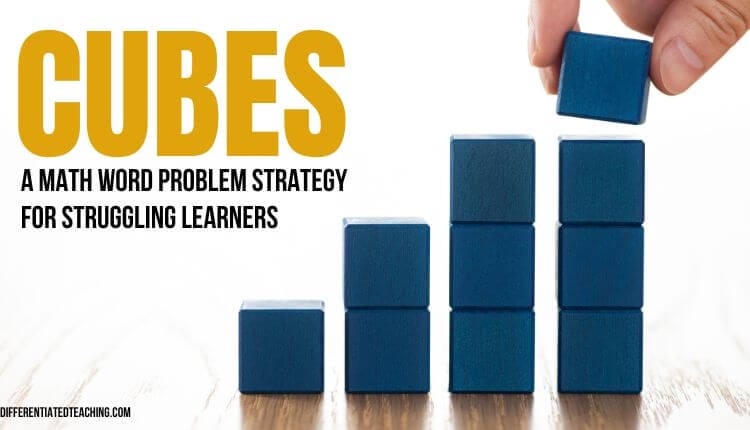
So if you’ve ever found yourself scratching your head in frustration over your struggling learners’ battle with story problems, fear not! The CUBES math strategy is here to make your life a whole lot easier. Stick around to learn more about how this awesome strategy can help you help your struggling students become math problem-solving pros!
What is the CUBES Math Strategy?
The CUBES math strategy is a tool designed to help give students a systematic approach to breaking down and solving math word problems. The acronym C.U.B.E.S stands for:
- C ircle key numbers & units
- U nderline the question
- B ox math action words
- E valuate the problem
- S olve the problem & check your work
By breaking down the problem into these steps, students can better understand the context of the problem and effectively solve it.
Benefits of using the CUBES strategy in math word problems
While CUBES is not the ideal method for all math problem solving, especially as word problems become more complex, you can use the strategy as a starting point to guide struggling students in being more attentive and systematic when tackling word problems.
Many struggling learners struggle with executive functioning and need a clear-cut plan for tackling this next-level math skill, and incorporating a strategy like CUBES into your teaching can give them steps to approach word problems rather than leaving them overwhelmed and unsure where to begin. This can help students build confidence in their ability to successfully solve math story problems and prepare them to solve multi-step problems, ultimately enhancing their problem-solving skills.
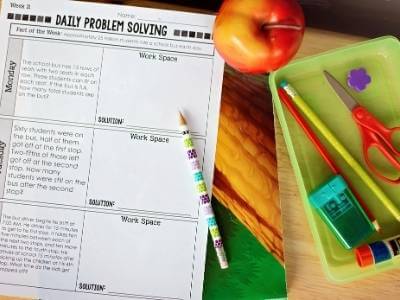
Step-by-Step Guide to Using the CUBES Strategy
Implementing the CUBES strategy means teaching students the key steps and working through a gradual release process until they can effectively do this themselves. This systematic approach helps students understand the problem and empowers them to tackle word problems with confidence. Here’s a little more about each step your students will need to achieve:
C- Circle the numbers & units
C stands for “circle the key information.” This includes the numbers, units, and core information needed to solve the problem. This includes identifying math vocabulary that represents a number, such as “several,” “half,” or “a dozen.” Some questions may not involve numbers at all, in which case you would circle each instance of the word “none.” It is also important to identify units (such as feet, miles, or kilograms) and whether there is a decimal point.
While we don’t want students solely relying on keywords when faced with a word problem, it can be helpful for them to recognize which words are references to mathematical symbols. For example, “+” means addition, and “-” means subtraction.
U- Underline the question
After students read the problem and circle numbers/units, they must underline the question. While this may seem silly, if students aren’t attending to what is being asked, they won’t get the right answer. Helping students stay on target is a key component of the CUBES strategy for solving math problems.
Once your student has underlined the question and knows exactly what he or she needs to solve, it’s time to move on to step B: boxes and bullets.
B- Box math action words
Notice this doesn’t say keywords…Again, we don’t want students focused solely on using keywords for math problem solving. Research has shown time and time again this is an ineffective strategy once problems become more complex.
That said, students need to look at word problems through the lens of critical readers. What in the problem gives them a clue as to what they need to do to solve it?
Just like the author of a story gives us details to help us infer and get to the story’s resolution, the author of a word problem helps us find the path to the solution. We need to be critical readers to get there. This is where boxing key information can be helpful. Here are some common examples that are often viewed as keywords but are critical for students to attend to to solve problems accurately:
- Addition: add, added, both, sum, total
- Subtraction: difference between, less than
- Multiplication: times twice as many/much as of every
- Division: split equally among/between each share out of
E- Evaluate or Equation
At this stage, it’s time to implement your strategy to solve. For some students, this will be writing and solving the equation. Others may need to evaluate by drawing a picture or using manipulatives to model the problem.
Either way, by this stage your learners should have broken down the problem to the point that they feel confident implementing a method that will lead them to the final step – solving.
S- Solve & Check
Once the strategy has been chosen, guide your students through the process of solving the problem. This may involve writing out the equation, solving for the unknown variable, and checking their work to ensure they have found the correct solution.
Encourage your students to show their work and explain their reasoning as they solve the problem. This will not only help them understand the process better but also allow you to provide feedback and support if needed.
It’s important to emphasize the importance of checking their work to ensure they have found the correct solution. This may involve plugging the solution back into the original problem to verify it or checking their work for errors in calculations.
Once your students have successfully solved the problem, congratulate them on their hard work and encourage them to reflect on the process. Ask them questions such as what strategies worked well for them, what challenges they encountered, and how they can apply what they have learned to similar problems in the future.
By guiding your students through the process of problem-solving and encouraging them to reflect on their work, you are helping them develop essential critical thinking skills that will serve them well in all areas of their education and beyond.

Tips for Implementing the CUBES Math Word Problem Strategy
Whenever you’re preparing to implement a strategy with your struggling learners, it can be helpful to get some tips from teachers who have been there. In asking for advice from colleagues, here’s what they had to say.
To teach the cubes strategy, you should:
- Teach the strategy as a whole. Because this is such a visual strategy, it’s useful to provide multiple examples of how to solve problems with CUBES on a poster or anchor chart. You can use the chart below as an example of what to include.
- Use a standard problem as an example. Before having students practice on their own, have them watch and listen as you model how to use the CUBES strategy on the board using a Problem of the Day or by writing in student journals. Visual learners will appreciate watching you write out each step and manipulate your complex number sentence cube.
- Use anchor charts you make together in class. Then transfer that knowledge into modeling one or two more examples with students using cubes they create out of construction paper, or if necessary, manipulatives like buttons or dry beans.
- Don’t fall into the trap that the standard algorithm is the only way to solve once the strategy has been used. Let students draw pictures, use manipulatives, make number lines, or whatever other strategies you’ve taught. The CUBES math strategy is to help them break up the problem. It isn’t the guiding principle of the math calculations.
- Students can use CUBES to filter out irrelevant details and focus on the essential details needed to solve the problem. By guiding students to evaluate the problem systematically, you can help students make informed decisions and tackle complex math challenges. It is great for learners who might get bogged down in all the details.
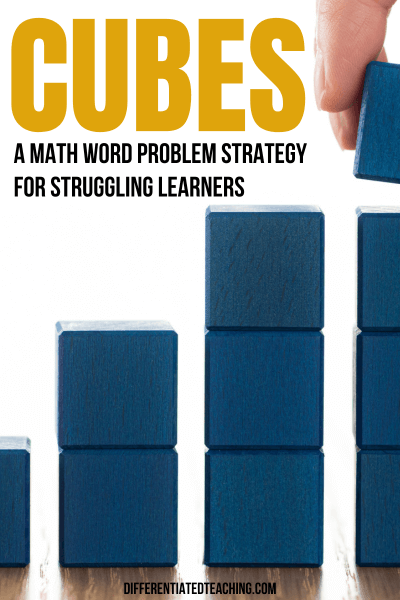
- Standards Institute™
- Program Login
- CORE Learning
- Call Us: (844) 814-5326
- Services Overview
- Leadership Institute
- Local Summits
- Cohort Program
- Speaking Engagements
- GLEAM™ Inventory
- Math Leader Collaborative
- Online Modules
- About UnboundEd
- Lacey Robinson
- Justice Seekers
- Get Started
Word Problems? No Problem! — Effective Strategies for Solving Math Word Problems
November 10, 2021
Outside of the classroom, much of the math we encounter is in the form of word problems. “I’m having 12 people for Thanksgiving dinner. Each person will eat 1.5 pounds of turkey. How big of a turkey do I need to buy?” Yet, inside the classroom, how to solve word problems can leave students and teachers scratching their heads.
During this on-demand webinar, Dr. Sarah R. Powell will share:
- Two ineffective word-problem practices and why not to use them
- The importance of an attack strategy when working through word problems
- Common word-problem structures that help students see consistency with word-problem solving
- How to incorporate an attack strategy and a focus on structure in your math instruction
Empower your students with effective strategies that will help them take on word problems with confidence.
”Download

3.1 Use a Problem-Solving Strategy
Learning objectives.
By the end of this section, you will be able to:
- Approach word problems with a positive attitude
- Use a problem-solving strategy for word problems
- Solve number problems
Be Prepared 3.1
Before you get started, take this readiness quiz.
Translate “6 less than twice x ” into an algebraic expression. If you missed this problem, review Example 1.26 .
Be Prepared 3.2
Solve: 2 3 x = 24 . 2 3 x = 24 . If you missed this problem, review Example 2.16 .
Solve: 3 x + 8 = 14 . 3 x + 8 = 14 . If you missed this problem, review Example 2.27 .
Approach Word Problems with a Positive Attitude
“If you think you can… or think you can’t… you’re right.”—Henry Ford
The world is full of word problems! Will my income qualify me to rent that apartment? How much punch do I need to make for the party? What size diamond can I afford to buy my girlfriend? Should I fly or drive to my family reunion?
How much money do I need to fill the car with gas? How much tip should I leave at a restaurant? How many socks should I pack for vacation? What size turkey do I need to buy for Thanksgiving dinner, and then what time do I need to put it in the oven? If my sister and I buy our mother a present, how much does each of us pay?
Now that we can solve equations, we are ready to apply our new skills to word problems. Do you know anyone who has had negative experiences in the past with word problems? Have you ever had thoughts like the student below?
When we feel we have no control, and continue repeating negative thoughts, we set up barriers to success. We need to calm our fears and change our negative feelings.
Start with a fresh slate and begin to think positive thoughts. If we take control and believe we can be successful, we will be able to master word problems! Read the positive thoughts in Figure 3.3 and say them out loud.
Think of something, outside of school, that you can do now but couldn’t do 3 years ago. Is it driving a car? Snowboarding? Cooking a gourmet meal? Speaking a new language? Your past experiences with word problems happened when you were younger—now you’re older and ready to succeed!
Use a Problem-Solving Strategy for Word Problems
We have reviewed translating English phrases into algebraic expressions, using some basic mathematical vocabulary and symbols. We have also translated English sentences into algebraic equations and solved some word problems. The word problems applied math to everyday situations. We restated the situation in one sentence, assigned a variable, and then wrote an equation to solve the problem. This method works as long as the situation is familiar and the math is not too complicated.
Now, we’ll expand our strategy so we can use it to successfully solve any word problem. We’ll list the strategy here, and then we’ll use it to solve some problems. We summarize below an effective strategy for problem solving.
Use a Problem-Solving Strategy to Solve Word Problems.
- Step 1. Read the problem. Make sure all the words and ideas are understood.
- Step 2. Identify what we are looking for.
- Step 3. Name what we are looking for. Choose a variable to represent that quantity.
- Step 4. Translate into an equation. It may be helpful to restate the problem in one sentence with all the important information. Then, translate the English sentence into an algebraic equation.
- Step 5. Solve the equation using good algebra techniques.
- Step 6. Check the answer in the problem and make sure it makes sense.
- Step 7. Answer the question with a complete sentence.
Example 3.1
Pilar bought a purse on sale for $18, which is one-half of the original price. What was the original price of the purse?
Step 1. Read the problem. Read the problem two or more times if necessary. Look up any unfamiliar words in a dictionary or on the internet.
- In this problem, is it clear what is being discussed? Is every word familiar?
Step 2. Identify what you are looking for. Did you ever go into your bedroom to get something and then forget what you were looking for? It’s hard to find something if you are not sure what it is! Read the problem again and look for words that tell you what you are looking for!
- In this problem, the words “what was the original price of the purse” tell us what we need to find.
Step 3. Name what we are looking for. Choose a variable to represent that quantity. We can use any letter for the variable, but choose one that makes it easy to remember what it represents.
- Let p = p = the original price of the purse.
Step 4. Translate into an equation. It may be helpful to restate the problem in one sentence with all the important information. Translate the English sentence into an algebraic equation.
Reread the problem carefully to see how the given information is related. Often, there is one sentence that gives this information, or it may help to write one sentence with all the important information. Look for clue words to help translate the sentence into algebra. Translate the sentence into an equation.
Step 5. Solve the equation using good algebraic techniques. Even if you know the solution right away, using good algebraic techniques here will better prepare you to solve problems that do not have obvious answers.
Step 6. Check the answer in the problem to make sure it makes sense. We solved the equation and found that p = 36 , p = 36 , which means “the original price” was $36.
- Does $36 make sense in the problem? Yes, because 18 is one-half of 36, and the purse was on sale at half the original price.
Step 7. Answer the question with a complete sentence. The problem asked “What was the original price of the purse?”
- The answer to the question is: “The original price of the purse was $36.”
If this were a homework exercise, our work might look like this:
Pilar bought a purse on sale for $18, which is one-half the original price. What was the original price of the purse?
Joaquin bought a bookcase on sale for $120, which was two-thirds of the original price. What was the original price of the bookcase?
Two-fifths of the songs in Mariel’s playlist are country. If there are 16 country songs, what is the total number of songs in the playlist?
Let’s try this approach with another example.
Example 3.2
Ginny and her classmates formed a study group. The number of girls in the study group was three more than twice the number of boys. There were 11 girls in the study group. How many boys were in the study group?
Guillermo bought textbooks and notebooks at the bookstore. The number of textbooks was 3 more than twice the number of notebooks. He bought 7 textbooks. How many notebooks did he buy?
Gerry worked Sudoku puzzles and crossword puzzles this week. The number of Sudoku puzzles he completed is eight more than twice the number of crossword puzzles. He completed 22 Sudoku puzzles. How many crossword puzzles did he do?
Solve Number Problems
Now that we have a problem solving strategy, we will use it on several different types of word problems. The first type we will work on is “number problems.” Number problems give some clues about one or more numbers. We use these clues to write an equation. Number problems don’t usually arise on an everyday basis, but they provide a good introduction to practicing the problem solving strategy outlined above.
Example 3.3
The difference of a number and six is 13. Find the number.
The difference of a number and eight is 17. Find the number.
The difference of a number and eleven is −7 . −7 . Find the number.
Example 3.4
The sum of twice a number and seven is 15. Find the number.
Did you notice that we left out some of the steps as we solved this equation? If you’re not yet ready to leave out these steps, write down as many as you need.
The sum of four times a number and two is 14. Find the number.
The sum of three times a number and seven is 25. Find the number.
Some number word problems ask us to find two or more numbers. It may be tempting to name them all with different variables, but so far we have only solved equations with one variable. In order to avoid using more than one variable, we will define the numbers in terms of the same variable. Be sure to read the problem carefully to discover how all the numbers relate to each other.
Example 3.5
One number is five more than another. The sum of the numbers is 21. Find the numbers.
One number is six more than another. The sum of the numbers is twenty-four. Find the numbers.
Try It 3.10
The sum of two numbers is fifty-eight. One number is four more than the other. Find the numbers.
Example 3.6
The sum of two numbers is negative fourteen. One number is four less than the other. Find the numbers.
Try It 3.11
The sum of two numbers is negative twenty-three. One number is seven less than the other. Find the numbers.
Try It 3.12
The sum of two numbers is −18 . −18 . One number is 40 more than the other. Find the numbers.
Example 3.7
One number is ten more than twice another. Their sum is one. Find the numbers.

Try It 3.13
One number is eight more than twice another. Their sum is negative four. Find the numbers.
Try It 3.14
One number is three more than three times another. Their sum is −5 . −5 . Find the numbers.
Some number problems involve consecutive integers. Consecutive integers are integers that immediately follow each other. Examples of consecutive integers are:
Notice that each number is one more than the number preceding it. So if we define the first integer as n , the next consecutive integer is n + 1 . n + 1 . The one after that is one more than n + 1 , n + 1 , so it is n + 1 + 1 , n + 1 + 1 , which is n + 2 . n + 2 .
Example 3.8
The sum of two consecutive integers is 47. Find the numbers.
Try It 3.15
The sum of two consecutive integers is 95 . 95 . Find the numbers.
Try It 3.16
The sum of two consecutive integers is −31 . −31 . Find the numbers.
Example 3.9
Find three consecutive integers whose sum is −42 . −42 .
Try It 3.17
Find three consecutive integers whose sum is −96 . −96 .
Try It 3.18
Find three consecutive integers whose sum is −36 . −36 .
Now that we have worked with consecutive integers, we will expand our work to include consecutive even integers and consecutive odd integers. Consecutive even integers are even integers that immediately follow one another. Examples of consecutive even integers are:
Notice each integer is 2 more than the number preceding it. If we call the first one n , then the next one is n + 2 . n + 2 . The next one would be n + 2 + 2 n + 2 + 2 or n + 4 . n + 4 .
Consecutive odd integers are odd integers that immediately follow one another. Consider the consecutive odd integers 77, 79, and 81.
Does it seem strange to add 2 (an even number) to get from one odd integer to the next? Do you get an odd number or an even number when we add 2 to 3? to 11? to 47?
Whether the problem asks for consecutive even numbers or odd numbers, you don’t have to do anything different. The pattern is still the same—to get from one odd or one even integer to the next, add 2.
Example 3.10
Find three consecutive even integers whose sum is 84.
Try It 3.19
Find three consecutive even integers whose sum is 102.
Try It 3.20
Find three consecutive even integers whose sum is −24 . −24 .
Example 3.11
A married couple together earns $110,000 a year. The wife earns $16,000 less than twice what her husband earns. What does the husband earn?
Try It 3.21
According to the National Automobile Dealers Association, the average cost of a car in 2014 was $28,500. This was $1,500 less than 6 times the cost in 1975. What was the average cost of a car in 1975?
Try It 3.22
U.S. Census data shows that the median price of new home in the United States in November 2014 was $280,900. This was $10,700 more than 14 times the price in November 1964. What was the median price of a new home in November 1964?
Section 3.1 Exercises
Practice makes perfect.
Use the Approach Word Problems with a Positive Attitude
In the following exercises, prepare the lists described.
List five positive thoughts you can say to yourself that will help you approach word problems with a positive attitude. You may want to copy them on a sheet of paper and put it in the front of your notebook, where you can read them often.
List five negative thoughts that you have said to yourself in the past that will hinder your progress on word problems. You may want to write each one on a small piece of paper and rip it up to symbolically destroy the negative thoughts.
In the following exercises, solve using the problem solving strategy for word problems. Remember to write a complete sentence to answer each question.
Two-thirds of the children in the fourth-grade class are girls. If there are 20 girls, what is the total number of children in the class?
Three-fifths of the members of the school choir are women. If there are 24 women, what is the total number of choir members?
Zachary has 25 country music CDs, which is one-fifth of his CD collection. How many CDs does Zachary have?
One-fourth of the candies in a bag of M&M’s are red. If there are 23 red candies, how many candies are in the bag?
There are 16 girls in a school club. The number of girls is four more than twice the number of boys. Find the number of boys.
There are 18 Cub Scouts in Pack 645. The number of scouts is three more than five times the number of adult leaders. Find the number of adult leaders.
Huong is organizing paperback and hardback books for her club’s used book sale. The number of paperbacks is 12 less than three times the number of hardbacks. Huong had 162 paperbacks. How many hardback books were there?
Jeff is lining up children’s and adult bicycles at the bike shop where he works. The number of children’s bicycles is nine less than three times the number of adult bicycles. There are 42 adult bicycles. How many children’s bicycles are there?
Philip pays $1,620 in rent every month. This amount is $120 more than twice what his brother Paul pays for rent. How much does Paul pay for rent?
Marc just bought an SUV for $54,000. This is $7,400 less than twice what his wife paid for her car last year. How much did his wife pay for her car?
Laurie has $46,000 invested in stocks and bonds. The amount invested in stocks is $8,000 less than three times the amount invested in bonds. How much does Laurie have invested in bonds?
Erica earned a total of $50,450 last year from her two jobs. The amount she earned from her job at the store was $1,250 more than three times the amount she earned from her job at the college. How much did she earn from her job at the college?
In the following exercises, solve each number word problem.
The sum of a number and eight is 12. Find the number.
The sum of a number and nine is 17. Find the number.
The difference of a number and 12 is three. Find the number.
The difference of a number and eight is four. Find the number.
The sum of three times a number and eight is 23. Find the number.
The sum of twice a number and six is 14. Find the number.
The difference of twice a number and seven is 17. Find the number.
The difference of four times a number and seven is 21. Find the number.
Three times the sum of a number and nine is 12. Find the number.
Six times the sum of a number and eight is 30. Find the number.
One number is six more than the other. Their sum is 42. Find the numbers.
One number is five more than the other. Their sum is 33. Find the numbers.
The sum of two numbers is 20. One number is four less than the other. Find the numbers.
The sum of two numbers is 27. One number is seven less than the other. Find the numbers.
The sum of two numbers is −45 . −45 . One number is nine more than the other. Find the numbers.
The sum of two numbers is −61 . −61 . One number is 35 more than the other. Find the numbers.
The sum of two numbers is −316 . −316 . One number is 94 less than the other. Find the numbers.
The sum of two numbers is −284 . −284 . One number is 62 less than the other. Find the numbers.
One number is 14 less than another. If their sum is increased by seven, the result is 85. Find the numbers.
One number is 11 less than another. If their sum is increased by eight, the result is 71. Find the numbers.
One number is five more than another. If their sum is increased by nine, the result is 60. Find the numbers.
One number is eight more than another. If their sum is increased by 17, the result is 95. Find the numbers.
One number is one more than twice another. Their sum is −5 . −5 . Find the numbers.
One number is six more than five times another. Their sum is six. Find the numbers.
The sum of two numbers is 14. One number is two less than three times the other. Find the numbers.
The sum of two numbers is zero. One number is nine less than twice the other. Find the numbers.
The sum of two consecutive integers is 77. Find the integers.
The sum of two consecutive integers is 89. Find the integers.
The sum of two consecutive integers is −23 . −23 . Find the integers.
The sum of two consecutive integers is −37 . −37 . Find the integers.
The sum of three consecutive integers is 78. Find the integers.
The sum of three consecutive integers is 60. Find the integers.
Find three consecutive integers whose sum is −3 . −3 .
Find three consecutive even integers whose sum is 258.
Find three consecutive even integers whose sum is 222.
Find three consecutive odd integers whose sum is 171.
Find three consecutive odd integers whose sum is 291.
Find three consecutive even integers whose sum is −36 . −36 .
Find three consecutive even integers whose sum is −84 . −84 .
Find three consecutive odd integers whose sum is −213 . −213 .
Find three consecutive odd integers whose sum is −267 . −267 .
Everyday Math
Sale Price Patty paid $35 for a purse on sale for $10 off the original price. What was the original price of the purse?
Sale Price Travis bought a pair of boots on sale for $25 off the original price. He paid $60 for the boots. What was the original price of the boots?
Buying in Bulk Minh spent $6.25 on five sticker books to give his nephews. Find the cost of each sticker book.
Buying in Bulk Alicia bought a package of eight peaches for $3.20. Find the cost of each peach.
Price before Sales Tax Tom paid $1,166.40 for a new refrigerator, including $86.40 tax. What was the price of the refrigerator?
Price before Sales Tax Kenji paid $2,279 for a new living room set, including $129 tax. What was the price of the living room set?
Writing Exercises
What has been your past experience solving word problems?
When you start to solve a word problem, how do you decide what to let the variable represent?
What are consecutive odd integers? Name three consecutive odd integers between 50 and 60.
What are consecutive even integers? Name three consecutive even integers between −50 −50 and −40 . −40 .
ⓐ After completing the exercises, use this checklist to evaluate your mastery of the objectives of this section.
ⓑ If most of your checks were:
…confidently. Congratulations! You have achieved your goals in this section! Reflect on the study skills you used so that you can continue to use them. What did you do to become confident of your ability to do these things? Be specific!
…with some help. This must be addressed quickly as topics you do not master become potholes in your road to success. Math is sequential—every topic builds upon previous work. It is important to make sure you have a strong foundation before you move on. Whom can you ask for help? Your fellow classmates and instructor are good resources. Is there a place on campus where math tutors are available? Can your study skills be improved?
…no—I don’t get it! This is critical and you must not ignore it. You need to get help immediately or you will quickly be overwhelmed. See your instructor as soon as possible to discuss your situation. Together you can come up with a plan to get you the help you need.
As an Amazon Associate we earn from qualifying purchases.
This book may not be used in the training of large language models or otherwise be ingested into large language models or generative AI offerings without OpenStax's permission.
Want to cite, share, or modify this book? This book uses the Creative Commons Attribution License and you must attribute OpenStax.
Access for free at https://openstax.org/books/elementary-algebra-2e/pages/1-introduction
- Authors: Lynn Marecek, MaryAnne Anthony-Smith, Andrea Honeycutt Mathis
- Publisher/website: OpenStax
- Book title: Elementary Algebra 2e
- Publication date: Apr 22, 2020
- Location: Houston, Texas
- Book URL: https://openstax.org/books/elementary-algebra-2e/pages/1-introduction
- Section URL: https://openstax.org/books/elementary-algebra-2e/pages/3-1-use-a-problem-solving-strategy
© Jan 23, 2024 OpenStax. Textbook content produced by OpenStax is licensed under a Creative Commons Attribution License . The OpenStax name, OpenStax logo, OpenStax book covers, OpenStax CNX name, and OpenStax CNX logo are not subject to the Creative Commons license and may not be reproduced without the prior and express written consent of Rice University.
WOULD YOU LIKE ACCESS TO ALL THE FREEBIES FOR ELEMENTARY TEACHERS? ➔

Get a collection of FREE MATH RESOURCES for your grade level!
How to teach word problems: strategies for elementary teachers.
If you are looking for tips and ideas for how to teach word problems to your elementary students, then you’ve found the right place! We know that teaching elementary students how to solve word problems is important for math concept and skill application, but it sure can feel like a daunting charge without knowing about the different types, the best practices for teaching them, and common misconceptions to plan in advance for, as well as having the resources you need. All this information will make you feel confident about how to teach addition, subtraction, multiplication, and division word problems! Teaching students how to solve word problems will be so much easier!
This blog post will address the following questions:
- What is a word problem?
- What is a multi-step word problem?
- Why are elementary math word problems important?
- Why are math word problems so hard for elementary students?
- What are the types of word problems?
- How do I teach math word problems in a systematic way?
- What are the best elementary math word problem strategies I can teach my students and what are some tips for how to teach math word problems strategies?
- Do you have any helpful tips for how to teach word problems?
- What are the common mistakes I should look for that my students may make?
- How do I address my students’ common misconceptions surrounding elementary math word problems?
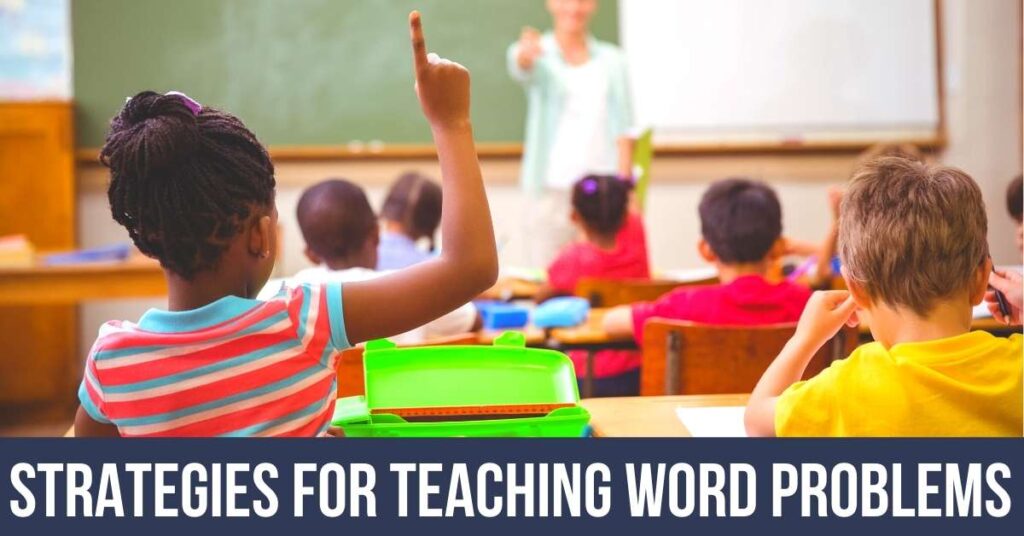
What is a Word Problem?
A word problem is a math situation that calls for an equation to be solved. Students must apply their critical thinking skills to determine how to solve the problem. Word problems give students the opportunity to practice turning situations into numbers. This is critical as students progress in their education, as well as in their day-to-day life. By teaching students how to solve word problems in a strategic way, you are setting them up for future success!
What is a Multi-Step Word Problem?
A multi-step word problem , also known as a two-step word problem or two-step equation word problem, is a math situation that involves more than one equation having to be answered in order to solve the ultimate question. This requires students to apply their problem solving skills to determine which operation or operations to use to tackle the problem and find the necessary information. In some cases, the situation may call for mixed operations, and in others the operations will be the same. Multi-step word problems offer students the opportunity to practice the skill of applying different math concepts with a given problem.

Why are Word Problems Important in Math?
Word problems are essential in math because they give students the opportunity to apply what they have learned to a real life situation. In addition, it facilitates students in developing their higher order thinking and critical thinking skills, creativity, positive mindset toward persevering while problem solving, and confidence in their math abilities. Word problems are an effective tool for teachers to determine whether or not students understand and can apply the concepts and skills they learned to a real life situation.
Why do Students Struggle with Math Word Problems?
Knowing why students have trouble with word problems will help you better understand how to teach them. The reason why math word problems are difficult for your students is because of a few different reasons. First, students need to be able to fluently read and comprehend the text. Second, they need to be able to identify which operations and steps are needed to find the answer. Finally, they need to be able to accurately calculate the answer. If you have students who struggle with reading or English is their second language (ESL), they may not be able to accurately show what they know and can do because of language and literacy barriers. In these cases, it is appropriate to read the text aloud to them or have it translated into their native language for assignments and assessments.

Types of Word Problems
Knowing the different types of word problems will help you better understand how to teach math word problems. Read below to learn about the four types of basic one-step addition and subtraction word problems, the subcategories within each of them, and specific examples for all of them. Two-step equation word problems can encompass two of the same type or two separate types (also known as mixed operation word problems).
This type of word problem involves an action that increases the original amount. There are three kinds: Result unknown, change unknown, and initial quantity unknown.
Result Unknown
Example : There were 7 kids swimming in the pool. 3 more kids jumped in. How many kids are in the pool now? (7 + 3 = ?)
Change Unknown
Example : There were 8 kids swimming in the pool. More kids jumped in. Now there are 15 kids in the pool. How many kids jumped in? (8 + ? = 15)
Initial Quantity Unknown
Example : There were kids swimming in the pool. 2 kids jumped in. Now there are 6 kids in the pool. How many kids were swimming in the pool at first? (? + 2 = 6)
2. Separate
This type of word problem involves an action that decreases the original amount. There are three kinds: Result unknown, change unknown, and initial quantity unknown.
Example: There were 12 kids swimming in the pool. 6 of the kids got out of the pool. How many kids are in the pool now? (12 – 6 = ?)
Example: There were 9 kids swimming in the pool. Some of the kids got out of the pool. Now there are 4 kids in the pool. How many kids got out of the pool? (9 – ? = 4)
Example: There were kids swimming in the pool. 3 of the kids got out of the pool. Now there are 2 kids in the pool. How many kids were in the pool at first? (? – 3 = 2)
3. Part-Part-Whole
This type of word problem does not involve an action like the join and separate types. Instead, it is about defining relationships among a whole and two parts. There are two kinds: result unknown and part unknown.
Example: There are 5 boys and 9 girls swimming in the pool. How many kids are in the pool? (5 + 9 = ?)
Part Unknown
Example: There are 12 kids swimming in the pool. 8 of them are girls and the rest of them are boys. How many boys are swimming in the pool? (8 + ? = 12)
This type of word problem does not involve an action or relationship like the three other types. Instead, it is about comparing two different unrelated items. There are two kinds: Difference unknown and quantity unknown.
Difference Unknown
Example: There are 2 kids in the pool. There are 7 kids in the yard. How many more kids are in the yard than in the pool? (2 + ? = 7 or 7 – 2 = ?)
Quantity Unknown
Example 1: There are 5 kids in the pool. There are 3 fewer kids playing in the yard. How many kids are playing in the yard? (5 – 3 = ?)
Example 2: There are 2 kids in the pool. There are 10 more kids playing in the yard than in the pool. How many kids are playing in the yard? (2 + 10 = ?)
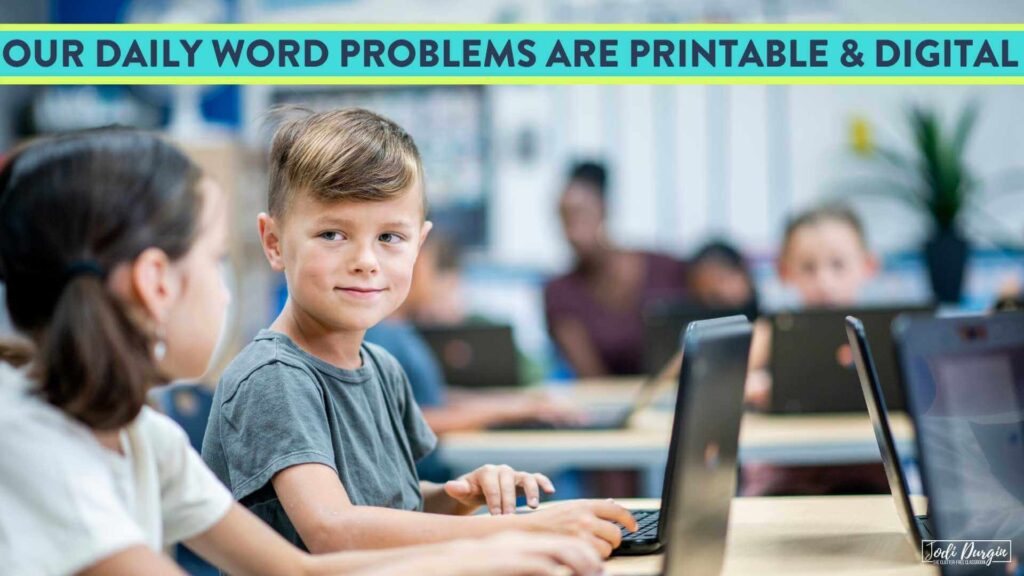
How to Solve Word Problems in 5 Easy Steps
Here are 5 steps that will help you teach word problems to your 1st, 2nd, 3rd, 4th or 5th grade students:
- Read the problem.
- Read the problem a second time and make meaning of it by visualizing, drawing pictures, and highlighting important information (numbers, phrases, and questions).
- Plan how you will solve the problem by organizing information in a graphic organizer and writing down equations and formulas that you will need to solve.
- Implement the plan and determine answer.
- Reflect on your answer and determine if it is reasonable. If not, check your work and start back at step one if needed. If the answer is reasonable, check your answer and be prepared to explain how you solved it and why you chose the strategies you did.
5 Math Word Problem Strategies
Here are 5 strategies for how to teach elementary word problems:
Understand the math situation and what the question is asking by picturing what you read in your head while you are reading.
Draw Pictures
Make meaning of what the word problem is asking by drawing a picture of the math situation.
Make Models
Use math tools like base-ten blocks to model what is happening in the math situation.
Highlight Important Information
Underline or highlight important numbers, phrases, and questions.
Engage in Word Study
Look for key words and phrases like “less” or “in all.” Check out this blog post if you are interested in learning more about math word problem keywords and their limitations.
10 Tips for Teaching Students How to Solve Math Word Problems
Here are 10 tips for how to teach math word problems:
- Model a positive attitude toward word problems and math.
- Embody a growth mindset.
- Model! Provide plenty of direct instruction.
- Give lots of opportunities to practice.
- Explicitly teach strategies and post anchor charts so students can access them and remember prior learning.
- Celebrate the strategies and process rather than the correct answer.
- Encourage students to continue persevering when they get stuck.
- Invite students to act as peer tutors.
- Provide opportunities for students to write their own word problems.
- Engage in whole-group discussions when solving word problems as a class.

Common Misconceptions and Errors When Students Learn How to Solve Math Word Problems
Here are 5 common misconceptions or errors elementary students have or make surrounding math word problems:
1. Use the Incorrect Operation
Elementary students often apply the incorrect operations because they pull the numbers from a word problem and add them without considering what the question is asking them or they misunderstand what the problem is asking. Early in their experience with word problems, this strategy may work most of the time; however, its effectiveness will cease as the math gets more complex. It is important to instruct students to develop and apply problem-solving strategies.
Although helpful in determining the meaning, elementary students rely solely on key words and phrases in a word problem to determine what operation is being called for. Again, this may be an effective strategy early on in their math career, but it should not be the only strategy students use to determine what their plan of attack is.
2. Get Stuck in a Fixed Mindset
Some elementary students give up before starting a word problem because they think all word problems are too hard. It is essential to instill a positive mindset towards math in students. The best way to do that is through modeling. If you portray an excitement for math, many of your students will share that same feeling.
3. Struggle with Reading Skills Component
For first and second graders (as well as struggling readers and ESL students), it is common for students to decode the text incorrectly. Along the same lines, some elementary students think they can’t solve word problems because they do not know how to read yet. The purpose of word problems is not to assess whether a child can read or not. Instead, the purpose is to assess their critical thinking and problem-solving skills. As a result, it is appropriate to read word problems to elementary students.
4. Calculate Incorrectly
You’ll find instances where students will understand what the question is asking, but they will calculate the addends or the subtrahend from the minuend incorrectly. This type of error is important to note when analyzing student responses because it gives you valuable information for when you plan your instruction.
5. Encode Response Incorrectly
Another error that is important to note when analyzing student responses is when you find that they encode their solution in writing incorrectly. This means they understand what the problem is asking, they solve the operations correctly, document their work meticulously, but then write the incorrect answer on the line.
How to Address Common Misconceptions Surrounding Math Word Problems
You might be wondering, “What can I do in response to some of these misconceptions and errors?” After collecting and analyzing the data, forming groups based on the results, and planning differentiated instruction, you may want to consider trying out these prompts:
- Can you reread the question aloud to me?
- What is the question asking us to do?
- How can we represent the information and question?
- Can we represent the information and question with an equation?
- What is our first step?
- What is our next step?
- Can you think of any strategies we use to help us solve?
- How did you find your answer?
- Can you walk me through how you found your answer step by step?
- What do we need to remember when recording our answer?

Now that you have all these tips and ideas for how to teach word problems, we would love for you to try these word problem resources with your students. They offer students opportunities to practice solving word problems after having learned how to solve word problems. You can download word problem worksheets specific to your grade level (along with lots of other math freebies) in our free printable math resources bundle using this link: free printable math activities for elementary teachers .
Check out my monthly word problem resources !
- 1st Grade Word Problems
- 2nd Grade Word Problems
- 3rd Grade Word Problems
- 4th Grade Word Problems
- 5th Grade Word Problems
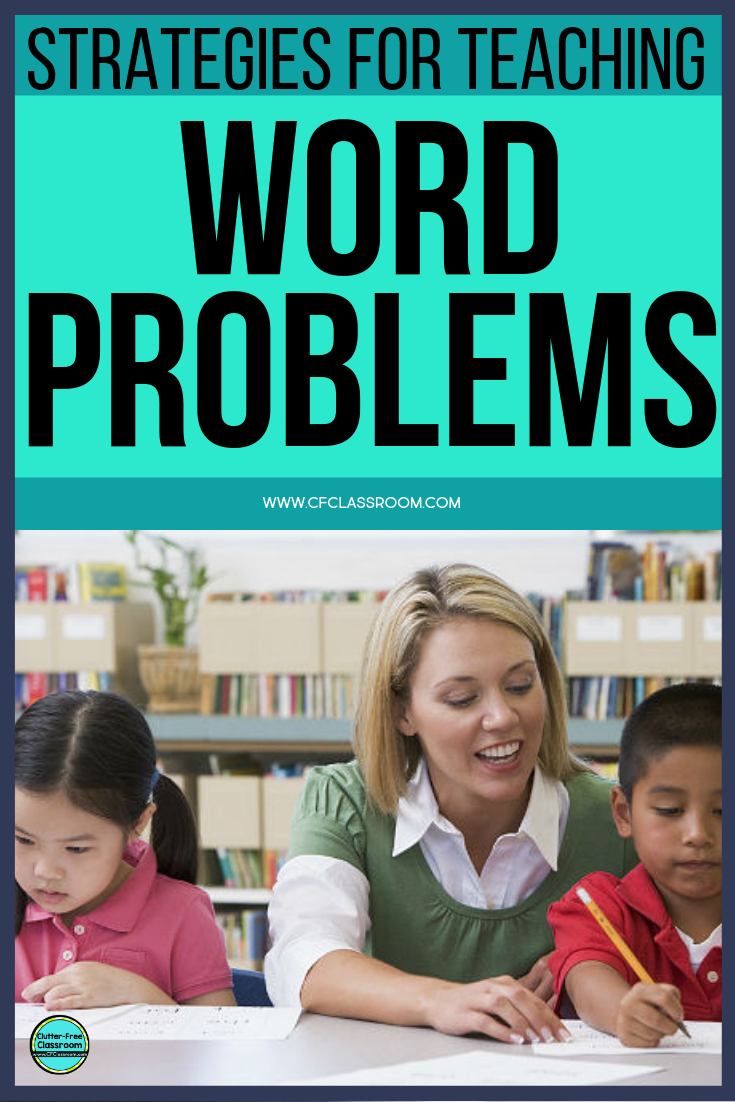
- Read more about: ELEMENTARY TEACHING , MATH
You might also like these posts...
Would you rather printables for elementary students: september edition, back to school would you rather activities for elementary students, would you rather questions and activities for elementary students: june edition.

LET'S CONNECT
Hey there! I’m Jodi. I am a National Board Certified teacher with 17 years of experience in the classroom.
I created Clutter-Free Classroom to support busy elementary teachers like you!
FREEBIES FOR TEACHERS
Join the 75,000+ elementary teachers who receive free resources from us each week.
© Jodi Durgin | Clutter-Free Classroom, LLC • Website by KristenDoyle.co
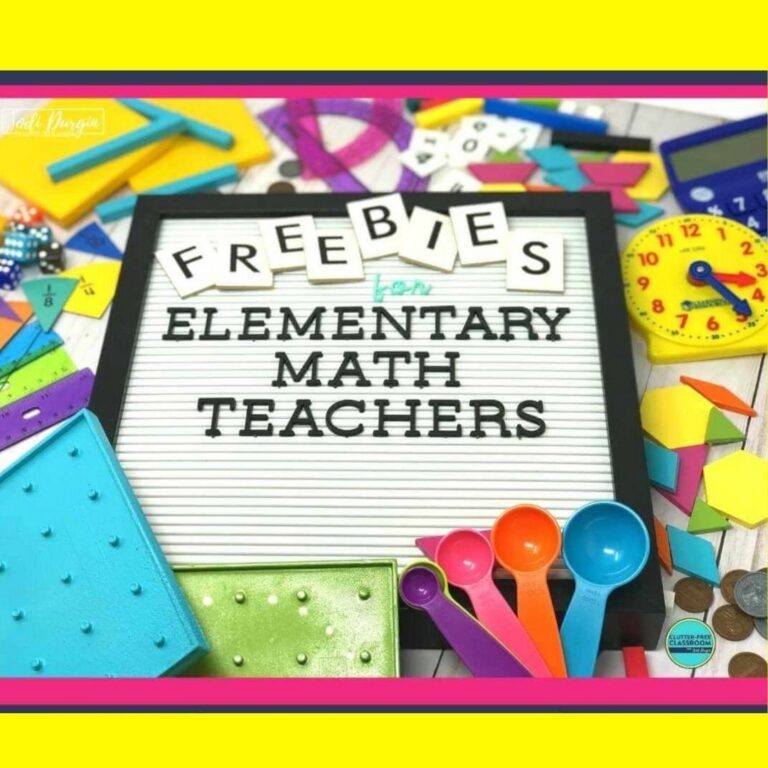

The Only Word Problem Strategy You Need

If you’re looking for an easy word problem strategy to transform your 3rd, 4th, or 5th grade class, you are in the right place! Word problems can be such a struggle for students, especially English Learners, but they don’t have to be.
Does this sound familiar?
You’re teaching word problems. You’ve barely finished reading the problem and you look out into your class. Half of them are completely checked out and waiting for you to to tell them what to do. The other half are jumping in, but they’re just randomly adding and multiplying the numbers without thinking about what they’re actually doing.
You’re frustrated because you know that word problems are so important. You know that in every day life, almost all of the math we do is word problems. Nobody hands us a ready made division problem to do alone in a cubicle.
You know that your students need a word problem strategy to help them to slow down and understand the problem. Some students, especially your language learners, need to slow down and make meaning of the words. Other students need to slow down and understand the meaning of the quantities in the word problem and how they relate.
A lot of students need all of the above.
So how can you help your students break down and understand word problems?

The one word problem strategy you need to try
My favorite strategy for teaching word problems is called Read 3 Ways . It’s fantastic because:
- You can use it with any word problem
- You can use it with any grade level or skill level
- It’s a fantastic support for language learners
- It provides extra challenge for your advanced students
- It slows students down so they can’t rush ahead and solve the problem incorrectly
How it works
As the title implies, in the word problem strategy Read 3 Ways we read the problem, you guessed it, 3 times.
In the first read you present the problem with the number omitted. If you’re using slides you can easily cover them with a rectangle. If you are projecting from a book on the document camera you can use a tiny scrap of paper or a little base-10 unit block to cover the numbers.

During the first read you pose this question: What is happening in the story?
Pretty simple right?
But this simple question leads to some rich discussion. Let’s look at this example.
Miguel read _____ pages. Clara read ____ more pages than Miguel. Maya read ___ pages less than Clara.
What is this story about? Well, we have Miguel, Clara, and Maya. They’ve all read a certain number of pages.
Did they read an equal amount? No.
How do you know? Well, the words more and less let us know that they read different amounts.
Even though we don’t have the number of pages yet, can we tell who read the most pages? How? Who read the least? How do you know?
Do you see that even without numbers, we can really break this problem apart?
Second Read
In the second read we read the problem again, except this time with the numbers included. We ask students, “what quantities are there and how do they relate?”
I tell students that 2 isn’t a quantity, but 2 dogs is. 30 isn’t a quantity, but 30 dollars is. Even 1st graders grasp this quickly.
Let’s continue with our example.
Miguel read 398 pages. Clara read 102 more pages than Miguel. Maya read 54 pages less than Clara.
What quantities do we have? Some students might say 398, 102, and 54. Don’t accept that. Who has 398? 398 what? Remember, we’re building deep understanding here.
Did you notice what’s missing from our word problem still? That’s right- there’s no question! Your speed racers aren’t able to steamroll ahead and instead are forced to slow down and reason through the words.
But of course you need a question eventually which leads us to…

In the third read, you read to generate a question. Ask your students, “what questions can be asked and answered by this question?”
After giving your students some think time and possibly a pair share, make a list on chart paper or on the board of their questions.
In our example of pages read, some questions might include:
- How many pages did Clara read?
- How many pages did Maya read?
- How many pages did all 3 students read all together?
Time to solve
At last, it’s time to solve. Reveal the question and let your students get to work!
Miguel read 398 pages. Clara read 102 more pages than Miguel. Maya read 54 pages less than Clara. How many pages did Miguel, Clara, and Maya read all together?
I’ve found that I’ve done so much foundational work getting to this point that every student gets to work right away. You read that right. Every. Single. Student.
What about your advanced students? Once they finish your question, ask them to tackle questions from the list generated in the 3rd read. They love to answer their classmates’ questions!

Your no prep solution
I love this word problem strategy because once you’re in the swing of the routine it’s very easy for you to facilitate and it really sets up your students for success.
Although it can be done with any word problem, there is a little legwork in selecting a problem and presenting it to your students.
That’s why I wrote out Read 3 Ways ready-to-present slides for you. My slides are absolutely zero prep. Just project and go!

I have 4 sets available, with 10 problems (44 slides) each. Your options are:
- Addition and subtraction in English
- Addition and subtraction in Spanish
- Multiplication in English
- Multiplication in Spanish
Whether or not you purchase my slides, let me know how this strategy worked for you by tagging me or DMing me on Instagram .

3 Powerful Text Based Narrative Writing Prompts for 4th and 5th Graders
PinFacebook What is a Text Based Narrative Writing Prompt? A...
The Power of Test Encouragement for Your Students
PinFacebook Have you ever seen the look of sheer anxiety...

Honoring the Fallen in Your Class: Memorial Day Reading Comprehension in Spanish & English
PinFacebook Are you looking for Memorial Day reading comprehension in...

4 Easy Valentine’s Day Ideas for Your Bilingual Class
PinFacebook February 14th is just around the corner, and if...

- Rooted In Reading
- Magic of Math
Free Resources
Teach students to solve word problems with this simple strategy.
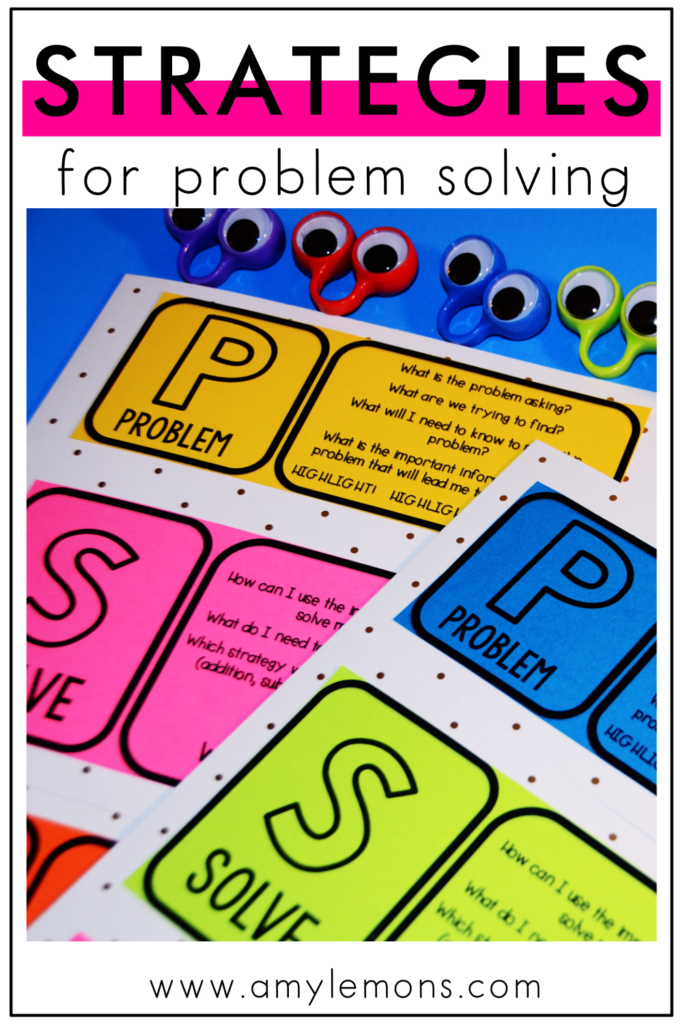
I bet you never imagined that life would be one big word problem. That’s the thing that many of us weren’t taught when we were completely unaware elementary school kids about to embark on one of the hardest math skills to learn — how to solve word problems.
Math word problems are much like the real-life scenarios that we encounter everyday. That’s what makes finding an effective, yet simple strategy for solving word problems crucial to successfully teaching your students problem-resolution skills in math and beyond.
I struggled with this concept for so long until I learned a simple strategy that made teaching this process so much easier.
What is the P.S.A Strategy for Solving Word Problems?
Solving word problems is hard. You know it. I know it. And guess what? Your students do too.
Students are *supposed to be* solving word problems. They should be reading the word problem and breaking it apart. They should be looking for possible solutions and checking their work.
BUT you look around the room and see students…
- rushing through their work
- highlighting or underlining every part of the problem
- adding the numbers together no matter what the problem says
Does that sound familiar to you? Trust me. I’ve been there. I’ve modeled, modeled, and modeled how to dissect a word problem. I’ve taught the steps until I’m blue in the face. I’ve wanted to pull my hair out.
Then I learned about a simple yet effective problem-solving strategy from my dear friend, Hope King. It’s called P.S.A and I want to introduce this three-step strategy to you!
The P.S.A strategy is a simple way to solve word problems without causing too much of a headache or unnecessary frustration. It involves three steps.
P = Identify the problem.
S = Solve the problem.
A = Answer the problem.
Seems simple enough, right? Well, that’s the point — to keep it simple. Let’s dive deeper into these three steps to figure out how they are best applied in the classroom.
Gathering Problem-Solving Materials
Before digging into the P.S.A strategy, create a handy guide for students to reference as they are solving word problems. Posters or anchor charts are helpful visual elements. In addition, a P.S.A folder is a wonderful hands-on tool for students to organize their work.
To create these folders, each student will need a file folder and PSA labels. The folders allow students to solve word problems step by step, eliminating some of the overwhelm that comes from trying to organize thoughts and pick out the important parts of a problem.
Compile the folders by gluing each section of the process onto the front of a file folder. It’s a good idea to laminate the folder for durability. After lamination, the folder needs to be cut into the three sections (to create three flaps). Each flap represents the three steps for the P.S.A strategy.
Now, students are ready to solve problems!
Step One: Identify the Problem
Students begin by identifying the problem. First, they must read the problem. They highlight the most important information and, using the information from the problem, decide how they will solve it. They do NOT solve the problem yet. Students are simply reading to understand the problem.
Teaching Tip: During this step, I like to act out word problems with students. Having students come to the front of the class to act out the word problem gives them a great visual.
Step Two: Solve the Problem
Once the students understand what the purpose of the question is, they can decide what strategy will help them reach their answer. Students open up the “solve” flap of their folder and write an equation/show their work to solve the problem. During this step, encourage students to draw pictures, write equations, or make a model.
Teaching Tip: Give students the freedom to solve problems in a way that makes sense to them. Before identifying a solution, have students share how they solved the problem with the class. Students can explain their thinking to the class.
Step Three: Answer the Problem
Finally, the students arrive at their answer…BUT…it doesn’t stop here! P.S.A. encourages students to always use an additional strategy to check their answers before moving on. For example, if the students used subtraction to solve a problem, they might use addition to check.
This is probably one of the most beneficial steps in the entire process. The “Answer” section emphasizes the power of self-checking answers and often assists the students in self-correcting mistakes.
Teaching Tip: Students tend to skip the step of checking their answers. They want to be done and move on. Model how to re-read the problem and solve it in a new way. You may even want to go a step further and solve a problem incorrectly. This way you can show students how you found that error while checking your work!
Resources to Solve Word Problems Using the P.S.A Strategy
The P.S.A strategy has become an integral part of the math instruction I use and create. It’s included throughout our signature math curriculum Magic of Math ; however, check out the following units for hands-on math activities that specifically involve this easy to use strategy for word problems.
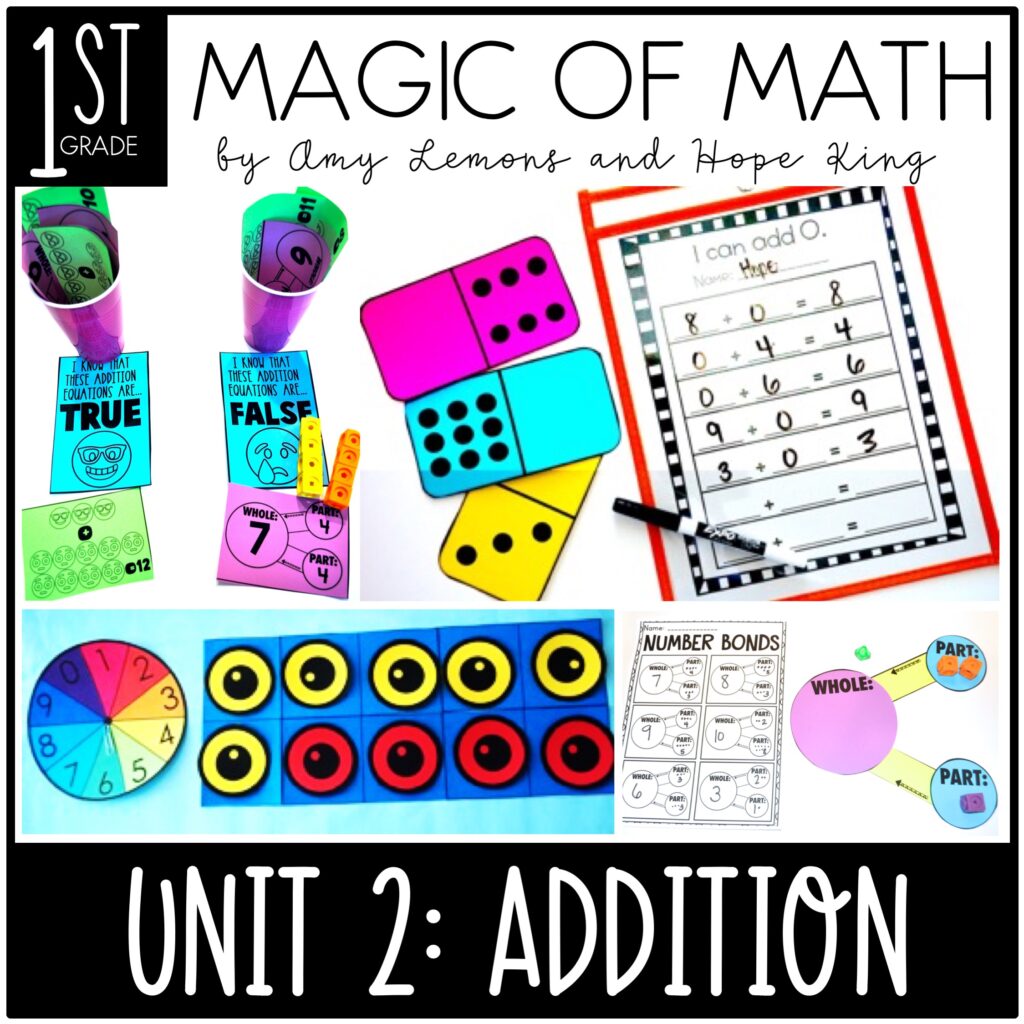
1st Grade Magic of Math Unit 2: Addition
Total Pages: 250 File Size: 24.4 MB

2nd Grade Magic of Math Unit 4: 2 and 3 Digit Regrouping
Learning 2 digit and 3 digit regrouping is hard, don’t make it harder with worksheets! Instead, students can learn and have fun by playing games, getting up and moving, and completing regrouping activities that engage each and every single learner. Worksheet free!
Our 3-digit addition week even has a superhero theme …
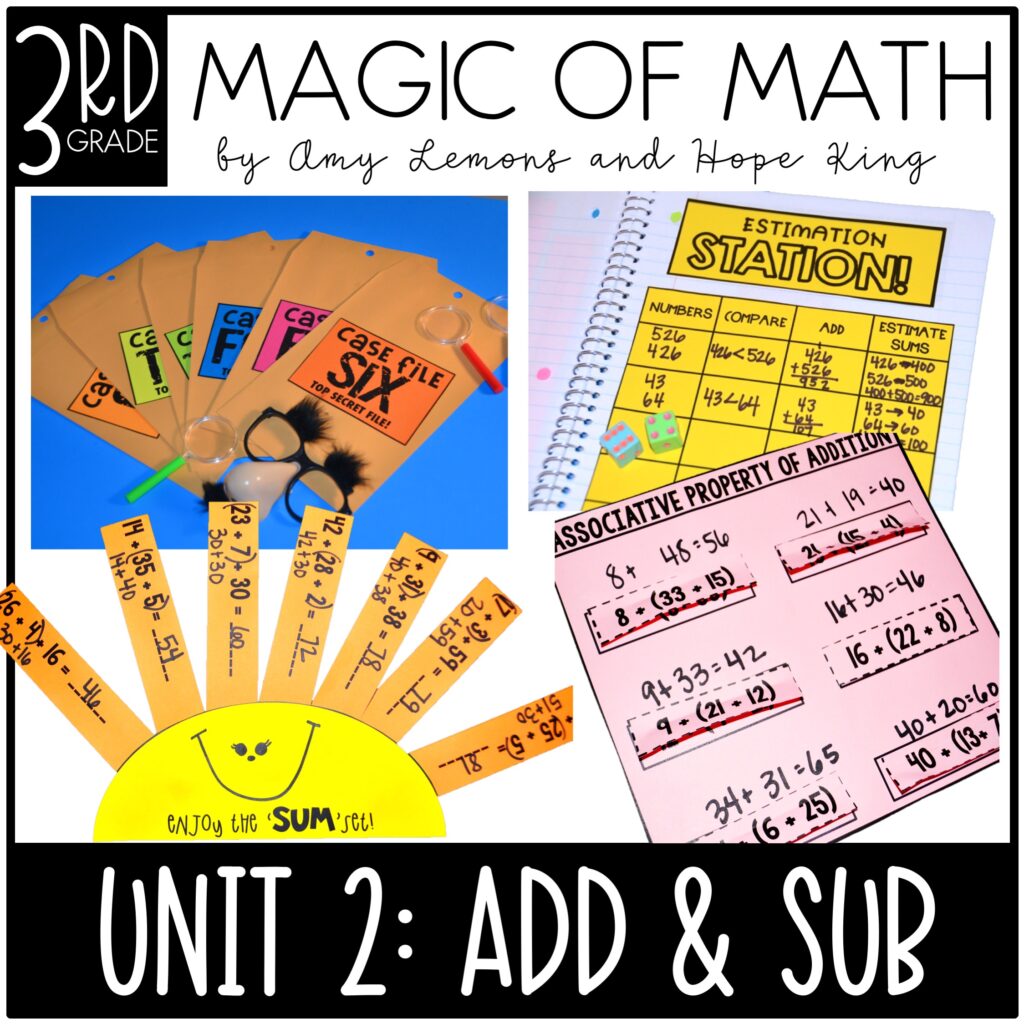
3rd Grade Magic of Math Unit 2: Addition and Subtraction
Save the image below to come back to this simple strategy to teach students how to solve word problems.
Hi, I'm Amy
Hey, y’all! My name is Amy Lemons and I am passionate about providing students with both engaging and effective standards-based Math and ELA lessons.
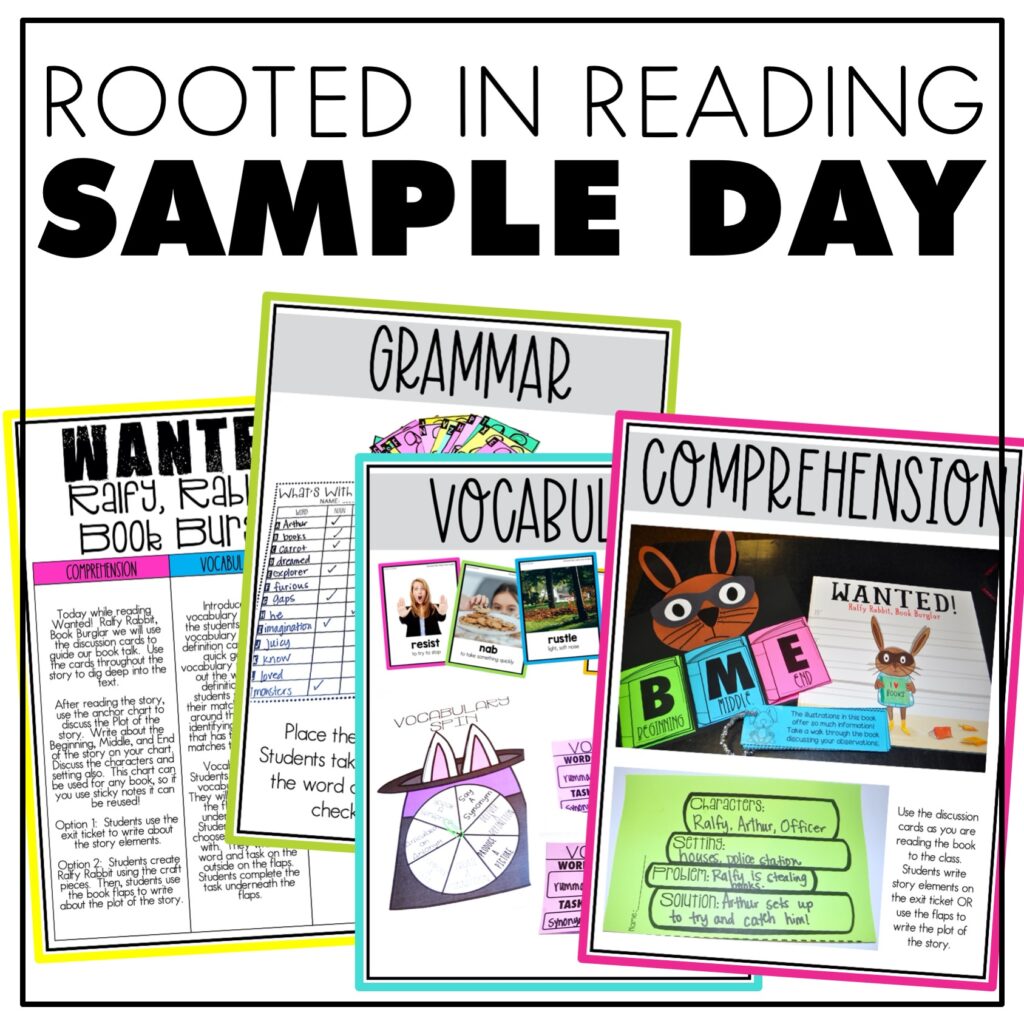
FREE SAMPLE OF ROOTED IN READING!
Sample a day of Rooted in Reading with these lesson plans and activities for Reading Comprehension, Vocabulary, and Grammar!
New In the Shop

Sun Math Craft with Summer Addition, Subtraction, Multiplication, or Division

Basketball Reading Response Craft with a March Madness Basketball Bulletin Board

Too Many Carrots Interactive Read Aloud Activities with Rabbit Informational Reader and Rabbit Crafts & Activities
You might also enjoy....
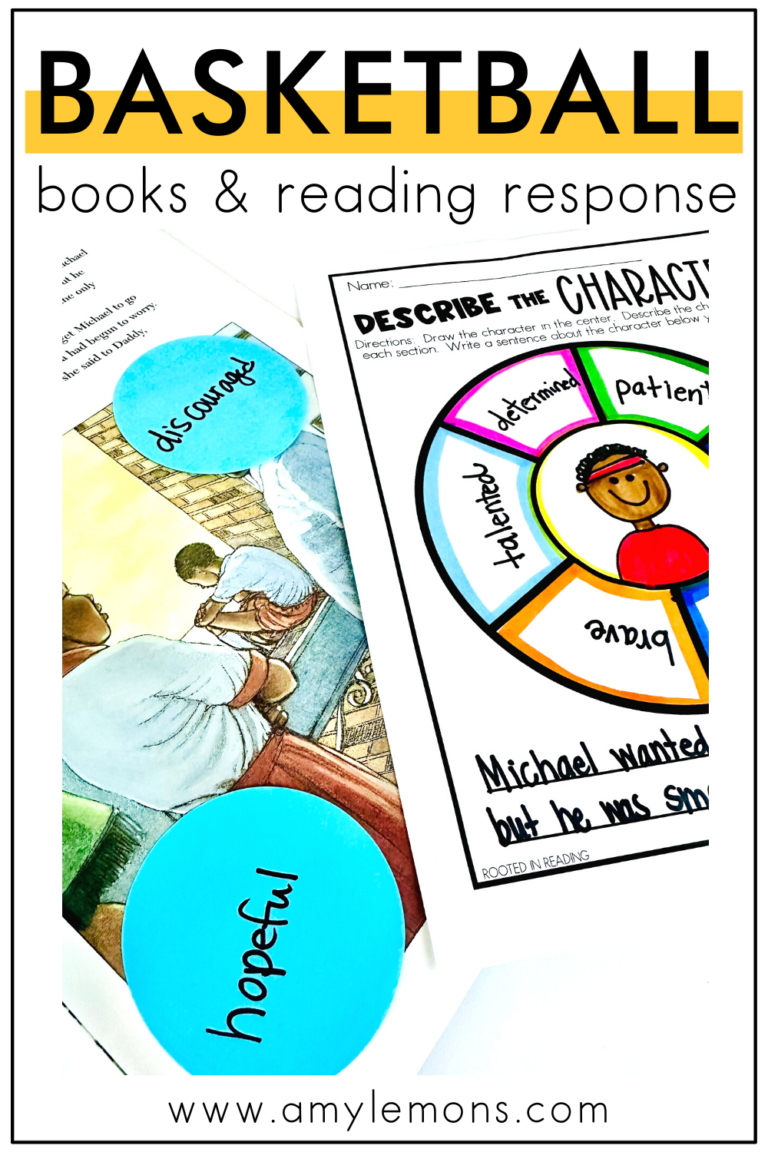
Leave a Reply Cancel reply
This site uses Akismet to reduce spam. Learn how your comment data is processed .

- Privacy Policy
- All Resources

©2022 Amy Lemons. All Rights Reserved.
Designed by ashley hughes.

3 Strategies to Conquer Math Word Problems
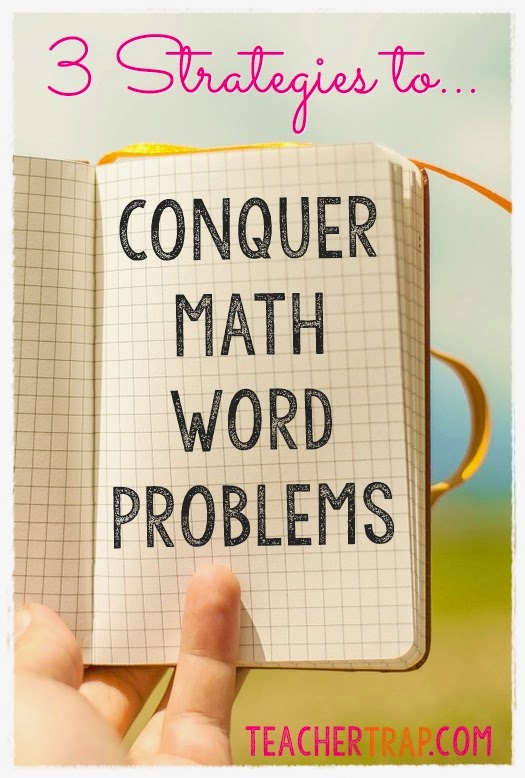
Here’s a word problem for you:
Miss Friday’s class does a daily word problem. Ten of her students are great at word problems involving addition, and only 7 seem to understand subtraction word problems. Five of her students are bored with the easy problems. Thirteen students are still struggling with basic math facts and 3 have trouble reading the word problems at all. How many of her students are engaged and learning?
Here’s a better question: “How do you grow confident and effective problem solvers?”
Why Students Struggle with Math Word Problems
Students struggle with math word problems for many reasons, but three of the biggest I’ve encountered include:
Issue #1: Student Confidence For many students, just looking at a word problem leads to anxiety. No one can think clearly with a sense of dread or fear of failure looming!
Issue #2: Flexible Thinking Many kids are taught to solve word problems methodically, with a prescriptive step-by-step plan using key words that don’t always work. Plans are great, but not when students use them as a crutch rather than a tool. Today’s standardized tests and real-world applications require creative thinking and flexibility with strategies.
Issue #3: Differentiation Teachers want students to excel quickly and often push too fast, too soon. In the case of word problems, you have to go slow to go fast. Just like in Guided Reading, you’ll want to give lots of practice with “just-right” problems and provide guided practice with problems just-above the students’ level.
3 Problem Solving Strategies
The solution is to conquer math word problems with engaging classroom strategies that counteract the above issues!
1. Teach a Problem-Solving Routine
Kids (and adults) are notoriously impulsive problem solvers. Many students see a word problem and want to immediately snatch out those numbers and “do something” with them. When I was in elementary school, this was actually a pretty reliable strategy! But today, kids are asked to solve much more complex problems, often with tricky wording or intentional distractors.
Grow flexible thinkers and build confidence by teaching a routine. A problem solving routine simply encourages students to slow down and think before and after solving. I’ve seen lots of effective routines but my favorites always include a “before, during, and after” mindset.
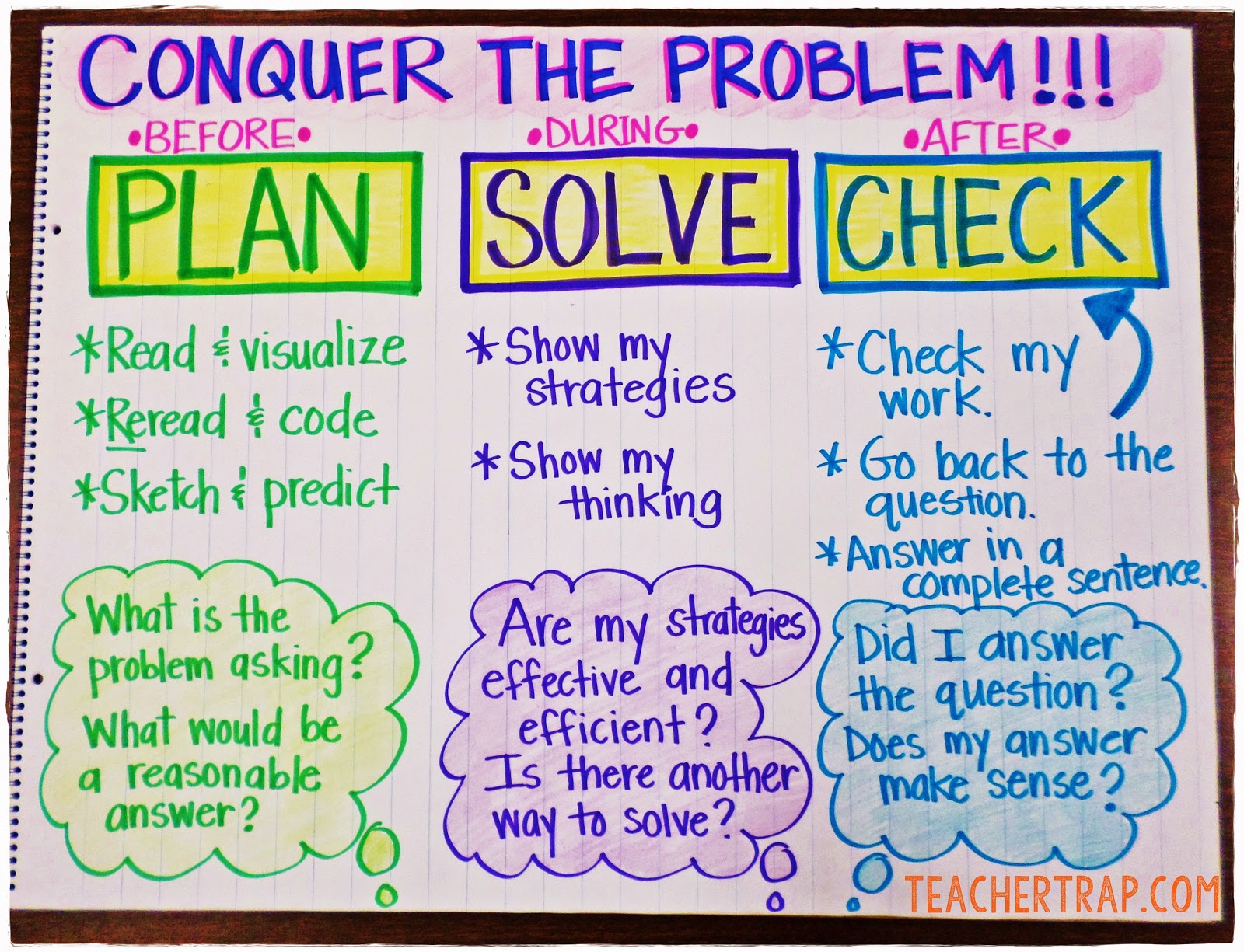
To make the problem solving routine meaningful and effective:
- Use it often (daily if possible)
- Incorporate “Turn & Teach” (Students orally explain their thinking and process to a partner.)
- Allow for “Strategy Share” after solving (Selected students explain their method and thinking.)
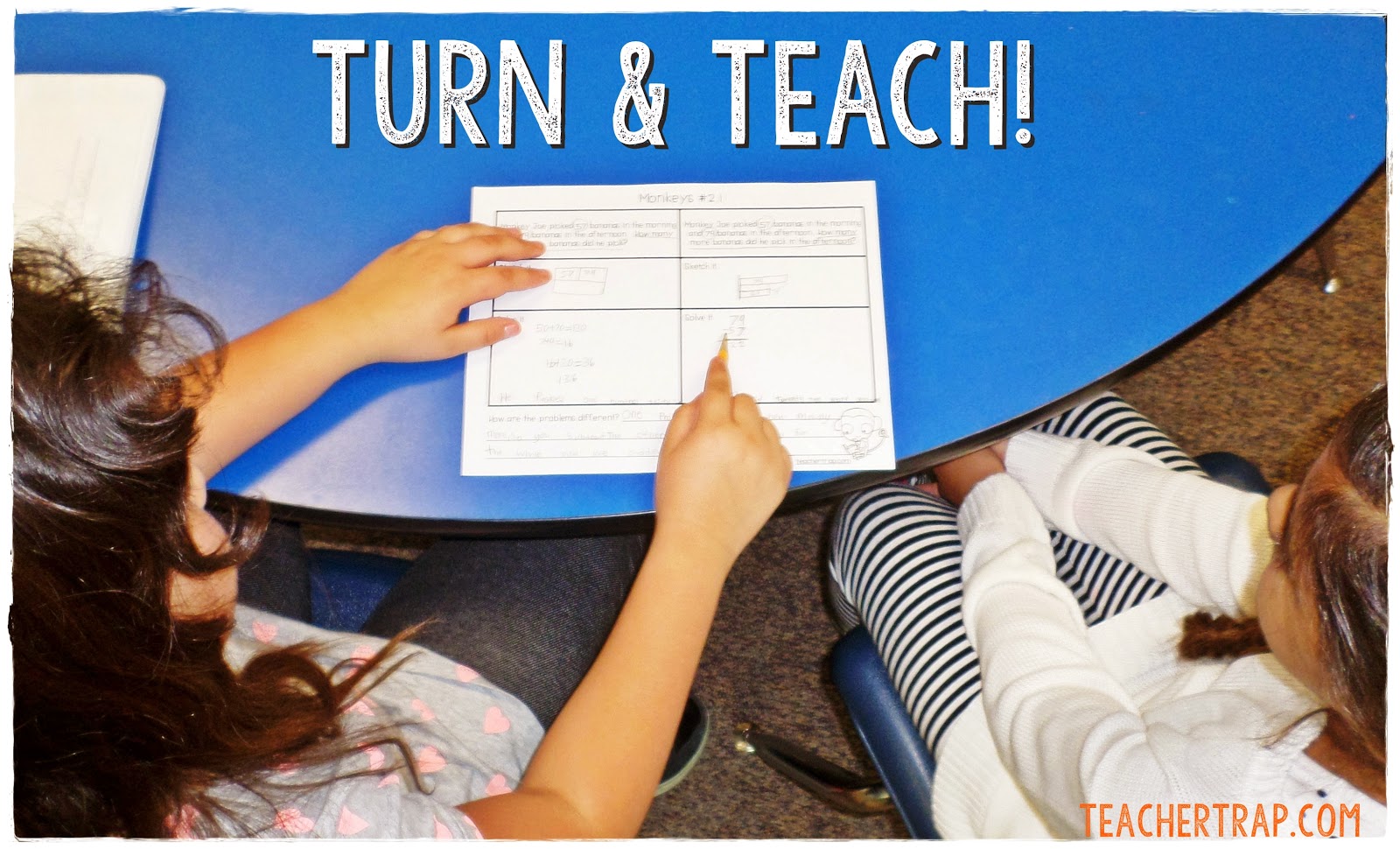
2. Differentiate Word Problems
No, this doesn’t mean to write a different word problem for every student! This can be as simple as adjusting the numbers in a problem or removing distractors for struggling students. Scaffolding word problems will grow confidence and improve problem solving skills by gradually increasing the level difficulty as the child is ready. This is especially effective when you are trying to teach students different structures of word problems to go with a certain operation.
For example, comparison subtraction problems are very challenging for some students. By starting with a simple version, you allow students to focus on the problem itself, rather than becoming intimidated or frustrated.
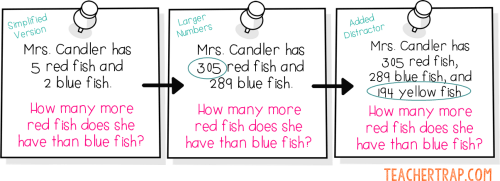
I’ve had great success in using scaffolded problems with my guided math groups. After solving the easier problem, students realize that it’s not that tricky and are ready to take on the tougher ones!
3. Compare Problems Side-by-Side
To develop flexible thinking, nothing is more powerful than analyzing and comparing word problems. Start by using problems that have similar stories and numbers, but different problem structures. Encourage conversation, use visual representations, and have students explain the difference in structure and operation. Here’s an example showing student work on two similar problems about monkeys. Click here to download a blank copy of these problems. My freebie includes several variations to help you differentiate.
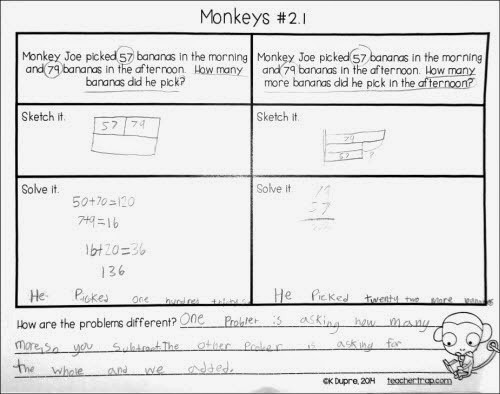
Use these three strategies to get kids thinking and talking about their problem solving strategies while building that “oh-so-important” confidence, and you CAN conquer math word problems!

Kady Dupre has worked as a classroom teacher, instructional coach, and intervention teacher in elementary grades. She loves creating learning resources for students and teachers. She authors Teacher Trap , a blog aimed at sharing her challenges, successes, and insights as a teacher.

Candler's Classroom Connections
- Growth Mindset
- Literature Circles
- Cooperative Learning


- school Campus Bookshelves
- menu_book Bookshelves
- perm_media Learning Objects
- login Login
- how_to_reg Request Instructor Account
- hub Instructor Commons
- Download Page (PDF)
- Download Full Book (PDF)
- Periodic Table
- Physics Constants
- Scientific Calculator
- Reference & Cite
- Tools expand_more
- Readability
selected template will load here
This action is not available.

2.3: Use a Problem Solving Strategy
- Last updated
- Save as PDF
- Page ID 5126

Learning Objectives
By the end of this section, you will be able to:
- Use a problem solving strategy for word problems
- Solve number word problems
- Solve percent applications
- Solve simple interest applications
Before you get started, take this readiness quiz.
- Translate “six less than twice \(x\)” into an algebraic expression. If you missed this problem, review [link] .
- Convert 4.5% to a decimal. If you missed this problem, review [link] .
- Convert 0.6 to a percent. If you missed this problem, review [link] .
Have you ever had any negative experiences in the past with word problems? When we feel we have no control, and continue repeating negative thoughts, we set up barriers to success. Realize that your negative experiences with word problems are in your past. To move forward you need to calm your fears and change your negative feelings.
Start with a fresh slate and begin to think positive thoughts. Repeating some of the following statements may be helpful to turn your thoughts positive. Thinking positive thoughts is a first step towards success.
- I think I can! I think I can!
- While word problems were hard in the past, I think I can try them now.
- I am better prepared now—I think I will begin to understand word problems.
- I am able to solve equations because I practiced many problems and I got help when I needed it—I can try that with word problems.
- It may take time, but I can begin to solve word problems.
- You are now well prepared and you are ready to succeed. If you take control and believe you can be successful, you will be able to master word problems.
Use a Problem Solving Strategy for Word Problems
Now that we can solve equations, we are ready to apply our new skills to word problems. We will develop a strategy we can use to solve any word problem successfully.
EXAMPLE \(\PageIndex{1}\)
Normal yearly snowfall at the local ski resort is 12 inches more than twice the amount it received last season. The normal yearly snowfall is 62 inches. What was the snowfall last season at the ski resort?
Try It! \(\PageIndex{1}\)
Guillermo bought textbooks and notebooks at the bookstore. The number of textbooks was three more than twice the number of notebooks. He bought seven textbooks. How many notebooks did he buy?
He bought two notebooks
Try It! \(\PageIndex{2}\)
Gerry worked Sudoku puzzles and crossword puzzles this week. The number of Sudoku puzzles he completed is eight more than twice the number of crossword puzzles. He completed 22 Sudoku puzzles. How many crossword puzzles did he do?
He did seven crossword puzzles
We summarize an effective strategy for problem solving.
PROBLEM SOLVING STRATEGY FOR WORD PROBLEMS
- Read the problem. Make sure all the words and ideas are understood.
- Identify what you are looking for.
- Name what you are looking for. Choose a variable to represent that quantity.
- Translate into an equation. It may be helpful to restate the problem in one sentence with all the important information. Then, translate the English sentence into an algebra equation.
- Solve the equation using proper algebra techniques.
- Check the answer in the problem to make sure it makes sense.
- Answer the question with a complete sentence.
Solve Number Word Problems
We will now apply the problem solving strategy to “number word problems.” Number word problems give some clues about one or more numbers and we use these clues to write an equation. Number word problems provide good practice for using the Problem Solving Strategy.
EXAMPLE \(\PageIndex{2}\)
The sum of seven times a number and eight is thirty-six. Find the number.
Did you notice that we left out some of the steps as we solved this equation? If you’re not yet ready to leave out these steps, write down as many as you need.
Try It! \(\PageIndex{3}\)
The sum of four times a number and two is fourteen. Find the number.
Try It! \(\PageIndex{4}\)
The sum of three times a number and seven is twenty-five. Find the number.
Some number word problems ask us to find two or more numbers. It may be tempting to name them all with different variables, but so far, we have only solved equations with one variable. In order to avoid using more than one variable, we will define the numbers in terms of the same variable. Be sure to read the problem carefully to discover how all the numbers relate to each other.
EXAMPLE \(\PageIndex{3}\)
The sum of two numbers is negative fifteen. One number is nine less than the other. Find the numbers.
Try It! \(\PageIndex{5}\)
The sum of two numbers is negative twenty-three. One number is seven less than the other. Find the numbers.
\(−15,−8\)
Try It! \(\PageIndex{6}\)
The sum of two numbers is negative eighteen. One number is forty more than the other. Find the numbers.
\(−29,11\)
Some number problems involve consecutive integers . Consecutive integers are integers that immediately follow each other. Examples of consecutive integers are:
\[\begin{array}{rrrr} 1, & 2, & 3, & 4 \\ −10, & −9, & −8, & −7\\ 150, & 151, & 152, & 153 \end{array}\nonumber\]
Notice that each number is one more than the number preceding it. Therefore, if we define the first integer as \(n,\) the next consecutive integer is \(n+1\). The one after that is one more than \(n+1\), so it is \(n+1+1\), which is \(n+2\).
\[\begin{array}{ll} n & 1^{\text{st}} \text{integer} \\ n+1 \;\;\;\;\;\;\;\;\;\;\;\;\;\;\;\;\; & 2^{\text{nd}}\text{consecutive integer} \\ n+2 & 3^{\text{rd}}\text{consecutive integer} \;\;\;\;\;\;\;\; \text{etc.} \end{array}\nonumber\]
We will use this notation to represent consecutive integers in the next example.
EXAMPLE \(\PageIndex{4}\)
Find three consecutive integers whose sum is \(−54\).
Try It! \(\PageIndex{7}\)
Find three consecutive integers whose sum is \(−96\).
\(−33,−32,−31\)
Try It! \(\PageIndex{8}\)
Find three consecutive integers whose sum is \(−36\).
\(−13,−12,−11\)
Now that we have worked with consecutive integers, we will expand our work to include consecutive even integers and consecutive odd integers . Consecutive even integers are even integers that immediately follow one another. Examples of consecutive even integers are:
\[24, 26, 28\nonumber\]
\[−12,−10,−8\nonumber\]
Notice each integer is two more than the number preceding it. If we call the first one \(n,\) then the next one is \(n+2\). The one after that would be \(n+2+2\) or \(n+4\).
Consecutive odd integers are odd integers that immediately follow one another. Consider the consecutive odd integers 63, 65, and 67.
\[63, 65, 67\nonumber\]
\[n,n+2,n+4\nonumber\]
Does it seem strange to have to add two (an even number) to get the next odd number? Do we get an odd number or an even number when we add 2 to 3? to 11? to 47?
Whether the problem asks for consecutive even numbers or odd numbers, you do not have to do anything different. The pattern is still the same—to get to the next odd or the next even integer, add two.
EXAMPLE \(\PageIndex{5}\)
Find three consecutive even integers whose sum is \(120\).
Try It! \(\PageIndex{9}\)
Find three consecutive even integers whose sum is 102.
\(32, 34, 36\)
Try It! \(\PageIndex{10}\)
Find three consecutive even integers whose sum is \(−24\).
\(−10,−8,−6\)
When a number problem is in a real life context, we still use the same strategies that we used for the previous examples.
EXAMPLE \(\PageIndex{6}\)
A married couple together earns $110,000 a year. The wife earns $16,000 less than twice what her husband earns. What does the husband earn?
According to the National Automobile Dealers Association, the average cost of a car in 2014 was $28,400. This was $1,600 less than six times the cost in 1975. What was the average cost of a car in 1975?
The average cost was $5,000.
Try It! \(\PageIndex{11}\)
US Census data shows that the median price of new home in the U.S. in November 2014 was $280,900. This was $10,700 more than 14 times the price in November 1964. What was the median price of a new home in November 1964?
The median price was $19,300.
Solve Percent Applications
There are several methods to solve percent equations. In algebra, it is easiest if we just translate English sentences into algebraic equations and then solve the equations. Be sure to change the given percent to a decimal before you use it in the equation.
EXAMPLE \(\PageIndex{7}\)
Translate and solve:
- What number is 45% of 84?
- 8.5% of what amount is $4.76?
- 168 is what percent of 112?
Try It! \(\PageIndex{12}\)
- What number is 45% of 80?
- 7.5% of what amount is $1.95?
- 110 is what percent of 88?
a. 36 b. $26 c. \(125 \% \)
Try It! \(\PageIndex{13}\)
- What number is 55% of 60?
- 8.5% of what amount is $3.06?
- 126 is what percent of 72?
a. 33 b. $36 c. \(175 \% \)
Now that we have a problem solving strategy to refer to, and have practiced solving basic percent equations, we are ready to solve percent applications. Be sure to ask yourself if your final answer makes sense—since many of the applications we will solve involve everyday situations, you can rely on your own experience.
EXAMPLE \(\PageIndex{8}\)
The label on Audrey’s yogurt said that one serving provided 12 grams of protein, which is 24% of the recommended daily amount. What is the total recommended daily amount of protein?
Try It! \(\PageIndex{14}\)
One serving of wheat square cereal has 7 grams of fiber, which is 28% of the recommended daily amount. What is the total recommended daily amount of fiber?
Try It! \(\PageIndex{15}\)
One serving of rice cereal has 190 mg of sodium, which is 8% of the recommended daily amount. What is the total recommended daily amount of sodium?
Remember to put the answer in the form requested. In the next example we are looking for the percent.
EXAMPLE \(\PageIndex{9}\)
Veronica is planning to make muffins from a mix. The package says each muffin will be 240 calories and 60 calories will be from fat. What percent of the total calories is from fat?
Try It! \(\PageIndex{16}\)
Mitzi received some gourmet brownies as a gift. The wrapper said each 28% brownie was 480 calories, and had 240 calories of fat. What percent of the total calories in each brownie comes from fat? Round the answer to the nearest whole percent.
Try It! \(\PageIndex{17}\)
The mix Ricardo plans to use to make brownies says that each brownie will be 190 calories, and 76 calories are from fat. What percent of the total calories are from fat? Round the answer to the nearest whole percent.
It is often important in many fields—business, sciences, pop culture—to talk about how much an amount has increased or decreased over a certain period of time. This increase or decrease is generally expressed as a percent and called the percent change .
To find the percent change, first we find the amount of change, by finding the difference of the new amount and the original amount. Then we find what percent the amount of change is of the original amount.
FIND PERCENT CHANGE
\[\text{change}= \text{new amount}−\text{original amount}\]
change is what percent of the original amount?
EXAMPLE \(\PageIndex{10}\)
Recently, the California governor proposed raising community college fees from $36 a unit to $46 a unit. Find the percent change. (Round to the nearest tenth of a percent.)
Try It! \(\PageIndex{18}\)
Find the percent change. (Round to the nearest tenth of a percent.) In 2011, the IRS increased the deductible mileage cost to 55.5 cents from 51 cents.
\(8.8 \% \)
Try It! \(\PageIndex{19}\)
Find the percent change. (Round to the nearest tenth of a percent.) In 1995, the standard bus fare in Chicago was $1.50. In 2008, the standard bus fare was 2.25.
Applications of discount and mark-up are very common in retail settings.
When you buy an item on sale, the original price has been discounted by some dollar amount. The discount rate , usually given as a percent, is used to determine the amount of the discount . To determine the amount of discount, we multiply the discount rate by the original price.
The price a retailer pays for an item is called the original cost . The retailer then adds a mark-up to the original cost to get the list price , the price he sells the item for. The mark-up is usually calculated as a percent of the original cost. To determine the amount of mark-up, multiply the mark-up rate by the original cost.
\[ \begin{align*} \text{amount of discount} &= \text{discount rate}· \text{original price} \\ \text{sale price} &= \text{original amount}– \text{discount price} \end{align*}\]
The sale price should always be less than the original price.
\[\begin{align*} \text{amount of mark-up} &= \text{mark-up rate}·\text{original price} \\ \text{list price} &= \text{original cost}–\text{mark-up} \end{align*}\]
The list price should always be more than the original cost.
EXAMPLE \(\PageIndex{11}\)
Liam’s art gallery bought a painting at an original cost of $750. Liam marked the price up 40%. Find
- the amount of mark-up and
- the list price of the painting.
Try It! \(\PageIndex{20}\)
Find a. the amount of mark-up and b. the list price: Jim’s music store bought a guitar at original cost $1,200. Jim marked the price up 50%.
a. $600 b. $1,800
Try It! \(\PageIndex{21}\)
Find a. the amount of mark-up and b. the list price: The Auto Resale Store bought Pablo’s Toyota for $8,500. They marked the price up 35%.
a. $2,975 b. $11,475
Solve Simple Interest Applications
Interest is a part of our daily lives. From the interest earned on our savings to the interest we pay on a car loan or credit card debt, we all have some experience with interest in our lives.
The amount of money you initially deposit into a bank is called the principal , \(P,\) and the bank pays you interest, \(I.\) When you take out a loan, you pay interest on the amount you borrow, also called the principal.
In either case, the interest is computed as a certain percent of the principal, called the rate of interest , \(r.\) The rate of interest is usually expressed as a percent per year, and is calculated by using the decimal equivalent of the percent. The variable \(t,\) (for time) represents the number of years the money is saved or borrowed.
Interest is calculated as simple interest or compound interest. Here we will use simple interest.
SIMPLE INTEREST
If an amount of money, \(P,\) called the principal, is invested or borrowed for a period of \(t\) years at an annual interest rate \(r,\) the amount of interest, \(I,\) earned or paid is
\[ \begin{array}{ll} I=Prt \; \; \; \; \; \; \; \; \; \; \; \; \text{where} & { \begin{align*} I &= \text{interest} \\ P &= \text{principal} \\ r &= \text{rate} \\ t &= \text{time} \end{align*}} \end{array}\]
Interest earned or paid according to this formula is called simple interest .
The formula we use to calculate interest is \(I=Prt\). To use the formula we substitute in the values for variables that are given, and then solve for the unknown variable. It may be helpful to organize the information in a chart.
EXAMPLE \(\PageIndex{12}\)
Areli invested a principal of $950 in her bank account that earned simple interest at an interest rate of 3%. How much interest did she earn in five years?
\( \begin{aligned} I & = \; ? \\ P & = \; \$ 950 \\ r & = \; 3 \% \\ t & = \; 5 \text{ years} \end{aligned}\)
\(\begin{array}{ll} \text{Identify what you are asked to find, and choose a} & \text{What is the simple interest?} \\ \text{variable to represent it.} & \text{Let } I= \text{interest.} \\ \text{Write the formula.} & I=Prt \\ \text{Substitute in the given information.} & I=(950)(0.03)(5) \\ \text{Simplify.} & I=142.5 \\ \text{Check.} \\ \text{Is } \$142.50 \text{ a reasonable amount of interest on } \$ \text{ 950?} \; \;\;\;\;\; \;\;\;\;\;\; \\ \text{Yes.} \\ \text{Write a complete sentence.} & \text{The interest is } \$ \text{142.50.} \end{array}\)
Try It! \(\PageIndex{22}\)
Nathaly deposited $12,500 in her bank account where it will earn 4% simple interest. How much interest will Nathaly earn in five years?
He will earn $2,500.
Try It! \(\PageIndex{23}\)
Susana invested a principal of $36,000 in her bank account that earned simple interest at an interest rate of 6.5%. How much interest did she earn in three years?
She earned $7,020.
There may be times when we know the amount of interest earned on a given principal over a certain length of time, but we do not know the rate.
EXAMPLE \(\PageIndex{13}\)
Hang borrowed $7,500 from her parents to pay her tuition. In five years, she paid them $1,500 interest in addition to the $7,500 she borrowed. What was the rate of simple interest?
\( \begin{aligned} I & = \; \$ 1500 \\ P & = \; \$ 7500 \\ r & = \; ? \\ t & = \; 5 \text{ years} \end{aligned}\)
\(\text{Identify what you are asked to find,} \qquad \quad \text{What is rate of simple interest?} \\ \begin{align*} &\text{and choose a variable to represent it.} & \text{Let }r \;&= \;\text{ rate of interest} \\ &\text{Write the formula.} & I \;&= \;Prt \\ &\text{Substitute in the given information.} & 1,500\; &= \;(7,500)r(5) \\ &\text{Multiply.} & 1,500 \; &= \; 37,500r \\ &\text{Divide.} & 0.04 \; &=\; r \\ &\text{Change to percent form} & r\; &= \; 4\% \end{align*}\)
\(\begin{align*} I \; &= \; Prt \\ 1,500 \; &\stackrel{?}{=}\; (7,500)(0.04)(5)\\ 1,500 \; &= \;1,500✓ \end{align*}\)
Write a complete sentence. The rate of interest was \(4\%.\)
Try It! \(\PageIndex{24}\)
Jim lent his sister $5,000 to help her buy a house. In three years, she paid him the $5,000, plus $900 interest. What was the rate of simple interest?
The rate of simple interest was 6%.
Try It! \(\PageIndex{25}\)
Loren lent his brother $3,000 to help him buy a car. In four years, his brother paid him back the $3,000 plus $660 in interest. What was the rate of simple interest?
The rate of simple interest was 5.5%.
In the next example, we are asked to find the principal—the amount borrowed.
EXAMPLE \(\PageIndex{14}\)
Sean’s new car loan statement said he would pay $4,866,25 in interest from a simple interest rate of 8.5% over five years. How much did he borrow to buy his new car?
\( \begin{aligned} I & = \; 4,866.25 \\ P & = \; ? \\ r & = \; 8.5 \% \\ t & = \; 5 \text{ years} \end{aligned}\)
\(\text{Identify what you are asked to find,} \qquad \quad \text{What is the amount borrowed (the principal)?} \\ \begin{align*} &\text{and choose a variable to represent it.} & \text{Let }P \;&= \;\text{ principal borrowed} \\ &\text{Write the formula.} & I \;&= \;Prt \\ &\text{Substitute in the given information.} & 4,866.25\; &= \;P(0.085)(5) \\ &\text{Multiply.} & 4,866.25 \; &= \; 0.425P \\ &\text{Divide.} & 11,450 \; &=\; P \end{align*}\)
\(\begin{align*} I \; &= \; Prt \\ 4,866.25 \; &\stackrel{?}{=}\; (11,450)(0.085)(5)\\ 4,866.25 \; &= \;4,866.25✓ \end{align*}\)
Write a complete sentence. The principal was \($11,450.\)
Try It! \(\PageIndex{26}\)
Eduardo noticed that his new car loan papers stated that with a 7.5% simple interest rate, he would pay $6,596.25 in interest over five years. How much did he borrow to pay for his car?
He paid $17,590.
Try It! \(\PageIndex{27}\)
In five years, Gloria’s bank account earned $2,400 interest at 5% simple interest. How much had she deposited in the account?
She deposited $9,600.
Access this online resource for additional instruction and practice with using a problem solving strategy.
- Begining Arithmetic Problems
Key Concepts
\(\text{change}=\text{new amount}−\text{original amount}\)
\(\text{change is what percent of the original amount?}\)
- \( \begin{align*} \text{amount of discount} &= \text{discount rate}· \text{original price} \\ \text{sale price} &= \text{original amount}– \text{discount price} \end{align*}\)
- \(\begin{align*} \text{amount of mark-up} &= \text{mark-up rate}·\text{original price} \\ \text{list price} &= \text{original cost}–\text{mark-up} \end{align*}\)
- If an amount of money, \(P,\) called the principal, is invested or borrowed for a period of t years at an annual interest rate \(r,\) the amount of interest, \(I,\) earned or paid is: \[\begin{aligned} &{} &{} &{I=interest} \nonumber\\ &{I=Prt} &{\text{where} \space} &{P=principal} \nonumber\\ &{} &{\space} &{r=rate} \nonumber\\ &{} &{\space} &{t=time} \nonumber \end{aligned}\]
- Our Mission
Adapting Math Word Problems for ELLs
To make word problems less confusing, especially for English language learners, change the language, not the math. Here are some ideas.

All students have a right to rigorous and challenging math classes, and word problems are a ubiquitous part of elementary and middle school math. Complex language structures or overly challenging vocabulary, however, can sometimes create barriers for students that impede access to a rigorous and challenging math curriculum. This is particularly true for English language learners (ELLs).
As teachers, we strive to cultivate mathematical reasoning and help students apply math to real-world contexts. When designing instruction for our English language learners, we have to ensure that they are afforded access to rich math tasks but also attend to the unique challenges of students working to acquire an understanding of the language. Fortunately, by attending to our vocabulary choices and sentence structure, we can adapt word problems and ensure that all students have access to rich mathematical content.
Certain linguistic features commonly found in middle school math classes are especially problematic. Passive voice, complex sentences, and long noun phrases or clauses can be very difficult for all learners, but especially multilingual students developing English proficiency. Unfamiliar vocabulary, novel context, and poorly worded or vague questions can also create barriers to understanding. Small changes that simplify language, however, can significantly improve accessibility and ensure that more students can tackle rich math tasks.
Adapting the Math Language
Use the active voice: The passive voice can obscure what is actually happening in a word problem. Use the active voice to show people engaging with the world. For instance, rather than “The ball was thrown by the girl,” revise the sentence structure to “The girl threw the ball.”
Separate complex sentences: Break up long, convoluted, and meandering sentences to express key ideas. Consider the difference between “A hot dog costs $3.75 and a side salad costs $1.65. If a group of 5 students ordered 6 hot dogs and 4 side salads, and they left an 18% tip, how much did they pay in total, including the tip?” and the revised problem, “A group of friends ordered 6 cheeseburgers at $6.50 each and 4 side salads at $1.65 each. They left an 18% tip on the total bill. How much did they pay in total, including the tip?”
Both versions require the same mathematical understanding, but the language of the second is clearer and more accessible.
Simplify verb tense: Lean toward simple present tense. “The maintenance crew repairs the AC unit” rather than “has been repairing.”
Center people in the problem: Humanize problems with people rather than impersonal subjects. “85% of parents supported the schedule,” not “85% of the votes supported....”
Use familiar vocabulary: Swap challenging terminology for more recognizable vocabulary. “The school is hosting a fundraiser by selling concessions during the basketball tournament. If they sold 322 hamburgers at $3 each and 211 hot dogs at $2 each, what was the total revenue from the concession stand sales?”
Here’s a suggested alternative: “The school wants to raise money by selling food at a basketball game. They sold 322 hamburgers for $3 each and 211 hot dogs for $2 each. How much did the school make from selling the food?” Of course, some students will require additional supports, such as pictures and labels for key vocabulary found in word problems.
Shorten clauses: Trim unnecessary clauses. Instead of “The math tutor, who has taught for 10 years, helps students,” use “The math tutor helps students. She taught for 10 years.”
Replace obscure questions: Be sure to look for vague questions that distract from the math and substitute clear, direct questions. Change “What was the resulting amount after the chef used 16½ cups of milk?” to “The chef used 16½ cups of milk to make ice cream. Calculate how much ice cream the chef made yesterday.” Is something missing here?
Consider the big idea: Notice that in the previous example, students do not have enough information to solve the problem. When adapting math word problems for English language learners, revise the construction of your questions to clarify the task at hand, but also be mindful to simultaneously help students to think like mathematicians. To paraphrase what math education innovator Dan Meyer notes in his TED Talk on math instruction , real-world problems do not contain a simple list of all the required information.
As you adapt math instruction for English language learners, be sure to design rich experiences and help them to develop a mathematical mindset. What additional information do I need to solve this problem? What can I do to find the missing information? English language learners need accessible English, but they also need experiences that help them develop habits of inquiry, problem-solving, and self-efficacy.
The key is to adapt language without watering down rich mathematical thinking and problem-solving. Be sure to maintain high expectations while providing appropriate linguistic support. With slight modifications to ensure comprehensible and accessible language, your English language learners can tackle the same meaningful math as their peers.
Equity in math education means meeting each student where they are and helping them reach meaningful goals. Adjusting language is one path toward creating a math community that works for everyone.
Remember, context matters: Real-world contexts allow students to see math as a meaningful tool, rather than an abstract set of rules. However, take care not to introduce obscure, unfamiliar contexts that overwhelm ELLs with new vocabulary. Similarly, jumping between many different contexts in short succession can impede understanding.
When selecting contexts for word problems and examples, opt for familiar situations from students’ everyday lives that clearly illuminate the mathematical concepts. Additionally, aim to consistently revisit and reinforce the same contexts when teaching specific concepts, math models, or problem types. Repeated exposure across similar situations allows ELLs to digest both the linguistic and mathematical nuances. As comfort builds, you can broaden into new contexts, always taking care to explain unfamiliar vocabulary or scenarios that are essential to the problem.
The goal is to have students see math as meaningful while preventing contexts from distracting from the essential mathematical reasoning. Familiar, consistent contextualization keeps the focus on math concepts and problem-solving strategies.
The Power of Mathematical Models and Manipulatives
In addition to thoughtful verbal and written language adaptations, mathematical models and manipulatives provide critical visual and tactile scaffolds that support deeper understanding and reasoning for English language learners. Charts, ratio tables, coordinate planes, fraction models, graphs, algebra tiles , base-ten blocks, and more make concepts concrete while mitigating vocabulary barriers.
Leveraging models and manipulatives moves learning toward mathematical action. Students demonstrate conceptual connections nonverbally, allowing alternative pathways to develop understandings. All students access deeper thinking as teachers elevate mathematical visualization alongside precision in academic language.
When planning for math instruction and adapting for our multilingual learners, I’ve found these resources to be particularly helpful:
- Teaching Math to Multilingual Students, Grades K–8: Positioning English Learners for Success ,
- “ Mathematical mindsets: Unleashing students’ potential through creative math, inspiring messages and innovative teaching ,” and
- Math Workshop: Five Steps to Implementing Guided Math, Learning Stations, Reflection, and More .
Ultimately, we want students to develop a deep conceptual understanding of mathematics and to grow their English language proficiency. Slight adaptations to language, the use of familiar real-world contexts, and deliberately incorporating mathematical models and manipulatives can help students to access the math curriculum and to acquire English.
We’d like to know—what strategies have you successfully used to help improve math accessibility for ELL students? Please comment and share.
Thank you for visiting nature.com. You are using a browser version with limited support for CSS. To obtain the best experience, we recommend you use a more up to date browser (or turn off compatibility mode in Internet Explorer). In the meantime, to ensure continued support, we are displaying the site without styles and JavaScript.
- View all journals
- My Account Login
- Explore content
- About the journal
- Publish with us
- Sign up for alerts
- Open access
- Published: 10 April 2024
A hybrid particle swarm optimization algorithm for solving engineering problem
- Jinwei Qiao 1 , 2 ,
- Guangyuan Wang 1 , 2 ,
- Zhi Yang 1 , 2 ,
- Xiaochuan Luo 3 ,
- Jun Chen 1 , 2 ,
- Kan Li 4 &
- Pengbo Liu 1 , 2
Scientific Reports volume 14 , Article number: 8357 ( 2024 ) Cite this article
367 Accesses
Metrics details
- Computational science
- Mechanical engineering
To overcome the disadvantages of premature convergence and easy trapping into local optimum solutions, this paper proposes an improved particle swarm optimization algorithm (named NDWPSO algorithm) based on multiple hybrid strategies. Firstly, the elite opposition-based learning method is utilized to initialize the particle position matrix. Secondly, the dynamic inertial weight parameters are given to improve the global search speed in the early iterative phase. Thirdly, a new local optimal jump-out strategy is proposed to overcome the "premature" problem. Finally, the algorithm applies the spiral shrinkage search strategy from the whale optimization algorithm (WOA) and the Differential Evolution (DE) mutation strategy in the later iteration to accelerate the convergence speed. The NDWPSO is further compared with other 8 well-known nature-inspired algorithms (3 PSO variants and 5 other intelligent algorithms) on 23 benchmark test functions and three practical engineering problems. Simulation results prove that the NDWPSO algorithm obtains better results for all 49 sets of data than the other 3 PSO variants. Compared with 5 other intelligent algorithms, the NDWPSO obtains 69.2%, 84.6%, and 84.6% of the best results for the benchmark function ( \({f}_{1}-{f}_{13}\) ) with 3 kinds of dimensional spaces (Dim = 30,50,100) and 80% of the best optimal solutions for 10 fixed-multimodal benchmark functions. Also, the best design solutions are obtained by NDWPSO for all 3 classical practical engineering problems.
Similar content being viewed by others
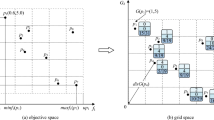
A clustering-based competitive particle swarm optimization with grid ranking for multi-objective optimization problems
Qianlin Ye, Zheng Wang, … Mengjiao Yu
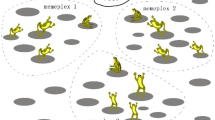
A modified shuffled frog leaping algorithm with inertia weight
Zhuanzhe Zhao, Mengxian Wang, … Zhibo Liu

Appropriate noise addition to metaheuristic algorithms can enhance their performance
Kwok Pui Choi, Enzio Hai Hong Kam, … Weng Kee Wong
Introduction
In the ever-changing society, new optimization problems arise every moment, and they are distributed in various fields, such as automation control 1 , statistical physics 2 , security prevention and temperature prediction 3 , artificial intelligence 4 , and telecommunication technology 5 . Faced with a constant stream of practical engineering optimization problems, traditional solution methods gradually lose their efficiency and convenience, making it more and more expensive to solve the problems. Therefore, researchers have developed many metaheuristic algorithms and successfully applied them to the solution of optimization problems. Among them, Particle swarm optimization (PSO) algorithm 6 is one of the most widely used swarm intelligence algorithms.
However, the basic PSO has a simple operating principle and solves problems with high efficiency and good computational performance, but it suffers from the disadvantages of easily trapping in local optima and premature convergence. To improve the overall performance of the particle swarm algorithm, an improved particle swarm optimization algorithm is proposed by the multiple hybrid strategy in this paper. The improved PSO incorporates the search ideas of other intelligent algorithms (DE, WOA), so the improved algorithm proposed in this paper is named NDWPSO. The main improvement schemes are divided into the following 4 points: Firstly, a strategy of elite opposition-based learning is introduced into the particle population position initialization. A high-quality initialization matrix of population position can improve the convergence speed of the algorithm. Secondly, a dynamic weight methodology is adopted for the acceleration coefficients by combining the iterative map and linearly transformed method. This method utilizes the chaotic nature of the mapping function, the fast convergence capability of the dynamic weighting scheme, and the time-varying property of the acceleration coefficients. Thus, the global search and local search of the algorithm are balanced and the global search speed of the population is improved. Thirdly, a determination mechanism is set up to detect whether the algorithm falls into a local optimum. When the algorithm is “premature”, the population resets 40% of the position information to overcome the local optimum. Finally, the spiral shrinking mechanism combined with the DE/best/2 position mutation is used in the later iteration, which further improves the solution accuracy.
The structure of the paper is given as follows: Sect. “ Particle swarm optimization (PSO) ” describes the principle of the particle swarm algorithm. Section “ Improved particle swarm optimization algorithm ” shows the detailed improvement strategy and a comparison experiment of inertia weight is set up for the proposed NDWPSO. Section “ Experiment and discussion ” includes the experimental and result discussion sections on the performance of the improved algorithm. Section “ Conclusions and future works ” summarizes the main findings of this study.
Literature review
This section reviews some metaheuristic algorithms and other improved PSO algorithms. A simple discussion about recently proposed research studies is given.
Metaheuristic algorithms
A series of metaheuristic algorithms have been proposed in recent years by using various innovative approaches. For instance, Lin et al. 7 proposed a novel artificial bee colony algorithm (ABCLGII) in 2018 and compared ABCLGII with other outstanding ABC variants on 52 frequently used test functions. Abed-alguni et al. 8 proposed an exploratory cuckoo search (ECS) algorithm in 2021 and carried out several experiments to investigate the performance of ECS by 14 benchmark functions. Brajević 9 presented a novel shuffle-based artificial bee colony (SB-ABC) algorithm for solving integer programming and minimax problems in 2021. The experiments are tested on 7 integer programming problems and 10 minimax problems. In 2022, Khan et al. 10 proposed a non-deterministic meta-heuristic algorithm called Non-linear Activated Beetle Antennae Search (NABAS) for a non-convex tax-aware portfolio selection problem. Brajević et al. 11 proposed a hybridization of the sine cosine algorithm (HSCA) in 2022 to solve 15 complex structural and mechanical engineering design optimization problems. Abed-Alguni et al. 12 proposed an improved Salp Swarm Algorithm (ISSA) in 2022 for single-objective continuous optimization problems. A set of 14 standard benchmark functions was used to evaluate the performance of ISSA. In 2023, Nadimi et al. 13 proposed a binary starling murmuration optimization (BSMO) to select the effective features from different important diseases. In the same year, Nadimi et al. 14 systematically reviewed the last 5 years' developments of WOA and made a critical analysis of those WOA variants. In 2024, Fatahi et al. 15 proposed an Improved Binary Quantum-based Avian Navigation Optimizer Algorithm (IBQANA) for the Feature Subset Selection problem in the medical area. Experimental evaluation on 12 medical datasets demonstrates that IBQANA outperforms 7 established algorithms. Abed-alguni et al. 16 proposed an Improved Binary DJaya Algorithm (IBJA) to solve the Feature Selection problem in 2024. The IBJA’s performance was compared against 4 ML classifiers and 10 efficient optimization algorithms.
Improved PSO algorithms
Many researchers have constantly proposed some improved PSO algorithms to solve engineering problems in different fields. For instance, Yeh 17 proposed an improved particle swarm algorithm, which combines a new self-boundary search and a bivariate update mechanism, to solve the reliability redundancy allocation problem (RRAP) problem. Solomon et al. 18 designed a collaborative multi-group particle swarm algorithm with high parallelism that was used to test the adaptability of Graphics Processing Units (GPUs) in distributed computing environments. Mukhopadhyay and Banerjee 19 proposed a chaotic multi-group particle swarm optimization (CMS-PSO) to estimate the unknown parameters of an autonomous chaotic laser system. Duan et al. 20 designed an improved particle swarm algorithm with nonlinear adjustment of inertia weights to improve the coupling accuracy between laser diodes and single-mode fibers. Sun et al. 21 proposed a particle swarm optimization algorithm combined with non-Gaussian stochastic distribution for the optimal design of wind turbine blades. Based on a multiple swarm scheme, Liu et al. 22 proposed an improved particle swarm optimization algorithm to predict the temperatures of steel billets for the reheating furnace. In 2022, Gad 23 analyzed the existing 2140 papers on Swarm Intelligence between 2017 and 2019 and pointed out that the PSO algorithm still needs further research. In general, the improved methods can be classified into four categories:
Adjusting the distribution of algorithm parameters. Feng et al. 24 used a nonlinear adaptive method on inertia weights to balance local and global search and introduced asynchronously varying acceleration coefficients.
Changing the updating formula of the particle swarm position. Both papers 25 and 26 used chaotic mapping functions to update the inertia weight parameters and combined them with a dynamic weighting strategy to update the particle swarm positions. This improved approach enables the particle swarm algorithm to be equipped with fast convergence of performance.
The initialization of the swarm. Alsaidy and Abbood proposed 27 a hybrid task scheduling algorithm that replaced the random initialization of the meta-heuristic algorithm with the heuristic algorithms MCT-PSO and LJFP-PSO.
Combining with other intelligent algorithms: Liu et al. 28 introduced the differential evolution (DE) algorithm into PSO to increase the particle swarm as diversity and reduce the probability of the population falling into local optimum.
Particle swarm optimization (PSO)
The particle swarm optimization algorithm is a population intelligence algorithm for solving continuous and discrete optimization problems. It originated from the social behavior of individuals in bird and fish flocks 6 . The core of the PSO algorithm is that an individual particle identifies potential solutions by flight in a defined constraint space adjusts its exploration direction to approach the global optimal solution based on the shared information among the group, and finally solves the optimization problem. Each particle \(i\) includes two attributes: velocity vector \({V}_{i}=\left[{v}_{i1},{v}_{i2},{v}_{i3},{...,v}_{ij},{...,v}_{iD},\right]\) and position vector \({X}_{i}=[{x}_{i1},{x}_{i2},{x}_{i3},...,{x}_{ij},...,{x}_{iD}]\) . The velocity vector is used to modify the motion path of the swarm; the position vector represents a potential solution for the optimization problem. Here, \(j=\mathrm{1,2},\dots ,D\) , \(D\) represents the dimension of the constraint space. The equations for updating the velocity and position of the particle swarm are shown in Eqs. ( 1 ) and ( 2 ).
Here \({Pbest}_{i}^{k}\) represents the previous optimal position of the particle \(i\) , and \({Gbest}\) is the optimal position discovered by the whole population. \(i=\mathrm{1,2},\dots ,n\) , \(n\) denotes the size of the particle swarm. \({c}_{1}\) and \({c}_{2}\) are the acceleration constants, which are used to adjust the search step of the particle 29 . \({r}_{1}\) and \({r}_{2}\) are two random uniform values distributed in the range \([\mathrm{0,1}]\) , which are used to improve the randomness of the particle search. \(\omega\) inertia weight parameter, which is used to adjust the scale of the search range of the particle swarm 30 . The basic PSO sets the inertia weight parameter as a time-varying parameter to balance global exploration and local seeking. The updated equation of the inertia weight parameter is given as follows:
where \({\omega }_{max}\) and \({\omega }_{min}\) represent the upper and lower limits of the range of inertia weight parameter. \(k\) and \(Mk\) are the current iteration and maximum iteration.
Improved particle swarm optimization algorithm
According to the no free lunch theory 31 , it is known that no algorithm can solve every practical problem with high quality and efficiency for increasingly complex and diverse optimization problems. In this section, several improvement strategies are proposed to improve the search efficiency and overcome this shortcoming of the basic PSO algorithm.
Improvement strategies
The optimization strategies of the improved PSO algorithm are shown as follows:
The inertia weight parameter is updated by an improved chaotic variables method instead of a linear decreasing strategy. Chaotic mapping performs the whole search at a higher speed and is more resistant to falling into local optimal than the probability-dependent random search 32 . However, the population may result in that particles can easily fly out of the global optimum boundary. To ensure that the population can converge to the global optimum, an improved Iterative mapping is adopted and shown as follows:
Here \({\omega }_{k}\) is the inertia weight parameter in the iteration \(k\) , \(b\) is the control parameter in the range \([\mathrm{0,1}]\) .
The acceleration coefficients are updated by the linear transformation. \({c}_{1}\) and \({c}_{2}\) represent the influential coefficients of the particles by their own and population information, respectively. To improve the search performance of the population, \({c}_{1}\) and \({c}_{2}\) are changed from fixed values to time-varying parameter parameters, that are updated by linear transformation with the number of iterations:
where \({c}_{max}\) and \({c}_{min}\) are the maximum and minimum values of acceleration coefficients, respectively.
The initialization scheme is determined by elite opposition-based learning . The high-quality initial population will accelerate the solution speed of the algorithm and improve the accuracy of the optimal solution. Thus, the elite backward learning strategy 33 is introduced to generate the position matrix of the initial population. Suppose the elite individual of the population is \({X}=[{x}_{1},{x}_{2},{x}_{3},...,{x}_{j},...,{x}_{D}]\) , and the elite opposition-based solution of \(X\) is \({X}_{o}=[{x}_{{\text{o}}1},{x}_{{\text{o}}2},{x}_{{\text{o}}3},...,{x}_{oj},...,{x}_{oD}]\) . The formula for the elite opposition-based solution is as follows:
where \({k}_{r}\) is the random value in the range \((\mathrm{0,1})\) . \({ux}_{oij}\) and \({lx}_{oij}\) are dynamic boundaries of the elite opposition-based solution in \(j\) dimensional variables. The advantage of dynamic boundary is to reduce the exploration space of particles, which is beneficial to the convergence of the algorithm. When the elite opposition-based solution is out of bounds, the out-of-bounds processing is performed. The equation is given as follows:
After calculating the fitness function values of the elite solution and the elite opposition-based solution, respectively, \(n\) high quality solutions were selected to form a new initial population position matrix.
The position updating Eq. ( 2 ) is modified based on the strategy of dynamic weight. To improve the speed of the global search of the population, the strategy of dynamic weight from the artificial bee colony algorithm 34 is introduced to enhance the computational performance. The new position updating equation is shown as follows:
Here \(\rho\) is the random value in the range \((\mathrm{0,1})\) . \(\psi\) represents the acceleration coefficient and \({\omega }{\prime}\) is the dynamic weight coefficient. The updated equations of the above parameters are as follows:
where \(f(i)\) denotes the fitness function value of individual particle \(i\) and u is the average of the population fitness function values in the current iteration. The Eqs. ( 11 , 12 ) are introduced into the position updating equation. And they can attract the particle towards positions of the best-so-far solution in the search space.
New local optimal jump-out strategy is added for escaping from the local optimal. When the value of the fitness function for the population optimal particles does not change in M iterations, the algorithm determines that the population falls into a local optimal. The scheme in which the population jumps out of the local optimum is to reset the position information of the 40% of individuals within the population, in other words, to randomly generate the position vector in the search space. M is set to 5% of the maximum number of iterations.
New spiral update search strategy is added after the local optimal jump-out strategy. Since the whale optimization algorithm (WOA) was good at exploring the local search space 35 , the spiral update search strategy in the WOA 36 is introduced to update the position of the particles after the swarm jumps out of local optimal. The equation for the spiral update is as follows:
Here \(D=\left|{x}_{i}\left(k\right)-Gbest\right|\) denotes the distance between the particle itself and the global optimal solution so far. \(B\) is the constant that defines the shape of the logarithmic spiral. \(l\) is the random value in \([-\mathrm{1,1}]\) . \(l\) represents the distance between the newly generated particle and the global optimal position, \(l=-1\) means the closest distance, while \(l=1\) means the farthest distance, and the meaning of this parameter can be directly observed by Fig. 1 .
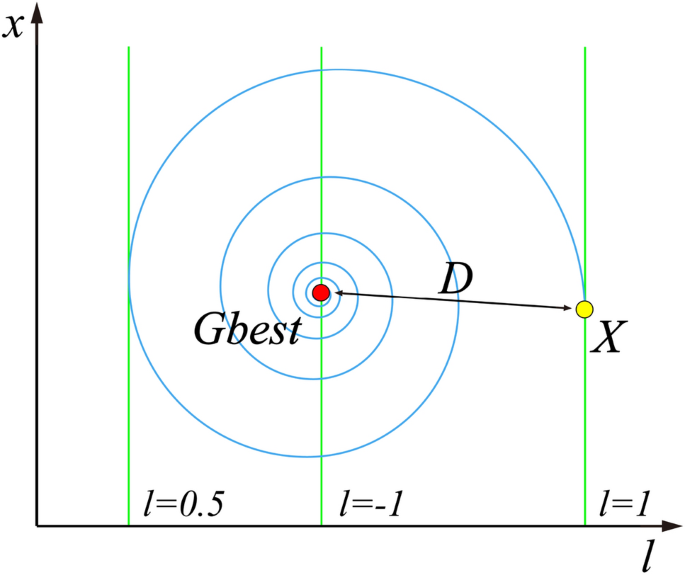
Spiral updating position.
The DE/best/2 mutation strategy is introduced to form the mutant particle. 4 individuals in the population are randomly selected that differ from the current particle, then the vector difference between them is rescaled, and the difference vector is combined with the global optimal position to form the mutant particle. The equation for mutation of particle position is shown as follows:
where \({x}^{*}\) is the mutated particle, \(F\) is the scale factor of mutation, \({r}_{1}\) , \({r}_{2}\) , \({r}_{3}\) , \({r}_{4}\) are random integer values in \((0,n]\) and not equal to \(i\) , respectively. Specific particles are selected for mutation with the screening conditions as follows:
where \(Cr\) represents the probability of mutation, \(rand\left(\mathrm{0,1}\right)\) is a random number in \(\left(\mathrm{0,1}\right)\) , and \({i}_{rand}\) is a random integer value in \((0,n]\) .
The improved PSO incorporates the search ideas of other intelligent algorithms (DE, WOA), so the improved algorithm proposed in this paper is named NDWPSO. The pseudo-code for the NDWPSO algorithm is given as follows:
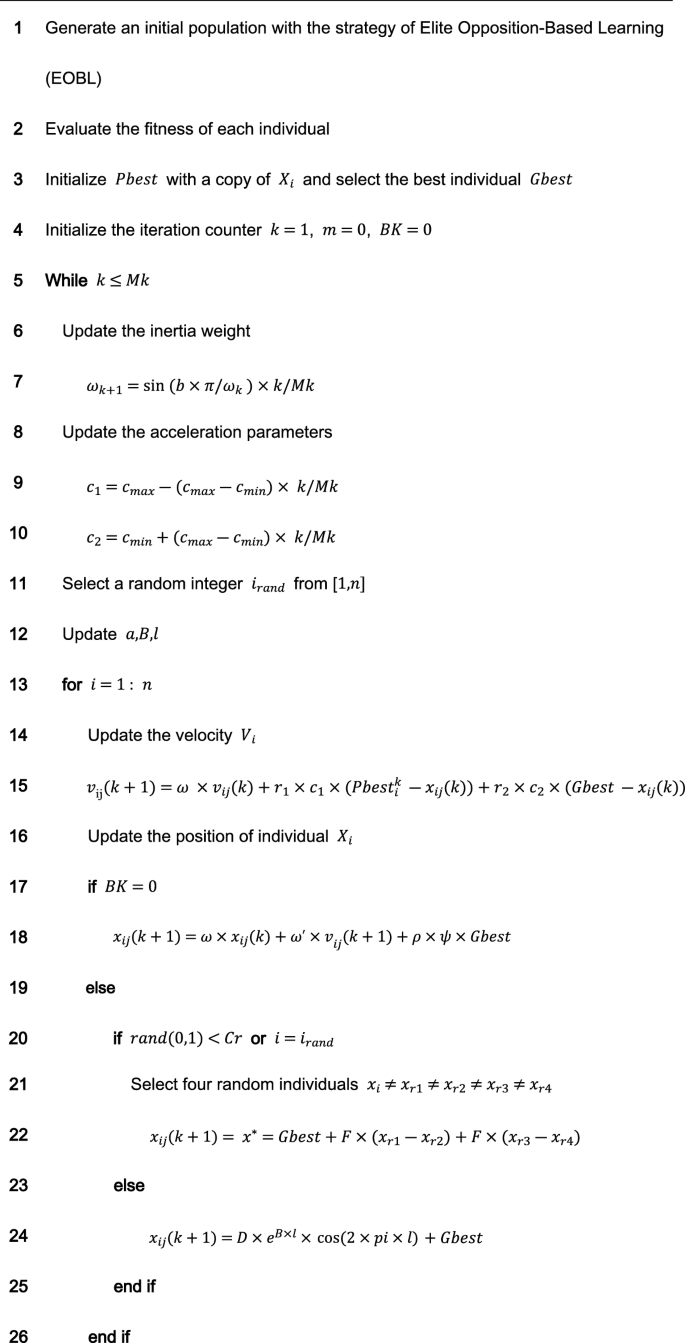
The main procedure of NDWPSO.
Comparing the distribution of inertia weight parameters
There are several improved PSO algorithms (such as CDWPSO 25 , and SDWPSO 26 ) that adopt the dynamic weighted particle position update strategy as their improvement strategy. The updated equations of the CDWPSO and the SDWPSO algorithm for the inertia weight parameters are given as follows:
where \({\text{A}}\) is a value in \((\mathrm{0,1}]\) . \({r}_{max}\) and \({r}_{min}\) are the upper and lower limits of the fluctuation range of the inertia weight parameters, \(k\) is the current number of algorithm iterations, and \(Mk\) denotes the maximum number of iterations.
Considering that the update method of inertia weight parameters by our proposed NDWPSO is comparable to the CDWPSO, and SDWPSO, a comparison experiment for the distribution of inertia weight parameters is set up in this section. The maximum number of iterations in the experiment is \(Mk=500\) . The distributions of CDWPSO, SDWPSO, and NDWPSO inertia weights are shown sequentially in Fig. 2 .

The inertial weight distribution of CDWPSO, SDWPSO, and NDWPSO.
In Fig. 2 , the inertia weight value of CDWPSO is a random value in (0,1]. It may make individual particles fly out of the range in the late iteration of the algorithm. Similarly, the inertia weight value of SDWPSO is a value that tends to zero infinitely, so that the swarm no longer can fly in the search space, making the algorithm extremely easy to fall into the local optimal value. On the other hand, the distribution of the inertia weights of the NDWPSO forms a gentle slope by two curves. Thus, the swarm can faster lock the global optimum range in the early iterations and locate the global optimal more precisely in the late iterations. The reason is that the inertia weight values between two adjacent iterations are inversely proportional to each other. Besides, the time-varying part of the inertial weight within NDWPSO is designed to reduce the chaos characteristic of the parameters. The inertia weight value of NDWPSO avoids the disadvantages of the above two schemes, so its design is more reasonable.
Experiment and discussion
In this section, three experiments are set up to evaluate the performance of NDWPSO: (1) the experiment of 23 classical functions 37 between NDWPSO and three particle swarm algorithms (PSO 6 , CDWPSO 25 , SDWPSO 26 ); (2) the experiment of benchmark test functions between NDWPSO and other intelligent algorithms (Whale Optimization Algorithm (WOA) 36 , Harris Hawk Algorithm (HHO) 38 , Gray Wolf Optimization Algorithm (GWO) 39 , Archimedes Algorithm (AOA) 40 , Equilibrium Optimizer (EO) 41 and Differential Evolution (DE) 42 ); (3) the experiment for solving three real engineering problems (welded beam design 43 , pressure vessel design 44 , and three-bar truss design 38 ). All experiments are run on a computer with Intel i5-11400F GPU, 2.60 GHz, 16 GB RAM, and the code is written with MATLAB R2017b.
The benchmark test functions are 23 classical functions, which consist of indefinite unimodal (F1–F7), indefinite dimensional multimodal functions (F8–F13), and fixed-dimensional multimodal functions (F14–F23). The unimodal benchmark function is used to evaluate the global search performance of different algorithms, while the multimodal benchmark function reflects the ability of the algorithm to escape from the local optimal. The mathematical equations of the benchmark functions are shown and found as Supplementary Tables S1 – S3 online.
Experiments on benchmark functions between NDWPSO, and other PSO variants
The purpose of the experiment is to show the performance advantages of the NDWPSO algorithm. Here, the dimensions and corresponding population sizes of 13 benchmark functions (7 unimodal and 6 multimodal) are set to (30, 40), (50, 70), and (100, 130). The population size of 10 fixed multimodal functions is set to 40. Each algorithm is repeated 30 times independently, and the maximum number of iterations is 200. The performance of the algorithm is measured by the mean and the standard deviation (SD) of the results for different benchmark functions. The parameters of the NDWPSO are set as: \({[{\omega }_{min},\omega }_{max}]=[\mathrm{0.4,0.9}]\) , \(\left[{c}_{max},{c}_{min}\right]=\left[\mathrm{2.5,1.5}\right],{V}_{max}=0.1,b={e}^{-50}, M=0.05\times Mk, B=1,F=0.7, Cr=0.9.\) And, \(A={\omega }_{max}\) for CDWPSO; \({[r}_{max},{r}_{min}]=[\mathrm{4,0}]\) for SDWPSO.
Besides, the experimental data are retained to two decimal places, but some experimental data will increase the number of retained data to pursue more accuracy in comparison. The best results in each group of experiments will be displayed in bold font. The experimental data is set to 0 if the value is below 10 –323 . The experimental parameter settings in this paper are different from the references (PSO 6 , CDWPSO 25 , SDWPSO 26 , so the final experimental data differ from the ones within the reference.
As shown in Tables 1 and 2 , the NDWPSO algorithm obtains better results for all 49 sets of data than other PSO variants, which include not only 13 indefinite-dimensional benchmark functions and 10 fixed-multimodal benchmark functions. Remarkably, the SDWPSO algorithm obtains the same accuracy of calculation as NDWPSO for both unimodal functions f 1 –f 4 and multimodal functions f 9 –f 11 . The solution accuracy of NDWPSO is higher than that of other PSO variants for fixed-multimodal benchmark functions f 14 -f 23 . The conclusion can be drawn that the NDWPSO has excellent global search capability, local search capability, and the capability for escaping the local optimal.
In addition, the convergence curves of the 23 benchmark functions are shown in Figs. 3 , 4 , 5 , 6 , 7 , 8 , 9 , 10 , 11 , 12 , 13 , 14 , 15 , 16 , 17 , 18 and 19 . The NDWPSO algorithm has a faster convergence speed in the early stage of the search for processing functions f1-f6, f8-f14, f16, f17, and finds the global optimal solution with a smaller number of iterations. In the remaining benchmark function experiments, the NDWPSO algorithm shows no outstanding performance for convergence speed in the early iterations. There are two reasons of no outstanding performance in the early iterations. On one hand, the fixed-multimodal benchmark function has many disturbances and local optimal solutions in the whole search space. on the other hand, the initialization scheme based on elite opposition-based learning is still stochastic, which leads to the initial position far from the global optimal solution. The inertia weight based on chaotic mapping and the strategy of spiral updating can significantly improve the convergence speed and computational accuracy of the algorithm in the late search stage. Finally, the NDWPSO algorithm can find better solutions than other algorithms in the middle and late stages of the search.
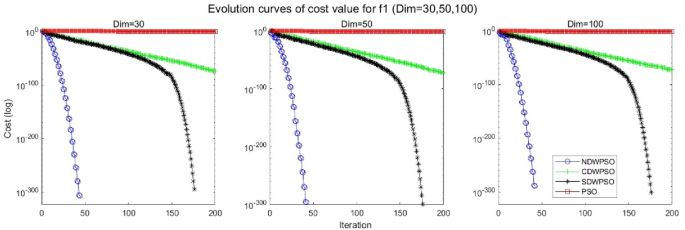
Evolution curve of NDWPSO and other PSO algorithms for f1 (Dim = 30,50,100).
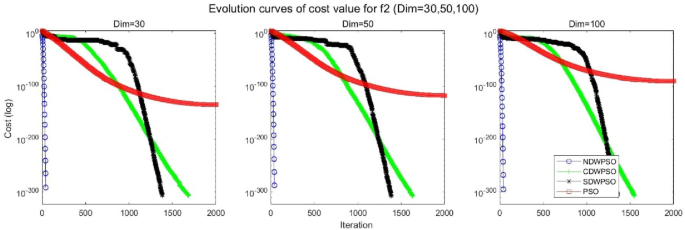
Evolution curve of NDWPSO and other PSO algorithms for f2 (Dim = 30,50,100).
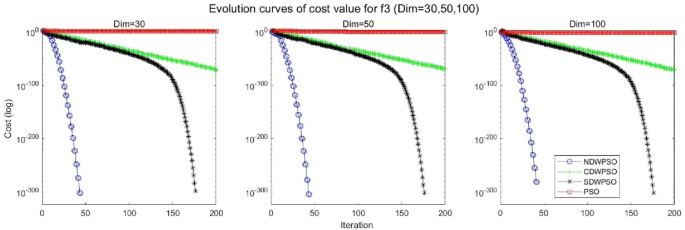
Evolution curve of NDWPSO and other PSO algorithms for f3 (Dim = 30,50,100).
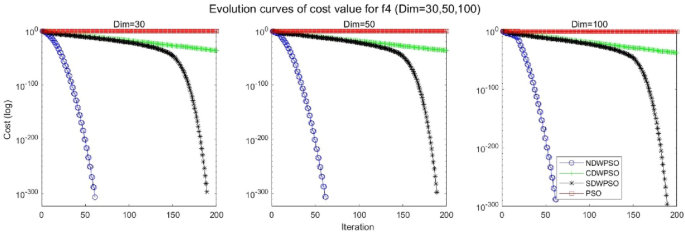
Evolution curve of NDWPSO and other PSO algorithms for f4 (Dim = 30,50,100).
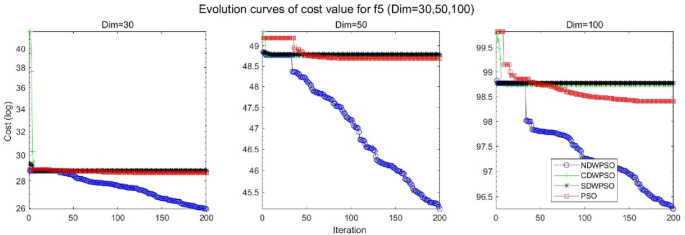
Evolution curve of NDWPSO and other PSO algorithms for f5 (Dim = 30,50,100).
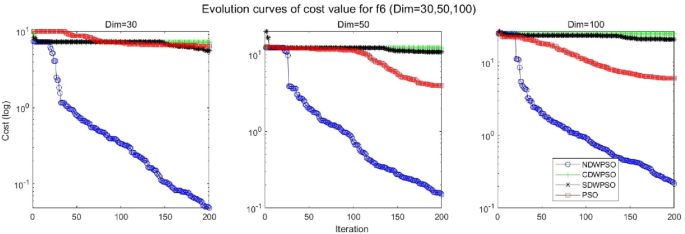
Evolution curve of NDWPSO and other PSO algorithms for f6 (Dim = 30,50,100).
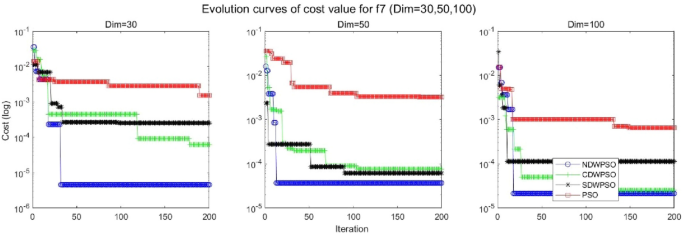
Evolution curve of NDWPSO and other PSO algorithms for f7 (Dim = 30,50,100).
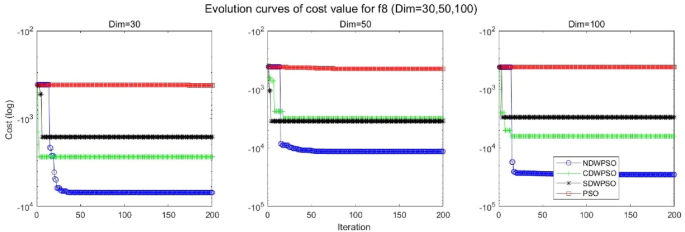
Evolution curve of NDWPSO and other PSO algorithms for f8 (Dim = 30,50,100).

Evolution curve of NDWPSO and other PSO algorithms for f9 (Dim = 30,50,100).
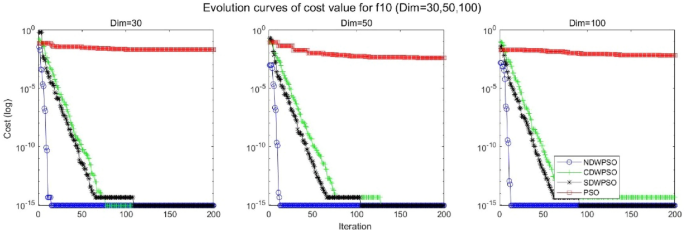
Evolution curve of NDWPSO and other PSO algorithms for f10 (Dim = 30,50,100).
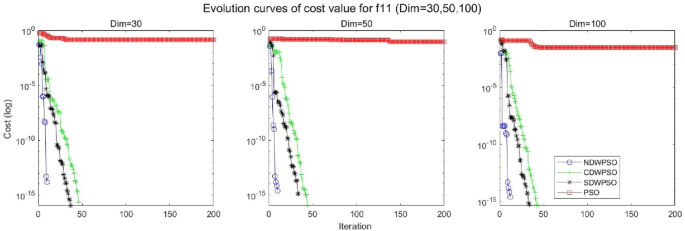
Evolution curve of NDWPSO and other PSO algorithms for f11(Dim = 30,50,100).
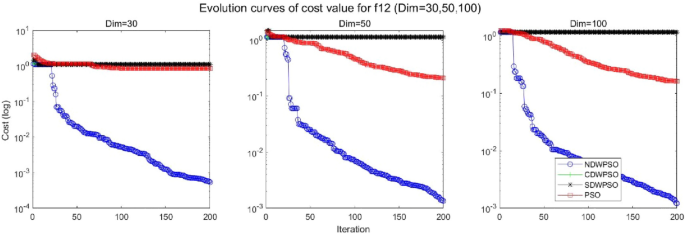
Evolution curve of NDWPSO and other PSO algorithms for f12 (Dim = 30,50,100).
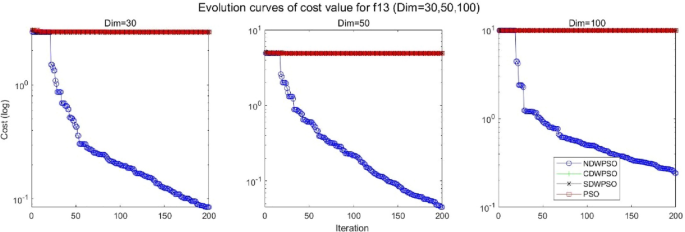
Evolution curve of NDWPSO and other PSO algorithms for f13 (Dim = 30,50,100).
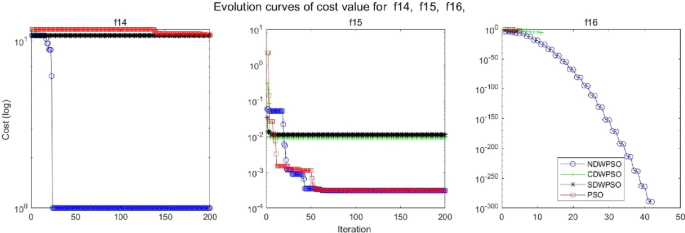
Evolution curve of NDWPSO and other PSO algorithms for f14, f15, f16.
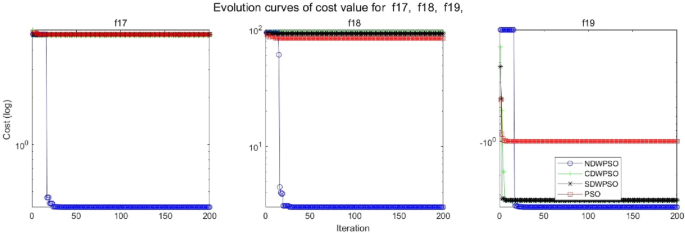
Evolution curve of NDWPSO and other PSO algorithms for f17, f18, f19.
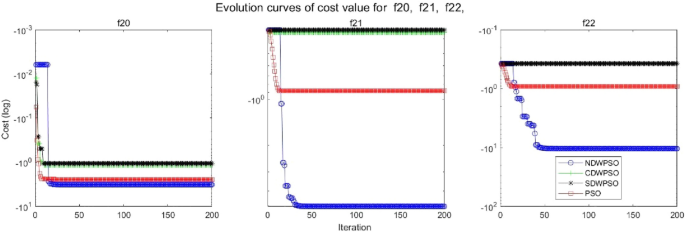
Evolution curve of NDWPSO and other PSO algorithms for f20, f21, f22.
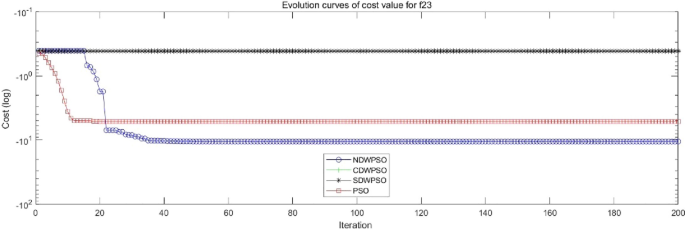
Evolution curve of NDWPSO and other PSO algorithms for f23.
To evaluate the performance of different PSO algorithms, a statistical test is conducted. Due to the stochastic nature of the meta-heuristics, it is not enough to compare algorithms based on only the mean and standard deviation values. The optimization results cannot be assumed to obey the normal distribution; thus, it is necessary to judge whether the results of the algorithms differ from each other in a statistically significant way. Here, the Wilcoxon non-parametric statistical test 45 is used to obtain a parameter called p -value to verify whether two sets of solutions are different to a statistically significant extent or not. Generally, it is considered that p ≤ 0.5 can be considered as a statistically significant superiority of the results. The p -values calculated in Wilcoxon’s rank-sum test comparing NDWPSO and other PSO algorithms are listed in Table 3 for all benchmark functions. The p -values in Table 3 additionally present the superiority of the NDWPSO because all of the p -values are much smaller than 0.5.
In general, the NDWPSO has the fastest convergence rate when finding the global optimum from Figs. 3 , 4 , 5 , 6 , 7 , 8 , 9 , 10 , 11 , 12 , 13 , 14 , 15 , 16 , 17 , 18 and 19 , and thus we can conclude that the NDWPSO is superior to the other PSO variants during the process of optimization.
Comparison experiments between NDWPSO and other intelligent algorithms
Experiments are conducted to compare NDWPSO with several other intelligent algorithms (WOA, HHO, GWO, AOA, EO and DE). The experimental object is 23 benchmark functions, and the experimental parameters of the NDWPSO algorithm are set the same as in Experiment 4.1. The maximum number of iterations of the experiment is increased to 2000 to fully demonstrate the performance of each algorithm. Each algorithm is repeated 30 times individually. The parameters of the relevant intelligent algorithms in the experiments are set as shown in Table 4 . To ensure the fairness of the algorithm comparison, all parameters are concerning the original parameters in the relevant algorithm literature. The experimental results are shown in Tables 5 , 6 , 7 and 8 and Figs. 20 , 21 , 22 , 23 , 24 , 25 , 26 , 27 , 28 , 29 , 30 , 31 , 32 , 33 , 34 , 35 and 36 .
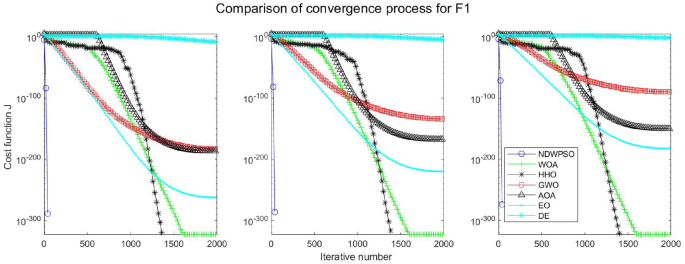
Evolution curve of NDWPSO and other algorithms for f1 (Dim = 30,50,100).

Evolution curve of NDWPSO and other algorithms for f2 (Dim = 30,50,100).
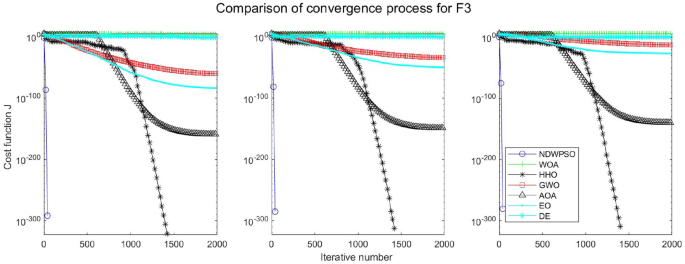
Evolution curve of NDWPSO and other algorithms for f3(Dim = 30,50,100).
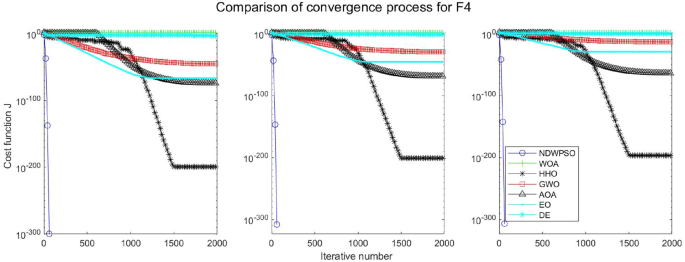
Evolution curve of NDWPSO and other algorithms for f4 (Dim = 30,50,100).
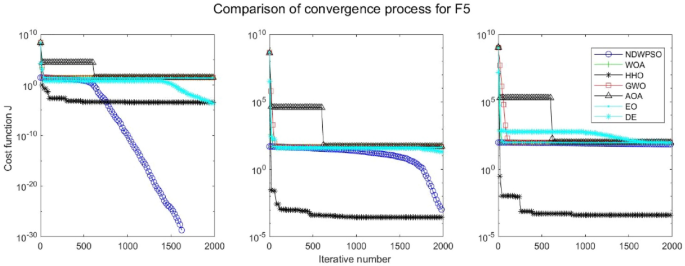
Evolution curve of NDWPSO and other algorithms for f5 (Dim = 30,50,100).
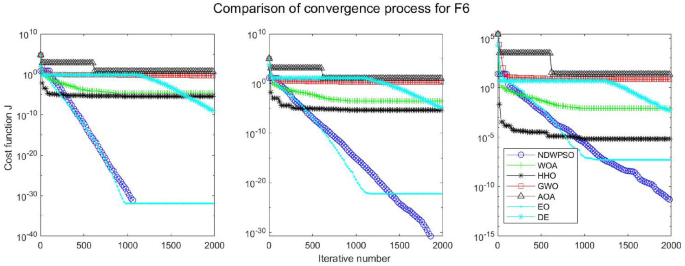
Evolution curve of NDWPSO and other algorithms for f6 (Dim = 30,50,100).
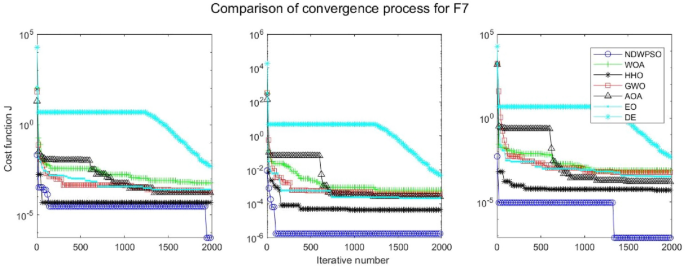
Evolution curve of NDWPSO and other algorithms for f7 (Dim = 30,50,100).
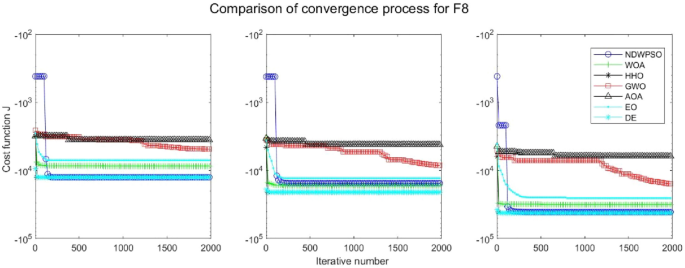
Evolution curve of NDWPSO and other algorithms for f8 (Dim = 30,50,100).
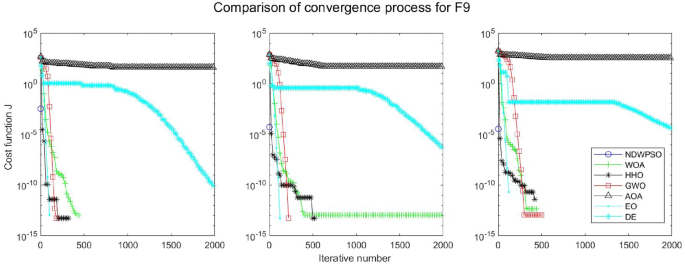
Evolution curve of NDWPSO and other algorithms for f9(Dim = 30,50,100).

Evolution curve of NDWPSO and other algorithms for f10 (Dim = 30,50,100).

Evolution curve of NDWPSO and other algorithms for f11 (Dim = 30,50,100).
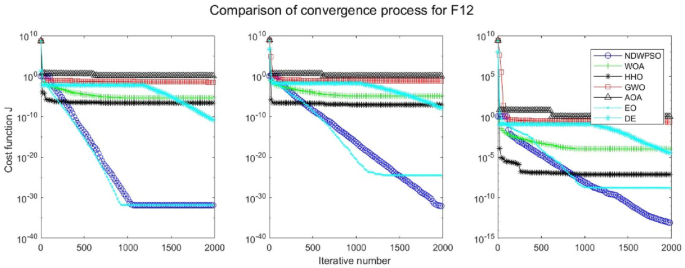
Evolution curve of NDWPSO and other algorithms for f12 (Dim = 30,50,100).
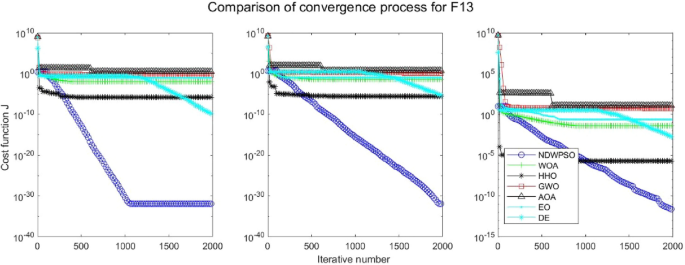
Evolution curve of NDWPSO and other algorithms for f13 (Dim = 30,50,100).

Evolution curve of NDWPSO and other algorithms for f14, f15, f16.
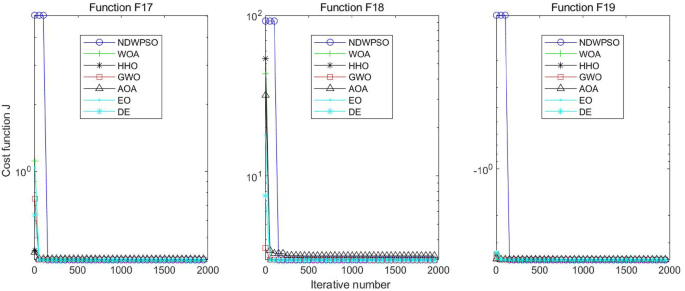
Evolution curve of NDWPSO and other algorithms for f17, f18, f19.

Evolution curve of NDWPSO and other algorithms for f20, f21, f22.
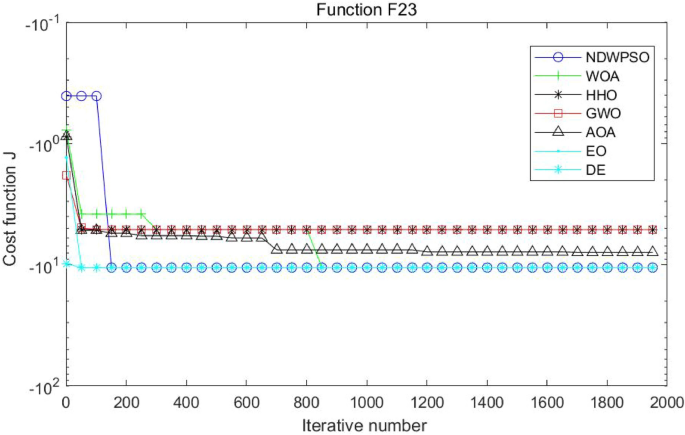
Evolution curve of NDWPSO and other algorithms for f23.
The experimental data of NDWPSO and other intelligent algorithms for handling 30, 50, and 100-dimensional benchmark functions ( \({f}_{1}-{f}_{13}\) ) are recorded in Tables 8 , 9 and 10 , respectively. The comparison data of fixed-multimodal benchmark tests ( \({f}_{14}-{f}_{23}\) ) are recorded in Table 11 . According to the data in Tables 5 , 6 and 7 , the NDWPSO algorithm obtains 69.2%, 84.6%, and 84.6% of the best results for the benchmark function ( \({f}_{1}-{f}_{13}\) ) in the search space of three dimensions (Dim = 30, 50, 100), respectively. In Table 8 , the NDWPSO algorithm obtains 80% of the optimal solutions in 10 fixed-multimodal benchmark functions.
The convergence curves of each algorithm are shown in Figs. 20 , 21 , 22 , 23 , 24 , 25 , 26 , 27 , 28 , 29 , 30 , 31 , 32 , 33 , 34 , 35 and 36 . The NDWPSO algorithm demonstrates two convergence behaviors when calculating the benchmark functions in 30, 50, and 100-dimensional search spaces. The first behavior is the fast convergence of NDWPSO with a small number of iterations at the beginning of the search. The reason is that the Iterative-mapping strategy and the position update scheme of dynamic weighting are used in the NDWPSO algorithm. This scheme can quickly target the region in the search space where the global optimum is located, and then precisely lock the optimal solution. When NDWPSO processes the functions \({f}_{1}-{f}_{4}\) , and \({f}_{9}-{f}_{11}\) , the behavior can be reflected in the convergence trend of their corresponding curves. The second behavior is that NDWPSO gradually improves the convergence accuracy and rapidly approaches the global optimal in the middle and late stages of the iteration. The NDWPSO algorithm fails to converge quickly in the early iterations, which is possible to prevent the swarm from falling into a local optimal. The behavior can be demonstrated by the convergence trend of the curves when NDWPSO handles the functions \({f}_{6}\) , \({f}_{12}\) , and \({f}_{13}\) , and it also shows that the NDWPSO algorithm has an excellent ability of local search.
Combining the experimental data with the convergence curves, it is concluded that the NDWPSO algorithm has a faster convergence speed, so the effectiveness and global convergence of the NDWPSO algorithm are more outstanding than other intelligent algorithms.
Experiments on classical engineering problems
Three constrained classical engineering design problems (welded beam design, pressure vessel design 43 , and three-bar truss design 38 ) are used to evaluate the NDWPSO algorithm. The experiments are the NDWPSO algorithm and 5 other intelligent algorithms (WOA 36 , HHO, GWO, AOA, EO 41 ). Each algorithm is provided with the maximum number of iterations and population size ( \({\text{Mk}}=500,\mathrm{ n}=40\) ), and then repeats 30 times, independently. The parameters of the algorithms are set the same as in Table 4 . The experimental results of three engineering design problems are recorded in Tables 9 , 10 and 11 in turn. The result data is the average value of the solved data.
Welded beam design
The target of the welded beam design problem is to find the optimal manufacturing cost for the welded beam with the constraints, as shown in Fig. 37 . The constraints are the thickness of the weld seam ( \({\text{h}}\) ), the length of the clamped bar ( \({\text{l}}\) ), the height of the bar ( \({\text{t}}\) ) and the thickness of the bar ( \({\text{b}}\) ). The mathematical formulation of the optimization problem is given as follows:

Welded beam design.
In Table 9 , the NDWPSO, GWO, and EO algorithms obtain the best optimal cost. Besides, the standard deviation (SD) of t NDWPSO is the lowest, which means it has very good results in solving the welded beam design problem.
Pressure vessel design
Kannan and Kramer 43 proposed the pressure vessel design problem as shown in Fig. 38 to minimize the total cost, including the cost of material, forming, and welding. There are four design optimized objects: the thickness of the shell \({T}_{s}\) ; the thickness of the head \({T}_{h}\) ; the inner radius \({\text{R}}\) ; the length of the cylindrical section without considering the head \({\text{L}}\) . The problem includes the objective function and constraints as follows:

Pressure vessel design.
The results in Table 10 show that the NDWPSO algorithm obtains the lowest optimal cost with the same constraints and has the lowest standard deviation compared with other algorithms, which again proves the good performance of NDWPSO in terms of solution accuracy.
Three-bar truss design
This structural design problem 44 is one of the most widely-used case studies as shown in Fig. 39 . There are two main design parameters: the area of the bar1 and 3 ( \({A}_{1}={A}_{3}\) ) and area of bar 2 ( \({A}_{2}\) ). The objective is to minimize the weight of the truss. This problem is subject to several constraints as well: stress, deflection, and buckling constraints. The problem is formulated as follows:
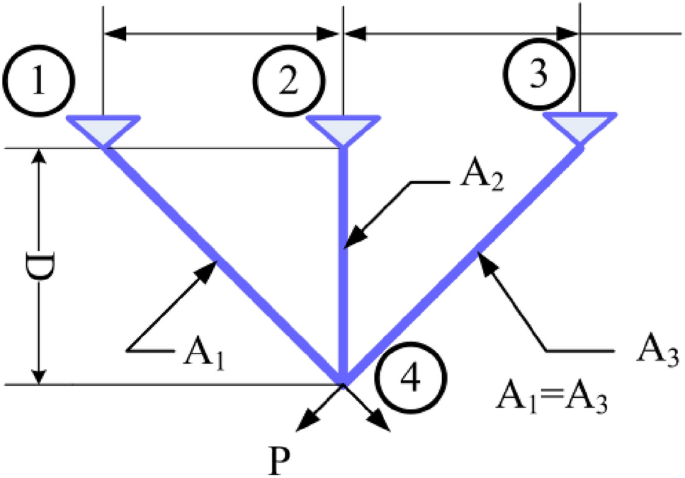
Three-bar truss design.
From Table 11 , NDWPSO obtains the best design solution in this engineering problem and has the smallest standard deviation of the result data. In summary, the NDWPSO can reveal very competitive results compared to other intelligent algorithms.
Conclusions and future works
An improved algorithm named NDWPSO is proposed to enhance the solving speed and improve the computational accuracy at the same time. The improved NDWPSO algorithm incorporates the search ideas of other intelligent algorithms (DE, WOA). Besides, we also proposed some new hybrid strategies to adjust the distribution of algorithm parameters (such as the inertia weight parameter, the acceleration coefficients, the initialization scheme, the position updating equation, and so on).
23 classical benchmark functions: indefinite unimodal (f1-f7), indefinite multimodal (f8-f13), and fixed-dimensional multimodal(f14-f23) are applied to evaluate the effective line and feasibility of the NDWPSO algorithm. Firstly, NDWPSO is compared with PSO, CDWPSO, and SDWPSO. The simulation results can prove the exploitative, exploratory, and local optima avoidance of NDWPSO. Secondly, the NDWPSO algorithm is compared with 5 other intelligent algorithms (WOA, HHO, GWO, AOA, EO). The NDWPSO algorithm also has better performance than other intelligent algorithms. Finally, 3 classical engineering problems are applied to prove that the NDWPSO algorithm shows superior results compared to other algorithms for the constrained engineering optimization problems.
Although the proposed NDWPSO is superior in many computation aspects, there are still some limitations and further improvements are needed. The NDWPSO performs a limit initialize on each particle by the strategy of “elite opposition-based learning”, it takes more computation time before speed update. Besides, the” local optimal jump-out” strategy also brings some random process. How to reduce the random process and how to improve the limit initialize efficiency are the issues that need to be further discussed. In addition, in future work, researchers will try to apply the NDWPSO algorithm to wider fields to solve more complex and diverse optimization problems.
Data availability
The datasets used and/or analyzed during the current study available from the corresponding author on reasonable request.
Sami, F. Optimize electric automation control using artificial intelligence (AI). Optik 271 , 170085 (2022).
Article ADS Google Scholar
Li, X. et al. Prediction of electricity consumption during epidemic period based on improved particle swarm optimization algorithm. Energy Rep. 8 , 437–446 (2022).
Article Google Scholar
Sun, B. Adaptive modified ant colony optimization algorithm for global temperature perception of the underground tunnel fire. Case Stud. Therm. Eng. 40 , 102500 (2022).
Bartsch, G. et al. Use of artificial intelligence and machine learning algorithms with gene expression profiling to predict recurrent nonmuscle invasive urothelial carcinoma of the bladder. J. Urol. 195 (2), 493–498 (2016).
Article PubMed Google Scholar
Bao, Z. Secure clustering strategy based on improved particle swarm optimization algorithm in internet of things. Comput. Intell. Neurosci. 2022 , 1–9 (2022).
Google Scholar
Kennedy, J. & Eberhart, R. Particle swarm optimization. In: Proceedings of ICNN'95-International Conference on Neural Networks . IEEE, 1942–1948 (1995).
Lin, Q. et al. A novel artificial bee colony algorithm with local and global information interaction. Appl. Soft Comput. 62 , 702–735 (2018).
Abed-alguni, B. H. et al. Exploratory cuckoo search for solving single-objective optimization problems. Soft Comput. 25 (15), 10167–10180 (2021).
Brajević, I. A shuffle-based artificial bee colony algorithm for solving integer programming and minimax problems. Mathematics 9 (11), 1211 (2021).
Khan, A. T. et al. Non-linear activated beetle antennae search: A novel technique for non-convex tax-aware portfolio optimization problem. Expert Syst. Appl. 197 , 116631 (2022).
Brajević, I. et al. Hybrid sine cosine algorithm for solving engineering optimization problems. Mathematics 10 (23), 4555 (2022).
Abed-Alguni, B. H., Paul, D. & Hammad, R. Improved Salp swarm algorithm for solving single-objective continuous optimization problems. Appl. Intell. 52 (15), 17217–17236 (2022).
Nadimi-Shahraki, M. H. et al. Binary starling murmuration optimizer algorithm to select effective features from medical data. Appl. Sci. 13 (1), 564 (2022).
Nadimi-Shahraki, M. H. et al. A systematic review of the whale optimization algorithm: Theoretical foundation, improvements, and hybridizations. Archiv. Comput. Methods Eng. 30 (7), 4113–4159 (2023).
Fatahi, A., Nadimi-Shahraki, M. H. & Zamani, H. An improved binary quantum-based avian navigation optimizer algorithm to select effective feature subset from medical data: A COVID-19 case study. J. Bionic Eng. 21 (1), 426–446 (2024).
Abed-alguni, B. H. & AL-Jarah, S. H. IBJA: An improved binary DJaya algorithm for feature selection. J. Comput. Sci. 75 , 102201 (2024).
Yeh, W.-C. A novel boundary swarm optimization method for reliability redundancy allocation problems. Reliab. Eng. Syst. Saf. 192 , 106060 (2019).
Solomon, S., Thulasiraman, P. & Thulasiram, R. Collaborative multi-swarm PSO for task matching using graphics processing units. In: Proceedings of the 13th Annual Conference on Genetic and Evolutionary Computation 1563–1570 (2011).
Mukhopadhyay, S. & Banerjee, S. Global optimization of an optical chaotic system by chaotic multi swarm particle swarm optimization. Expert Syst. Appl. 39 (1), 917–924 (2012).
Duan, L. et al. Improved particle swarm optimization algorithm for enhanced coupling of coaxial optical communication laser. Opt. Fiber Technol. 64 , 102559 (2021).
Sun, F., Xu, Z. & Zhang, D. Optimization design of wind turbine blade based on an improved particle swarm optimization algorithm combined with non-gaussian distribution. Adv. Civ. Eng. 2021 , 1–9 (2021).
Liu, M. et al. An improved particle-swarm-optimization algorithm for a prediction model of steel slab temperature. Appl. Sci. 12 (22), 11550 (2022).
Article MathSciNet CAS Google Scholar
Gad, A. G. Particle swarm optimization algorithm and its applications: A systematic review. Archiv. Comput. Methods Eng. 29 (5), 2531–2561 (2022).
Article MathSciNet Google Scholar
Feng, H. et al. Trajectory control of electro-hydraulic position servo system using improved PSO-PID controller. Autom. Constr. 127 , 103722 (2021).
Chen, Ke., Zhou, F. & Liu, A. Chaotic dynamic weight particle swarm optimization for numerical function optimization. Knowl. Based Syst. 139 , 23–40 (2018).
Bai, B. et al. Reliability prediction-based improved dynamic weight particle swarm optimization and back propagation neural network in engineering systems. Expert Syst. Appl. 177 , 114952 (2021).
Alsaidy, S. A., Abbood, A. D. & Sahib, M. A. Heuristic initialization of PSO task scheduling algorithm in cloud computing. J. King Saud Univ. –Comput. Inf. Sci. 34 (6), 2370–2382 (2022).
Liu, H., Cai, Z. & Wang, Y. Hybridizing particle swarm optimization with differential evolution for constrained numerical and engineering optimization. Appl. Soft Comput. 10 (2), 629–640 (2010).
Deng, W. et al. A novel intelligent diagnosis method using optimal LS-SVM with improved PSO algorithm. Soft Comput. 23 , 2445–2462 (2019).
Huang, M. & Zhen, L. Research on mechanical fault prediction method based on multifeature fusion of vibration sensing data. Sensors 20 (1), 6 (2019).
Article ADS PubMed PubMed Central Google Scholar
Wolpert, D. H. & Macready, W. G. No free lunch theorems for optimization. IEEE Trans. Evol. Comput. 1 (1), 67–82 (1997).
Gandomi, A. H. et al. Firefly algorithm with chaos. Commun. Nonlinear Sci. Numer. Simul. 18 (1), 89–98 (2013).
Article ADS MathSciNet Google Scholar
Zhou, Y., Wang, R. & Luo, Q. Elite opposition-based flower pollination algorithm. Neurocomputing 188 , 294–310 (2016).
Li, G., Niu, P. & Xiao, X. Development and investigation of efficient artificial bee colony algorithm for numerical function optimization. Appl. Soft Comput. 12 (1), 320–332 (2012).
Xiong, G. et al. Parameter extraction of solar photovoltaic models by means of a hybrid differential evolution with whale optimization algorithm. Solar Energy 176 , 742–761 (2018).
Mirjalili, S. & Lewis, A. The whale optimization algorithm. Adv. Eng. Softw. 95 , 51–67 (2016).
Yao, X., Liu, Y. & Lin, G. Evolutionary programming made faster. IEEE Trans. Evol. Comput. 3 (2), 82–102 (1999).
Heidari, A. A. et al. Harris hawks optimization: Algorithm and applications. Fut. Gener. Comput. Syst. 97 , 849–872 (2019).
Mirjalili, S., Mirjalili, S. M. & Lewis, A. Grey wolf optimizer. Adv. Eng. Softw. 69 , 46–61 (2014).
Hashim, F. A. et al. Archimedes optimization algorithm: A new metaheuristic algorithm for solving optimization problems. Appl. Intell. 51 , 1531–1551 (2021).
Faramarzi, A. et al. Equilibrium optimizer: A novel optimization algorithm. Knowl. -Based Syst. 191 , 105190 (2020).
Pant, M. et al. Differential evolution: A review of more than two decades of research. Eng. Appl. Artif. Intell. 90 , 103479 (2020).
Coello, C. A. C. Use of a self-adaptive penalty approach for engineering optimization problems. Comput. Ind. 41 (2), 113–127 (2000).
Kannan, B. K. & Kramer, S. N. An augmented lagrange multiplier based method for mixed integer discrete continuous optimization and its applications to mechanical design. J. Mech. Des. 116 , 405–411 (1994).
Derrac, J. et al. A practical tutorial on the use of nonparametric statistical tests as a methodology for comparing evolutionary and swarm intelligence algorithms. Swarm Evol. Comput. 1 (1), 3–18 (2011).
Download references
Acknowledgements
This work was supported by Key R&D plan of Shandong Province, China (2021CXGC010207, 2023CXGC01020); First batch of talent research projects of Qilu University of Technology in 2023 (2023RCKY116); Introduction of urgently needed talent projects in Key Supported Regions of Shandong Province; Key Projects of Natural Science Foundation of Shandong Province (ZR2020ME116); the Innovation Ability Improvement Project for Technology-based Small- and Medium-sized Enterprises of Shandong Province (2022TSGC2051, 2023TSGC0024, 2023TSGC0931); National Key R&D Program of China (2019YFB1705002), LiaoNing Revitalization Talents Program (XLYC2002041) and Young Innovative Talents Introduction & Cultivation Program for Colleges and Universities of Shandong Province (Granted by Department of Education of Shandong Province, Sub-Title: Innovative Research Team of High Performance Integrated Device).
Author information
Authors and affiliations.
School of Mechanical and Automotive Engineering, Qilu University of Technology (Shandong Academy of Sciences), Jinan, 250353, China
Jinwei Qiao, Guangyuan Wang, Zhi Yang, Jun Chen & Pengbo Liu
Shandong Institute of Mechanical Design and Research, Jinan, 250353, China
School of Information Science and Engineering, Northeastern University, Shenyang, 110819, China
Xiaochuan Luo
Fushun Supervision Inspection Institute for Special Equipment, Fushun, 113000, China
You can also search for this author in PubMed Google Scholar
Contributions
Z.Y., J.Q., and G.W. wrote the main manuscript text and prepared all figures and tables. J.C., P.L., K.L., and X.L. were responsible for the data curation and software. All authors reviewed the manuscript.
Corresponding author
Correspondence to Zhi Yang .
Ethics declarations
Competing interests.
The authors declare no competing interests.
Additional information
Publisher's note.
Springer Nature remains neutral with regard to jurisdictional claims in published maps and institutional affiliations.
Supplementary Information
Supplementary information., rights and permissions.
Open Access This article is licensed under a Creative Commons Attribution 4.0 International License, which permits use, sharing, adaptation, distribution and reproduction in any medium or format, as long as you give appropriate credit to the original author(s) and the source, provide a link to the Creative Commons licence, and indicate if changes were made. The images or other third party material in this article are included in the article's Creative Commons licence, unless indicated otherwise in a credit line to the material. If material is not included in the article's Creative Commons licence and your intended use is not permitted by statutory regulation or exceeds the permitted use, you will need to obtain permission directly from the copyright holder. To view a copy of this licence, visit http://creativecommons.org/licenses/by/4.0/ .
Reprints and permissions
About this article
Cite this article.
Qiao, J., Wang, G., Yang, Z. et al. A hybrid particle swarm optimization algorithm for solving engineering problem. Sci Rep 14 , 8357 (2024). https://doi.org/10.1038/s41598-024-59034-2
Download citation
Received : 11 January 2024
Accepted : 05 April 2024
Published : 10 April 2024
DOI : https://doi.org/10.1038/s41598-024-59034-2
Share this article
Anyone you share the following link with will be able to read this content:
Sorry, a shareable link is not currently available for this article.
Provided by the Springer Nature SharedIt content-sharing initiative
- Particle swarm optimization
- Elite opposition-based learning
- Iterative mapping
- Convergence analysis
By submitting a comment you agree to abide by our Terms and Community Guidelines . If you find something abusive or that does not comply with our terms or guidelines please flag it as inappropriate.
Quick links
- Explore articles by subject
- Guide to authors
- Editorial policies
Sign up for the Nature Briefing: AI and Robotics newsletter — what matters in AI and robotics research, free to your inbox weekly.

IMAGES
VIDEO
COMMENTS
A Math Word Problem Framework That Fosters Conceptual Thinking. This strategy for selecting and teaching word problems guides students to develop their understanding of math concepts. Word problems in mathematics are a powerful tool for helping students make sense of and reason with mathematical concepts. Many students, however, struggle with ...
Here are the seven strategies I use to help students solve word problems. 1. Read the Entire Word Problem. Before students look for keywords and try to figure out what to do, they need to slow down a bit and read the whole word problem once (and even better, twice). This helps kids get the bigger picture to be able to understand it a little ...
A Guide on Steps to Solving Word Problems: 10 Strategies. 1. Understand the Problem by Paraphrasing. One of the first steps in tackling a math word problem is to make sure your students understand what the problem is asking. Encourage them to paraphrase the problem in their own words.
Word problems are no different. Even if you have struggled with word problems in the past, you have acquired many new math skills that will help you succeed now! Use a Problem-Solving Strategy for Word Problems. In earlier chapters, you translated word phrases into algebraic expressions, using some basic mathematical vocabulary and symbols.
Even if you know the answer right away, using algebra will better prepare you to solve problems that do not have obvious answers. Write the equation. 18= 1 2p 18 = 1 2 p. Multiply both sides by 2. 2⋅18=2⋅ 1 2p 2 ⋅ 18 = 2 ⋅ 1 2 p. Simplify. 36=p 36 = p. Step 6. Check the answer in the problem and make sure it makes sense.
Simple breathing exercises or short mindfulness sessions before tackling math problems create a conducive mental state for effective problem-solving. Research suggests that a calm and focused mind enhances cognitive abilities and analytical thinking. An experienced educator will also be able to assess for any missing gaps in foundational math ...
Word problems are no different. Even if you have struggled with word problems in the past, you have acquired many new math skills that will help you succeed now! Use a Problem-solving Strategy for Word Problems. In earlier chapters, you translated word phrases into algebraic expressions, using some basic mathematical vocabulary and symbols.
Schema-Based Instruction. Of all the word problem strategies out there, schema-based instruction is the one with the most research backing it. Schema-based instruction (or SBI) involves categorizing word problems into particular types, or schemas, which will help you determine how to solve the problem.. Schemas can be additive or multiplicative.
Use a Problem-Solving Strategy for Word Problems. We have reviewed translating English phrases into algebraic expressions, using some basic mathematical vocabulary and symbols. We have also translated English sentences into algebraic equations and solved some word problems. The word problems applied math to everyday situations.
Step 3: Underline the question. Step three is all about underlining the question and making sure students truly understand it. Challenge them to rephrase the question in their own words. This step is vital for selecting the correct operation and solving the problem effectively.
Word Problem Solving Strategy #1: Numberless Word Problems. Who is this strategy for? If your students are struggling to understand the action, context or question in a story problem, discussion and numberless word problems will be a word problem-solving strategy that can help your students tremendously!
To help your students master this strategy and become skillful at solving math word problems, I've got a few recommendations for you: Devote Dedicated Time: Set aside a chunk of your math block specifically for problem-solving, around 10-15 minutes. For real proficiency, students need daily chances to dive into problem-solving, tackling at ...
5 Strategies to Learn to Solve Math Word Problems. A critical step in math fluency is the ability to solve math word problems. The funny thing about solving math word problems is that it isn't just about math. Students need to have strong reading skills as well as the growth mindset needed for problem-solving.
Step-by-Step Guide to Using the CUBES Strategy. Implementing the CUBES strategy means teaching students the key steps and working through a gradual release process until they can effectively do this themselves. This systematic approach helps students understand the problem and empowers them to tackle word problems with confidence.
How big of a turkey do I need to buy?". Yet, inside the classroom, how to solve word problems can leave students and teachers scratching their heads. During this on-demand webinar, Dr. Sarah R. Powell will share: Two ineffective word-problem practices and why not to use them. The importance of an attack strategy when working through word ...
Use a Problem-Solving Strategy to Solve Word Problems. Step 1. Read the problem. Make sure all the words and ideas are understood. Step 2. Identify what we are looking for. Step 3. Name what we are looking for. Choose a variable to represent that quantity. Step 4. Translate into an equation. It may be helpful to restate the problem in one ...
A multi-step word problem, also known as a two-step word problem or two-step equation word problem, is a math situation that involves more than one equation having to be answered in order to solve the ultimate question. This requires students to apply their problem solving skills to determine which operation or operations to use to tackle the ...
The one word problem strategy you need to try. My favorite strategy for teaching word problems is called Read 3 Ways. It's fantastic because: You can use it with any word problem. You can use it with any grade level or skill level. It's a fantastic support for language learners. It provides extra challenge for your advanced students.
It's called P.S.A and I want to introduce this three-step strategy to you! The P.S.A strategy is a simple way to solve word problems without causing too much of a headache or unnecessary frustration. It involves three steps. P = Identify the problem. S = Solve the problem.
Word problems are no different. Even if you have struggled with word problems in the past, you have acquired many new math skills that will help you succeed now! Use a Problem-Solving Strategy for Word Problems In earlier chapters, you translated word phrases into algebraic expressions, using some basic mathematical vocabulary and symbols.
Considering the difficulties students face when solving word problems, a paucity of studies (e.g., Brack, 2020) has recommended a potential mnemonic problem-solving strategy that fosters deep knowledge and skills in solving word problems.This study examines the effectiveness of the KNOWS strategy (K—Know, N—Need to know, O—Organize, W—Work, and S—Solution) as a mnemonic approach in ...
3 Problem Solving Strategies. The solution is to conquer math word problems with engaging classroom strategies that counteract the above issues! 1. Teach a Problem-Solving Routine. Kids (and adults) are notoriously impulsive problem solvers. Many students see a word problem and want to immediately snatch out those numbers and "do something ...
How To Use a Problem Solving Strategy for Word Problems. Read the problem. Make sure all the words and ideas are understood. Identify what you are looking for. Name what you are looking for. Choose a variable to represent that quantity. Translate into an equation. It may be helpful to restate the problem in one sentence with all the important ...
Adapting the Math Language. Use the active voice: The passive voice can obscure what is actually happening in a word problem. Use the active voice to show people engaging with the world. For instance, rather than "The ball was thrown by the girl," revise the sentence structure to "The girl threw the ball.".
Solving algebra-based word problems doesn't have to be difficult. This article explains the key ideas behind elementary algebra and then offers 20 sample word problems (with solutions) to help you practice. ... When working on an algebra problem, it's important to understand how an equation is set up. An equation is a statement that asserts ...
Answering mathematical problems by model inference based on text is a very important natural language understanding task that has received increasing attention from researchers [1], [2], [3], [4].A typical math word problem (MWP) is a concise description of a problem that involves converting real-world problems described in natural language into mathematical symbols or equations, and obtaining ...
The particle swarm optimization algorithm is a population intelligence algorithm for solving continuous and discrete optimization problems. It originated from the social behavior of individuals in ...